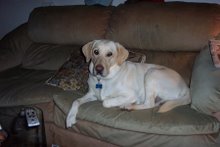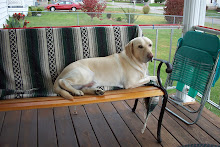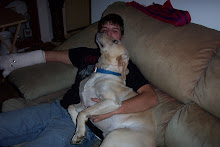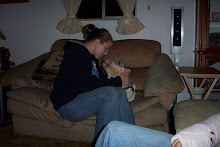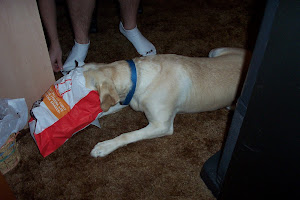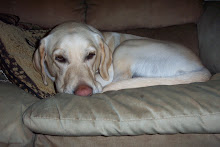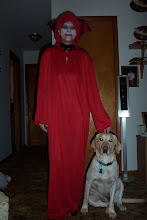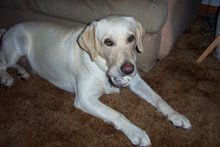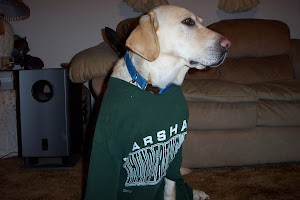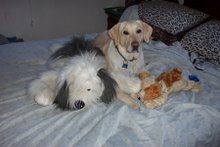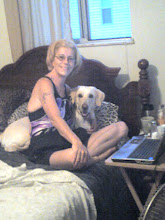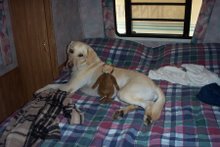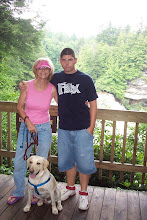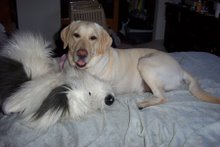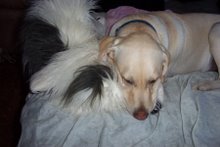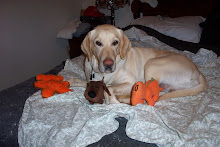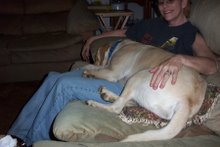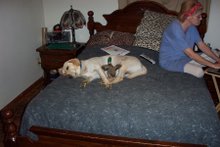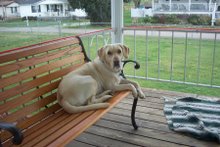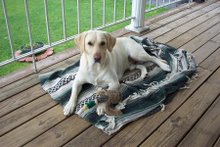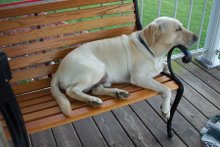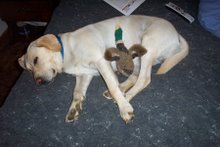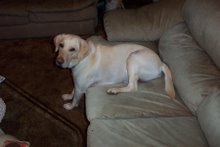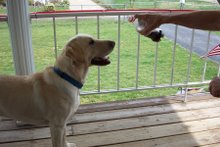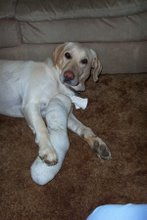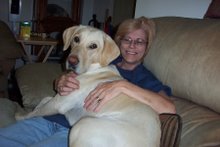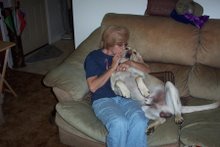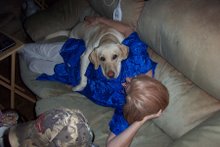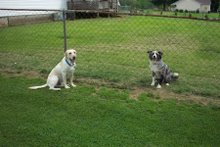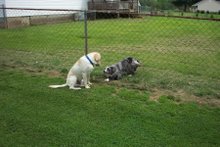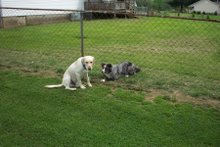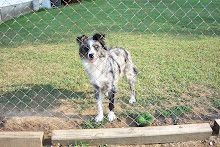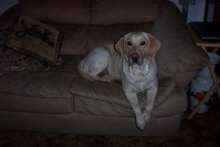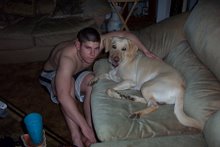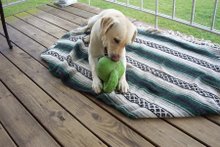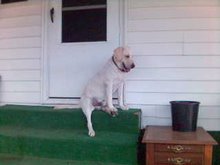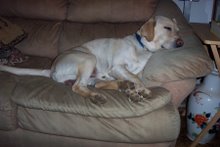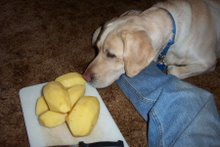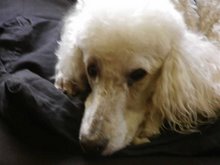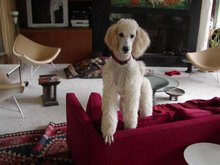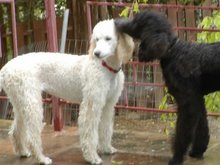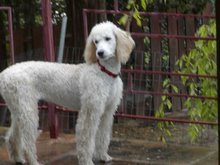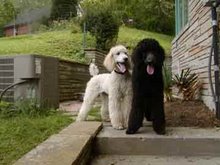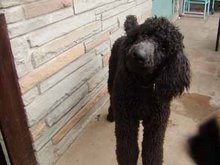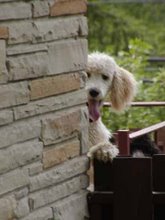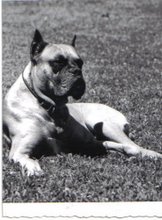If both parents are A.K.C. there is no reason NOT to register the puppies. CKC stands for Continental Kennel Club. It also stands for Canadian Kennel Club. Now the Canadian Kennel Club is an excellent registry and it works just like A.K.C. does. But Continental Kennel Club in Walker, Louisiana, also calls itself the CKC. And most dogs that are registered with CKC in the U.S. are registered with Continental Kennel Club. Now, just think about a registry that would use call letters that are identical to another well know registry. Think about that for a while. With CKC they do not require that dogs be DNA tested, so you don't know if the pups come from the parents the breeder says or not. With A.K.C. you know for sure because there is DNA testing. A.K.C. implemented the Frequent Sire Program in 2003. This requires a breeder to DNA test their sires if that sire has more than 3 litters within a calendar year. Before 2003, they (A.K.C.) only required the breeder to test the sire after the 6th litter. With A.K.C. you can't pick up a dog on the side of the road and register it. With CKC you can. With A.K.C. you can't breed a Great Dane to Doberman and call it a new breed; i. e. the Great Doberman, and you can do this with CKC. See there is a big difference. Many times when people can't get dogs registered by A.K.C. they go to CKC. because CKC is so loose with their rules. So the puppy you are buying might grow up to look like the parents or it might not. It might grow up to be as big as a whippet or have ears that stand straight up, etc. And people that don't breed, don't know what puppies are supposed to look like so they can be fooled. They see a cute puppy and they buy it, but when it is grown it doesn't look like the breed it is supposed to be or it is too big. If the breeder has papers on both parents there is no reason the breeder should not register it with A.K.C., because the overwhelming majority of breeders in the U.S. would rather all their dogs be A.K.C. registered. The reason some of these new registries are popping up is because some years back A.K.C. required breeders to DNA their dogs. It is a rule. So if you buy a puppy from an A.K.C. breeder and the puppy doesn't turn out to look like an Italian Greyhound, you can contact the A.K.C. And then they will DNA your puppy and if it doesn't match the DNA records they have on the parents of the puppy the breeder will NO longer be able to register with A.K.C. at all. Now, there are some people who can NO longer register with A.K.C. because they have committed fraudulent actions with their breeding and registry records, and when A.K.C. catches them they can NO longer register their dogs with A.K.C. at all. And just remember a registry is what it says. It registers dogs. I can become a registry today. All I have to do is start a website and call myself the World Canine Registry (and there might already be one called that, there are so many out there these days), advertise how much it costs to register dogs and people will start registering with me. Even if I don't keep good records or have rules that are so lax that there aren't any rules at all. Because all some people care about are PAPERS. Many people don't know what papers mean. Many people just want to be able to say "MY DOG HAS PAPERS!!!!!". Registration papers mean a lot. They mean that for 8 generations or more an IG(Italian Greyhound) was bred to an IG (Italian Greyhound), so what you have is an IG (Italian Greyhound.) With an A.K.C. registered IG (Italian Greyhound), you can go back many, many generations to see the lineage of the puppy you buy. That is what a good registry does. It registers dogs for years and years. And it doesn't allow dogs that someone says is a Cocker Spaniel be registered as a Cocker Spaniel just because the owner says that is what it is. So, the only registry in the USA that stands behind it's papers scientifically with DNA is A.K.C. The registry with the best and longest reputation in the USA is A.K.C. The registry that offers the most for the pet owner, breeder, show dog, obedience dog, tracking dog, fly ball dog, etc. etc. etc. is A.K.C. And it has been that way for years. When puppies are cheaper than everyone elses there is usually a problem. Buying the cheapest puppy is never a good idea. Do not buy from anyone that advertises on the Internet, or buy from a pet shop such as Petland in So. Point, OH. They order their dogs. I know this because I called and talked to the manager and was told this personally. This is usually indicative of a puppy mill. Always, always ask if the parents are on site. If not, then don't buy. If only one parent is on site, ask where the other one is being housed and go see it. Always ask to see the registration papers on both parents, and ask the breeder to show you the grandparents lineage too.
I have done more research on this subject. I spoke to a representative of A.K.C. and asked questions about the CKC. I was told that this registry is valid, but does not have the strict breeding regulations that A.K.C. does. I was informed that this does not mean they are fake, just not as good as A.K.C. There is a good chance that the dog you are buying that is registered by this agency will have health concerns. The representative told me that there have been a rash of registries showing up across the nation. To be sure that the dog you are buying has no health issues, make sure that the puppy has been vet checked by the breeder, and then take the dog to your vet to have a thorough check-up. The CKC(Continental Kennel Club) just requires a person to send a picture of the breeding pair in order to get it registered. If you have concerns about the breeder, and they are saying that the parents are A.K.C. registered, you can go to the A.K.C. website and either email them or call them directly with your concerns. The website is: www.akc.org.
Kallee and Tamara
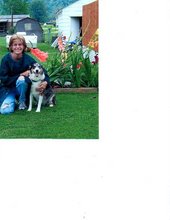
A Beautiful Summer Day.
Madam Kallee, CTD, CGC - 1994-2005 - Certified Therapy Dog and a Canine Good Citizen
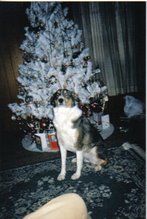
I am so pretty!
Kallee, T.D.I., CGC - Certified Therapy Dog and a Canine Good Citizen - 1994-2005

I loved to pose for the camera.
Hat Girl.
The things I do for my mom!
Happiness.
Bubby knows how to scratch a tummy.
Best of Friends.
Mine! No, Mine!, No Mine!!!
Whew !
Bubby wears me out!
This is the Life.
Just relaxing with bubby.
Kallee and Mr. Monkey
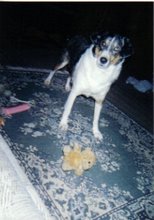
See Mr. Monkey? Wanna play?
Miss Cool.
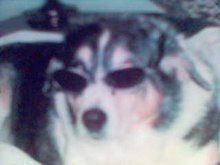
I loved to wear my shades.
Wednesday, October 31, 2007
Tuesday, October 23, 2007
The Breed Groups Recognized By A.K.C.
Dogs of the herding group have in common the desire and ability to control the movements of other animals, most often sheep and cattle. In some species, this is accomplished by stalking and staring, in others by barking and in others by nipping. Some herders have gathering tendencies, whereas others have driving tendencies. All have in common the ability to work using both their owner's commands and their own judgment. Herding breeds make intelligent and devoted partners.
The dogs of the herding group:
Australian Cattle Dog:
AKC Ranking: 73
Family: livestock, herding
Area of Origin: Australia
Date of Origin: 1800s
Original Function: cattle herding
Today's Function: cattle herding, herding trials
Avg Size of male: Height: 18-20 Weight: 35-45
Avg Size of Female: Height: 17-19 Weight: 35-45
Other Name: Queensland heeler, blue heeler, Hall's heeler
History:
In the early 1800s, vast land areas in Australia became available for grazing cattle. The cattle raised on these lands became so wild and intractable that the traditional European herding breeds that had proved satisfactory on tamer cattle were no longer suited for the job. A dog was needed that could withstand traveling long distances over rough terrain in hot weather and that could control cattle without barking (which only served to make wild cattle wilder). In 1840, a man named Hall bred some smooth blue-merle Highland collies to dingos, producing a strain known as Hall's heelers. One particularly influential stud was a dog named Bentley's dog, who is credited with stamping the white blaze found on the head of Australian cattle dogs today. Other breeders crossed their Hall's heelers with other breeds, including the bull terrier, Dalmatian and, later, black-and-tan kelpie, a sheep-herding breed. The result was a dog with the herding instincts of the collie and kelpie; the endurance, ruggedness and quiet style of the dingo; and the horse sense and protectiveness of the Dalmatian, all with a distinctively patterned coat. As the dogs became increasingly vital to the cattle industry of Queensland, they gained the name Queensland blue heeler. They later became known as Australian heeler, and then Australian cattle dog. A standard for the breed, emphasizing its dingo characteristics, was drawn up in 1897. The Australian cattle dog was slow to catch on in America, however, perhaps because it bore little resemblance to established herding breeds. When given a chance, it proved its merits and was welcomed as a herder and pet. The AKC recognized the breed in 1980, and it has since become a capable show dog, without sacrificing its functional makeup.
Temperament:
Smart, hardy, independent, stubborn, tenacious, energetic and untiring — these are all traits essential to a driver of headstrong cattle, and all traits of the Australian cattle dog. This dog must have a job to do or it will expend its efforts on unacceptable jobs of its own. Given challenging mental and hard physical exercise daily, it is among the most responsive and obedient of dogs, an exemplary partner in adventure. It tends to nip at the heels of running children.
Upkeep:
The Australian cattle dog was bred to be active and tireless. This dog needs a lot of physical and mental activity, more than a simple walk on a leash can provide. A good jog or long workout, coupled with obedience lessons or other intellectual challenges, is essential every day. It is happiest when it has a job to perform, and especially when that job is herding. The Australian cattle dog can live outdoors in temperate to cool climates. It is unsuited for apartment life. Its coat needs brushing or combing weekly to remove dead hairs.
Health:
• Major concerns: CHD, OCD, deafness, PRA
• Minor concerns: none
• Occasionally seen: cataract, lens luxation, PPM, vWD
• Suggested tests: hip, hearing, eye
• Life span: 10 – 13 years
Form and Function:
The Australian cattle dog is of moderate build, enabling it to combine great endurance with bursts of speed and the extreme agility necessary in controlling unruly cattle. It is sturdy and compact, slightly longer than it is tall. Its gait is supple and tireless, and it must be capable of quick and sudden movement. Its ability to stop quickly is aided by the rudderlike action of its tail (which is never docked). Its weather-resistant coat consists of a short, dense undercoat and moderately short, straight outer coat of medium texture.
Australian shepherd:
AKC Ranking: 34
Family: livestock, herding
Area of Origin: United States
Date of Origin: 1800s
Original Function: sheep herding
Today's Function: sheep herding, herding trials
Avg Size of male: Height: 20-23 Weight: 50-65
Avg Size of Female: Height: 18-21 Weight: 40-55
Other Name: none
History:
The Australian shepherd is not really an Australian breed, but it came to America by way of Australia. One popular theory of the breed's origin begins during the 1800s, when the Basque people of Europe settled in Australia, bringing with them their sheep and sheepdogs. Shortly thereafter, many of these shepherds relocated to the western United States, with their dogs and sheep. American shepherds naturally dubbed these dogs Australian shepherds because that was their immediate past residence. The rugged area of Australia and western America placed demands on the herding dogs that they had not faced in Europe, but through various crosses and rigorous selection for working ability, the Basque dog soon adapted and excelled under these harsh conditions. The breed kept a low profile until the 1950s, when it was featured in a popular trick-dog act that performed in rodeos and was featured in film. Many of these dogs, owned by Jay Sisler, can be found in the pedigrees of today's Aussies. The first Aussie was registered with the International English Shepherd Registry, now known as the National Stock Dog Registry. In 1957 the Australian Shepherd Club of America was formed and subsequently became the largest Aussie registry in America. Because many ASCA members felt that AKC recognition was not desirable for their breed, proponents of AKC recognition formed the United States Australian Shepherd Association. The AKC recognized the Australian shepherd in 1993. Its popularity according to AKC statistics underestimates the popularity of this breed as a pet because a large proportion of this working breed remains unregistered with the AKC. It is among the most versatile of breeds, excelling at conformation, obedience, herding and agility competition. The Aussie is also adept at working cattle; in fact, some believe its close working style is more suited to cattle than to sheep.
Temperament:
The Australian shepherd has a great deal of stamina and is loving, bold, alert, confident, independent, smart and responsive. If it doesn't get a chance to exercise and challenge its strongly developed mental and physical activities, it is apt to become frustrated and difficult to live with. With proper exercise and training, it is a loyal, utterly devoted and obedient companion. It is reserved with strangers and has a protective nature. It may try to herd children and small animals by nipping.
Upkeep:
This breed needs a good workout every day, preferably combining both physical and mental challenges. Even though it is physically able to live outside in temperate climates, it is a breed for which human contact is so vital that it is emotionally unsuited for a life in the yard. Its coat needs brushing or combing one to two times weekly.
Health:
• Major concerns: cataract, CEA
• Minor concerns: CHD, nasal solar dermatitis, Pelger – Huet syndrome, iris coloboma
• Occasionally seen: lumbar sacral syndrome, epilepsy, PRA, vWD, distichiasis, PDA, PPM
• Suggested tests: hip, eye
• Life span: 12 – 15 years
• Note: This breed is often sensitive to ivermectin; however, the dosage for heartworm preventive is considered safe. Merle-to-merle breedings result in some offspring that are homozygous merle, which is detrimental to health, commonly resulting in deafness and blindness. Natural bobtail-to-natural bobtail breedings can result in some offspring with serious spinal defects.
Form and Function:
This is an athletic dog of medium size and bone; it is lithe, agile and slightly longer than it is tall. It is muscular and powerful enough to work all day, without sacrificing the speed and agility necessary to cope with bolting livestock. Its gait is free and easy, and it must be able to change direction or speed instantly. Its double coat is weather resistant, with the outer coat of medium texture and length, straight to wavy. The expression is keen, intelligent and eager.
Bearded Collie:
AKC Ranking: 101
Family: livestock, herding
Area of Origin: Scotland
Date of Origin: 1800s
Original Function: sheep herding
Today's Function: herding trials
Avg Size of male: Height: 21-22 Weight: 45-55
Avg Size of Female: Height: 20-21 Weight: 45-55
Other Name: none
History:
The bearded collie probably originated from the central European Magyar komondor or lowland Polish sheepdog. In fact, records show that in 1514 two lowland Polish sheepdogs were brought to Scotland by Polish traders. Although dogs strongly resembling bearded collies are depicted in art dating from the 18th century, hard evidence of the breed cannot be found until the early-19th century, when the first breed description was published. These dogs were tireless herders of sheep and drovers of cattle over rough terrain in the cold Scottish mists. Long popular as a herding dog in Scotland, after the Victorian era the breed also gained favor as a show dog. Two strains, the border strain, which was brown and white with a slightly wavy coat, and the Highland strain, which had a gray and white coat, have since been interbred and merged into one breed. After World War I, the "beardie" was once again bred solely for work. Their value as stock dogs made it difficult for outsiders to acquire one from their shepherd owners. Eventually, however, a few breeders interested in showing beardies were able to bring some dogs to England and then to America. The AKC recognized the breed in 1977. It has since become a prominent show dog and continues as a capable herder, although it is more popular as a competitor in herding trials than as an actual working dog.
Temperament:
The boisterous beardie is lively and playful, full of enthusiasm and energy. It is smart and obedient, but it is an independent thinker with a clownish sense of humor. It likes children, but it may be too rambunctious for small children and may try to herd them when playing.
Upkeep:
This active dog needs either a good jog, a very long walk or a vigorous play session every day. It especially enjoys herding. The beardie can live outside in cool climates, but it is happier when allowed access to the house with its family. Its long coat needs brushing or combing every other day.
Health:
• Major concerns: none
• Minor concerns: CHD, epilepsy, colonic disease, pemphigus
• Occasionally seen: CHD, aortic stenosis, PRA, PPM, cataract, vWD
• Suggested tests: hip, (eye), (cardiac)
• Life span: 12 – 14 years
Form and Function:
The beardie is a medium-sized dog with a long, lean, strongly made body, which gives the impression of both strength and agility. Its gait is supple and powerful, with good reach and drive. The ability to make sharp turns, quick starts and sudden stops is essential in a sheep-herding breed, and the beardie must be able to keep this activity up for a long period of time under all conditions. Its coat is double with a soft, furry undercoat. The outer coat is flat, harsh and fairly straight; it is sufficient to protect the dog but not so much as to obscure the dog's lines. The beardie's expression is bright and inquiring.
Beauceron:
AKC Ranking: n/a
Family: Herding
Area of Origin: France
Date of Origin: 1500s
Original Function: Herder, guardian
Today's Function: Herder, guardian, police
Avg Size of male: Height: 25.5 - 27.5 Weight: 65 - 85
Avg Size of Female: Height: 24.5 - 26.5 Weight: 65 - 85
Other Name: Berger de Beauce, Bas-Rouge
History:
The Beauceron is an entirely French breed, dating back as far as the late 1500s. It originated in the plains area surrounding Paris known as La Beauce. The largest of the French sheepdogs, it was used as a general-purpose farm dog, driving and protecting sheep and sometimes, cattle, and guarding its family. In 1863, two types of plains flock-herding and guarding dogs were differentiated: the long-coated Berger de Brie (Briard) and the short-coated Berger de Beauce (Beauceron). The Societe Centrale Canine registered the first Berger de Beauce in 1893, and the first breed club was formed in 1922. Well known as the preferred herding dog in France, the breed remained virtually unknown outside of France. The French army employed Beaucerons as messenger dogs on the front lines during both world wars. The breed's extraordinary ability to follow directions, follow trails, and detect mines still makes them a respected military and police dog. They also serve their families as protection dogs. In the 1960s, a concerted effort was made to preserve the qualities of native French breeds, and since that time, the Beauceron?s popularity in France and elsewhere has grown. In 1980, the Beauceron Club of America formed, and, in 2001, the AKC admitted the Beauceron into the Miscellaneous class. They are making their presence felt by excelling in obedience, tracking, agility, Schuzthund and of course, herding.
Temperament:
Beaucerons are uncannily intelligent and adept at any task involving learning, memory, and reasoning. They are courageous and calm, and make reliable, thoughtful guardians. This is an extremely loyal breed that is eager to please its family; however, if not properly trained, the Beauceron can run the family. Beaucerons are patient with children, but can be overwhelming to them or try to herd them. They may be wary of strangers and do not take to unfamiliar dogs. They can get along with other family dogs and pets.
Upkeep:
This is a dog with an active mind and athletic body, and it needs mental and physical exercise every day. Without adequate stimulation, the Beauceron can become bored and destructive. Don't get a Beauceron unless you commit to taking time to train and exercise it regularly. It is very much a family dog and should not be relegated to a kennel, although it should spend time outdoors every day. Coat care is minimal, consisting of brushing once a week or so.
Health:
• Major concerns: none
• Minor concerns: CHD, gastric torsion
• Occasionally seen: none
• Suggested tests: hip
• Life span: 10 - 12 years
Form and Function:
The Beauceron is not a dog of extremes, but is a solid, balanced dog as befitting a true multipurpose dog ready to do a long day's work. Its body is powerful yet agile, its jaws strong, its gait fluid, effortless, and ground covering. The head is not held high when moving, but is lowered to the level of the back, as is typical of herding dogs. Its outer coat is straight, dense, and coarse, of medium length; this, combined with a dense undercoat, offers weather-resistant protection. An unusual trait is the presence of double dewclaws on the hindlegs, which seem to be a French tradition for herding and flock dogs. Although they serve no function, they were perhaps at one time associated with the best herders, and are now a breed trademark.
Belgian Malinois:
AKC Ranking: 96
Family: livestock, herding
Area of Origin: Belgium
Date of Origin: 1800s
Original Function: stock herding
Today's Function: security, police, contraband detection, assistance, herding trials, shutzhund
Avg Size of male: Height: 24-26 Weight: 60-65
Avg Size of Female: Height: 22-24 Weight: 60-65
Other Name: Malinois, chien de berger Belge
History:
The Belgian sheep-herding breeds, collectively known as chiens de berger Belge, shared their early history as general-purpose shepherds and guard dogs of Belgium. As working dogs, they were bred for ability rather than esthetics, and no careful records were kept. Thus, when dog shows became popular in the late 1800s, it was not clear if Belgium had any recognizable breeds with which they could tout their national pride. In 1891, professor Adolphe Reul was asked to study the native dogs to see if they could be sorted into distinct breeds. He found a group of similar dogs that differed only in coat type and color, all of which were grouped as Belgian shepherds. The shorthaired variety was developed in the area around Malines, and so became known as the Belgian Malinois. It remains the most popular of the Belgian shepherd breeds in its native land, but has had a rockier road in America. Between 1911 and World War II, the Malinois enjoyed a good deal of popularity in America. After the war, registrations plummeted, and it was rare to find a Malinois entered in competition. When the breeds were separated in 1959, Malinois registrations began to grow once again, but they still fell far behind the other Belgian breeds. More recently, the Malinois is becoming popular because of its reputation as one of the pre-eminent police dogs in the world, surpassing even the German shepherd in demand. Thus, even though it may not be seen in many homes or show rings, it is making its presence known as a keeper of the peace throughout the world.
Temperament:
Intense best describes the Belgian Malinois. This is a high-energy breed with a need for regular mental and physical stimulation. It is alert, smart and serious, an ideal watchdog and guard dog. It is aloof with strangers and can be aggressive toward other dogs and animals. Some can be domineering. When confined, it often runs in sweeping circles in an effort to stay on the move. It is protective of its home and family.
Upkeep:
The Malinois is a high-energy dog that needs a lot of exercise. Its needs cannot be met with a leisurely walk on leash. It instead needs a good jog or a vigorous play session. It especially enjoys herding. This breed can live outside in temperate to cool weather, but it would prefer to divide its time between house and yard. Its coat needs weekly brushing, more when shedding.
Health:
• Major concerns: none
• Minor concerns: CHD, epilepsy, skin allergies
• Occasionally seen: none
• Suggested tests: hip
• Life span: 10 – 12 years
Form and Function:
The Belgian Malinois is a sturdy dog of square proportion with moderately heavy, but oval, bone. It is elegant, with very proud head carriage. The overall impression is of power without bulkiness. The gait is smooth and easy, seemingly effortless rather than hard driving. Such a gait gives the impression of tirelessness. The Malinois has a tendency to run in a wide circle rather than a straight line. Its coat is fairly short, straight, and hard, with a dense undercoat. Its expression is intelligent and questioning.
Belgian Sheepdog:
AKC Ranking: 111
Family: livestock, herding
Area of Origin: Belgium
Date of Origin: 1800s
Original Function: stock herding
Today's Function: herding trials, schutzhund
Avg Size of male: Height: 24-26 Weight: 55-75
Avg Size of Female: Height: 22-24 Weight: 40-60
Other Name: Groenendael, chien de berger Belge
History:
The Belgian sheepdog, Belgian Tervuren and Belgian Malinois began as three local variations of one breed, which was known as the Belgian shepherd or Continental shepherd. The dog that was heir to the name Belgian sheepdog was originally known as the Groenendael variation of the breed. Like all the Belgian shepherds, it was a working farm dog expected to both herd and guard. It differed from the others because it had a rather long, black coat. In 1910 these dogs were officially dubbed Groenendael after the kennel that had selectively bred the black dogs since 1893 (just after the Belgian shepherds were recognized as a breed). By this time, the breed had gained some repute as a police dog and was already employed in this capacity in America. In World War I, they continued to shine as sentry dogs, messengers and even draft dogs. It was here that they captured the attention of the public, and they soon enjoyed a fair amount of popularity after the war. In 1959, the three Belgian shepherd breeds were divided into separate breeds, with the Groenendael subsequently known as the Belgian sheepdog. With its shimmering black coat, it is the most striking of the Belgian breeds, and that fact, along with its versatile abilities, has won it many faithful supporters.
Temperament:
Ever watchful and on the move, the Belgian sheepdog glides in large circles. It is playful, alert, watchful and protective — a tough, independent and intense dog. It is aloof with strangers and can be aggressive toward other dogs and animals. Some can be domineering. It is intelligent and biddable, but independent. It is protective of its home and family.
Upkeep:
The Belgian sheepdog needs a good deal of exercise, either a good long jog or a long, strenuous play session. It needs room to move during the day and does best with access to a yard. Although it can live outdoors in temperate to cool climates, it is family-oriented and happier if it can share time in the house with its family. Its double coat needs brushing and combing twice weekly, more when shedding.
Health:
• Major concerns: none
• Minor concerns: epilepsy, skin allergies
• Occasionally seen: CHD
• Suggested tests: none
• Life span: 10 – 12 years
Form and Function:
The Belgian sheepdog is an elegant, square-proportioned dog that is alert and agile with proud carriage. Its bone is moderately heavy. As a dog expected to herd for long hours, its gait is smooth, tireless and effortless rather than driving. It has a tendency to move in a circle rather than a straight line. It has an extremely dense undercoat along with an outer coat of abundant guard hairs that are long, well-fitting and straight. Its expression is intelligent and questioning; its black coloration is striking.
Belgian Tervuren:
AKC Ranking: 108
Family: livestock, herding
Area of Origin: Belgium
Date of Origin: 1800s
Original Function: stock herding
Today's Function: herding trials, schutzhund
Avg Size of male: Height: 24-26 Weight: 55-65
Avg Size of Female: Height: 22-24 Weight: 40-50
Other Name: Tervuren, chien de berger Belge
History:
The Belgian Tervuren is one of four Belgian shepherd breeds, all sharing the same origins but distinguished by different coat types and colors. They are the wire-haired Laekenois, the shorthaired Malinois, the long black-haired Groenendael and the long anything-but-black-haired Tervuren. All these herding – guard breeds were interbred before and after their recognition as one breed (the Belgian, or Continental, shepherd) in 1891. The Tervuren was named after the village of Tervuren, where one of the breed's earliest proponents lived. The Tervuren lagged behind the other shepherd breeds in popularity, perhaps hindered by its less flashy color and disagreements over exactly what colors were desirable. The first Tervuren was registered in America in 1918, but the breed's numbers remained so low that these dogs died out by the Depression. The Tervuren had to be almost re-created after World War II from longhaired offspring of Malinois parents. In 1959 the Belgian shepherd was divided into three breeds, and the Tervuren was on its own. The Tervuren has since captured the eye of many fanciers because it is the most elegant of the three breeds. It now enjoys moderate popularity. The Belgian Tervuren is a versatile dog and is used less in guard work, but more in herding, than are its Belgian shepherd counterparts.
Temperament:
Alert, watchful and energetic, the Tervuren is an active and dependable companion that functions best when given daily mental and physical exercise. It enjoys playing and running outside, and can be a well-mannered companion inside as long as it is given sufficient exercise. It is smart and obedient, but independent. It is aloof with strangers and can be aggressive toward other dogs and animals. It may nip at the heels of children in an attempt to herd them.
Upkeep:
The Tervuren needs strenuous activity, either a long walk or jog or an invigorating play or work session every day. It especially enjoys herding, which is the ideal exercise. It can live outside in temperate to cool climates, but it does best when allowed access to both a house and yard. Its double coat needs brushing and combing twice weekly, more often when shedding.
Health:
• Major concerns: none
• Minor concerns: epilepsy, skin allergies
• Occasionally seen: CHD
• Suggested tests: none
• Life span: 10 – 12 years
Form and Function:
This breed combines elegance and strength. It is square-proportioned and of medium bone. It is noteworthy for its exceedingly proud carriage. Its movement is lively, graceful and seemingly tireless, exhibiting an easy, effortless gait rather than a hard-driving action. It has a natural tendency to move in a circle rather than a straight line. It combines a dense undercoat with an outer coat consisting of abundant guard hairs that are long, well-fitting, straight and of medium harshness. Its expression is intelligent and questioning.
Border Collie:
AKC Ranking: 65
Family: livestock, herding
Area of Origin: Great Britain
Date of Origin: 1800s
Original Function: sheep herding
Today's Function: sheep herding, herding trials, obedience
Avg Size of male: Height: 20-23 Weight: 30-45
Avg Size of Female: Height: 18-21 Weight: 30-45
Other Name: none
History:
The consummate sheepdog, the border collie is the result of over a century of breeding for function above all other criteria. In the 1800s, a variety of sheep-herding dogs with differing herding styles existed in Great Britain. Some were "fetching" dogs, dogs having an innate tendency to circle stock and bring them back toward the shepherd. Most of these were noisy dogs, tending to nip and bark as they performed their job. Boasts of the superiority of certain dogs were only natural; in 1873 the first actual sheepdog trial was held in order to settle some of these boasts. This contest would indirectly lead to the first border collies, by way of a dog named Hemp, who so distinguished himself in trials that he sired a great number of offspring. He herded not by barking and nipping, but by calmly staring at the sheep ("giving eye") intimidating them into moving. Hemp is considered to be the father of the border collie. In 1906, the first standard was drawn up, but unlike the physical standards of most breeds, this was a description of working ability, with no regard to physical appearance. This emphasis has shaped the breed ever since. In fact, the dogs were still referred to simply as sheepdogs; only in 1915 was the name border collie first recorded, in reference to the dog's origin around the English and Scottish borders. The border collie came to America and instantly dazzled serious shepherds with its quick herding and obedience capabilities. In fact, the latter opened a new door for the breed as one of the top competitive breeds in obedience trials. Having worked hard to gain the reputation of one of the smartest breeds of dogs, a breed unspoiled by cosmetic emphasis, many border collie fanciers actively fought AKC recognition as a show dog. In 1995, however, the AKC recognized the breed and herded it into the show ring.
Temperament:
The border collie is a bundle of mental and physical energy awaiting its chance to be unleashed on the world. Among the most intelligent and obedient of breeds, it is nonetheless a disastrous house dog if it is not given a challenging job every day. Given sufficient exercise, it is a dependable and loyal companion. It is intent on whatever it does and tends to stare, which can be unnerving to other animals. It also likes to chase other animals. It is reserved, even protective, toward strangers.
Upkeep:
Few dogs are as work-oriented as the border collie. This is a dog that needs a job. It needs a lot of physical and mental activity every day to satisfy its quest for work. It can live outdoors in temperate to cool climates, but it enjoys being with its family inside as well. This is a dog that cannot live in an apartment and that should preferably have ready access to a yard. Its coat needs brushing or combing twice weekly.
Health:
• Major concerns: CHD
• Minor concerns: PRA, lens luxation, CEA, PDA, OCD, PPM
• Occasionally seen: cerebellar abiotrophy, ceroid lipofuscinosis, deafness
• Suggested tests: hip, eye
• Life span: 10 – 14 years
Form and Function:
This is a medium dog of strong bone, slightly longer than it is tall, combining grace, agility, substance and stamina. Its trot is smooth, ground-covering and tireless, moving with stealth and strength. It is able to change speed and direction suddenly. Border collies must be able to display incredible agility even after working for long periods. The coat can be either smooth or rough. The smooth coat is short all over the body; the rough coat is medium to long in length and flat to slightly wavy in texture. Its expression is intelligent, alert, eager and full of interest, a reflection of its temperament.
Bouvier des Flandres:
AKC Ranking: 86
Family: livestock, herding
Area of Origin: Belgium
Date of Origin: 1600s
Original Function: cattle herding
Today's Function: security, herding trials
Avg Size of male: Height: 24.5-27.5 Weight: 69-90
Avg Size of Female: Height: 23.5-26.5 Weight: 69-90
Other Name: Belgian cattle dog
History:
The bouvier des Flandres served farmers and cattle merchants in controlling cattle in the great farmlands of southwest Flanders and on the French northern plain. In fact, bouvier means "cowherd" or "oxherd" in French, although the dogs were formerly more often called vuilbaard (dirty beard) or koe hond (cow dog). Besides its main duty as a cattle drover, the bouvier was an all-around farm dog, functioning also as a livestock and farm guard and draft dog. As expected from a dog selected to perform a variety of tasks, these working dogs were of a variety of types, colors and even sizes. This wide variety also reflected the fact that this was a working dog, and breeding stock was chosen by ability, not pedigree or esthetics. The derivation of the breed is not documented but may have included mastiff, sheepdog and possibly even spaniel breeds. The first breed standard, drawn up in 1912, reflected this diversity of types and signaled a growing interest in the breed from dog fanciers. In the midst of the breed's rising popularity, most of the bouviers were lost in World War I — although some served as ambulance and messenger dogs during the war. One of the few survivors was of such superior quality that the breed was successfully revived through his progeny. This dog, Ch. Nic de Sottegem, can be found in virtually every modern bouvier pedigree. In 1922, a revised standard further defined the desirable bouvier type, and helped pave the way to a more homogeneous breed. When the first bouviers entered American show rings in the 1930s, they aroused much attention among dog fanciers. The breed has never become extremely popular, but it is well-known at dog shows and herding trials.
Temperament:
The bouvier is a steady, stalwart companion that is loyal, devoted, fearless and protective. Given daily exercise, it is calm and well-mannered indoors, but ready for an adventure in the great outdoors. It is independent and confident of its own judgment, yet biddable and willing to please. It can be domineering. It is reserved, even protective, toward strangers and can be aggressive with strange dogs. It is very good with children, although it may nip at heels in play.
Upkeep:
The bouvier des Flandres is not a breed that can be put aside until the mood strikes to play with it. It needs daily exercise and daily interaction, and a lot of both. It loves the chance to herd, but its requirements can also be met with a good jog, a very long walk or a vigorous play session. It can live outdoors in temperate to cool climates. It makes a good house dog, however, and would prefer access to both house and yard. Its harsh coat needs combing once or twice weekly, plus scissoring and shaping (clipping for pets and stripping for show dogs) every three months.
Health:
• Major concerns: CHD
• Minor concerns: gastric torsion
• Occasionally seen: entropion
• Suggested tests: hip
• Life span: 10 – 12 years
Form and Function:
This is a versatile breed able to perform a variety of functions, including cattle herder, draft dog and guard. As such, it combines great strength with agility and endurance. The bouvier is a compact, short-coupled dog, of square proportion and rugged appearance. Its gait is free, bold and proud. Its weatherproof coat is tousled and double, with a fine undercoat and a harsh, dry outer coat. It is trimmed (if necessary) to a length of about 2.5 inches. The head is accentuated by a beard and moustache, which adds to the dog's bold and alert expression.
Briard:
AKC Ranking: 108
Family: livestock, herding
Area of Origin: France
Date of Origin: 1300s
Original Function: herding and guarding sheep
Today's Function: herding trials
Avg Size of male: Height: 23-27 Weight: 75-100
Avg Size of Female: Height: 22-25.5 Weight: 50-65
Other Name: berger de Brie
History:
The briard is one of four French sheepdog breeds, the others being the Beauceron, Picardy and Pyrenean. It is the oldest of the four breeds, with dogs resembling briards depicted in art from as long ago as the eighth century, and more definitive evidence by the 14th century. These early dogs were known as chien berger de Brie (shepherd dog of Brie), giving rise to the belief that the breed originated in the province of Brie; however, it may also be a corruption of chien d'Aubry, referring to the dog of Aubry de Montdidier, which saved his son's life (according to 14th-century legend). The name briard was not used until 1809. Originally employed as a herd protector, the briard was expected to tackle wolves if the need arose. After the French Revolution, which resulted in the country's land being divided into smaller sectors, it was important that the flocks be kept close to home, and the briard turned its talents to herding rather than guarding sheep. Only around 1900 did it become a show dog. The first breed standard was written in 1897, but it was replaced by another in 1909. Briards came to America very early, with evidence that both Lafayette and Thomas Jefferson brought some of the first specimens to the New World. These dogs did not have a lasting influence, however. After World War I, American soldiers brought some briards to America, and this was the beginning of the modern American briard. The breed's popularity has been modest in America, but it remains the most popular sheep herder in its native France.
Temperament:
Devoted and faithful, the briard is a loving and protective companion. It is independent, intelligent and self-assured, but it is also willing to please and eager to serve as a partner in adventure. It is reserved with strangers. It can be aggressive with other dogs and may nip at people's heels when playing. It tends to stay at home and may attempt to keep the family's children home as well!
Upkeep:
This is a dog that needs a good amount of activity and interaction every day. Its favorite exercise is the chance to herd, but it can also be satisfied with a long walk or jog, or a long play session coupled with a little training. The briard can live outside in temperate to cool climates, but is happiest if allowed access to both house and yard. Its long coat needs brushing or combing every other day or mats can form.
Health:
• Major concerns: gastric torsion, CHD
• Minor concerns: nightblindness
• Occasionally seen: PRA, heart problems
• Suggested tests: hip, eye, (cardiac)
• Life span: 10 – 12 years
Form and Function:
The briard is square or slightly longer than it is tall and powerful without being course; the overall appearance is one of handsome form. Like all good herding dogs, it combines strength, flexibility, agility and endurance with the ability to make abrupt turns, springing starts and sudden stops. Its movement has been described as "quicksilver," with supple, light strides that give the impression of gliding. Its undercoat is fine and tight, and its outer coat is coarse and dry, lying flat in long, slightly wavy locks. On the shoulders, the coat's length is 6 inches or more. The questioning, confident expression is enhanced by the longer eyebrows, as well as the long-appearing head.
Canaan Dog:
AKC Ranking: 146
Family: livestock, herding, primitive, Southern (pariah)
Area of Origin: Israel
Date of Origin: ancient times
Original Function: sentry, messenger, and assistance
Today's Function: herding trials
Avg Size of male: Height: 20-24 Weight: 45-55
Avg Size of Female: Height: 19-23 Weight: 35-45
Other Name: kalef K'naani
History:
Canaan dogs have evolved through hundreds, and perhaps thousands, of years of hardship. It is thought that the breed originated in the biblical land of Canaan and were known as kelev Kanani ("dog of Canaan"). When the Israelites were dispersed from their homeland by the Romans 2,000 years ago, most of the Israeli dogs were left to fend for themselves in the Sebulon coastal plain and Negev desert. Bedouins captured male puppies from the wild to raise as guard and livestock dogs. When the Israeli Defense Force tried to develop service dogs in the 1930s, the traditional European service breeds weren't able to adapt to the harsh climate. The Canaan dog owes its existence primarily to the efforts of one woman, Dr. Rudolphina Menzel. Her search for a more suitable dog led her to the native feral dogs. Several dogs were captured, and a breeding and training program was begun. The dogs quickly proved their worth, serving as sentry dogs, messengers, mine detectors, Red Cross helpers and even locators of wounded soldiers during World War II and as guide dogs for the blind after the war. Perhaps no other breed of dog has ever risen from feral roots to become such a useful and dedicated companion in so short a time. The first Canaan dog came to America in 1965. Not the flashiest of breeds, the Canaan's understated good looks may have made many people overlook it, despite its companionship credentials. Nonetheless, it slowly attracted admirers, and the AKC finally admitted it into the herding group in 1997. Now beginning a new era as a show dog, the increased exposure is sure to attract many more people looking for a loyal and hardy pet.
Temperament:
Not only does the Canaan dog excel as a herder, but it has also proven itself in a variety of tasks involving dependability and obedience. This is an intelligent, devoted, docile dog that is quite tractable and willing to please. It is aloof toward strangers and protective of its family. The Canaan dog is generally good with other household pets and dogs, but it may be aggressive toward strange dogs. It is a natural guardian and tends to bark a lot.
Upkeep:
Few breeds can claim as pure a working heritage as the Canaan dog. This dog will not be happy just sitting around. It needs lots of exercise and mental and physical challenges. These needs can be met with herding exercise, a long jog, or a strenuous game session along with a challenging training session. It can live outdoors in warm to cool climates, but it also makes an excellent house dog. Its coat needs brushing about once a week to remove dead hairs.
Health:
• Major concerns: none
• Minor concerns: none
• Occasionally seen: none
• Suggested tests: none
• Life span: 12 – 13 years
Form and Function:
The Canaan dog resembles none of the other herding breeds, arising from a completely different background. nonetheless, it shares similar traits needed in any dog that must herd for hours. It is a medium-sized, square-proportioned dog of moderate substance that combines strength, agility and endurance. It is not exaggerated in any way. Its movement is athletic and graceful, with a brisk, ground-covering trot. It is able to change directions instantly. It has a double coat, with a short, soft undercoat that varies in density according to climate, and a straight, flat-lying, harsh outer coat, with a slight ruff. This breed must adapt to great extremes in weather ranging from hot days to cold nights.
Collie:
AKC Ranking: 32
Family: livestock, herding
Area of Origin: Scotland
Date of Origin: 1800s
Original Function: sheep herding
Today's Function: herding trials
Avg Size of male: Height: 24-26 Weight: 60-75
Avg Size of Female: Height: 22-24 Weight: 60-65
Other Name: Scottish collie
History:
The derivation of the collie is as obscure as the derivation of its name. One theory of the breed's origins is that it was derived from the same rootstock as the border collie. One theory of the name's origin is that it was derived from a Gaelic word meaning useful, which certainly described the useful farm or stock dogs valued by the Celts who first settled on the British Isles. Although sheep herding and guarding are some of the most ancient of canine services, evidence of the collie dates only from about 1800. Both rough- and smooth-coated "Scotch" collies existed by that time, but they apparently were derived from different crosses. The rough-coated dogs were characteristically smaller and broader headed, and usually black or black and white. As the breed caught the interest of dog fanciers, both rough- and smooth-coated collies became taller and more refined. The rough-coated collie was especially influenced by the progeny of a dog named "old cockie," born in 1867 and thought to be responsible not only for setting type but also for introducing the sable color. Around this same time, Queen Victoria became enthusiastic about the breed; under her sponsorship, its popularity grew not only with shepherds appreciative of its working value but also with members of the upper class, who were enamored of its beauty. By 1886 a standard was drawn up that still describes the breed as it is today. Meanwhile, as sheep herding became more important in America, settlers brought collies with them to the New World. In 1878, Queen Victoria once again put the breed in the limelight by entering two collies in the Westminster Dog Show. This provided the impetus for America's social elite to join the collie clan, and soon the collie could be found in some of the most prestigious estates in America. Later the collie found a champion in Albert Payson Terhune, whose stories about collies heightened their popularity with people from all walks of life. The most famous collie of all, the te
Temperament:
The collie is gentle and devoted, a mild-mannered friend to all. It is a dog with a working heritage, and it needs daily mental and physical exercise or it can become frustrated. It is sensitive, intelligent and willing to please, although it is sometimes a bit stubborn. It can nip at heels in play. Some may bark a lot.
Upkeep:
A good walk or jog on leash or a fun play session is needed every day. Herding is an excellent exercise. The collie can live outdoors in temperate to cool climates, but it is such a family-oriented dog that it is far happier indoors. The coat of the smooth variety needs minimal care; the coat of the rough variety needs brushing or combing every other day, more when shedding.
Health:
• Major concerns: CEA
• Minor concerns: distichiasis, pyotraumatic dermatitis
• Occasionally seen: PDA, deafness, cerebellar abiotrophy (Rough)
• Suggested tests: eye, (cardiac), (hearing)
• Life span: 8 – 12 years
• Note: often sensitive to ivermectin. Merles should not be bred to merles because homozygous merle is lethal or detrimental to health.
Form and Function:
The collie is an active, lithe, strong dog that combines strength, speed and grace. Its gait suggests effortless speed as well as the ability to change speed and direction instantly, as required in herding dogs. The coat can be of two types, both with a soft, abundant undercoat. The outer coat of the smooth variety is short, hard and flat; that of the rough variety is straight, harsh, abundant and long, particularly on the mane and ruff. The collie's expression is an important hallmark of the breed, and depends upon the shape and balance of the skull and muzzle, as well as the characteristics of the eyes and ears. It should be bright, alert and intelligent — traits accentuated by a fairly refined head.
German Shepherd:
AKC Ranking: 4
Family: livestock, herding
Area of Origin: Germany
Date of Origin: 1800s
Original Function: sheep herding, guarding, police dog
Today's Function: police, contraband detection, assistance, herding trials, schutzhund
Avg Size of male: Height: 24-26 Weight: 75-95
Avg Size of Female: Height: 22-24 Weight: 75-95
Other Name: Alsatian, Deutscher schaferhund
History:
Despite an outward appearance slightly resembling a wolf, the German shepherd dog is a fairly recently developed breed and, contrary to namve beliefs, it is no more closely related to the wolf than any other breed of dog. The breed is the result of a conscious effort to produce the ideal shepherd, capable of herding and guarding its flocks. Perhaps never in the history of any breed has such concerted effort been put into improving a dog, mostly due to the formation in 1899 of the Verein fur Deutsche Scharferhunde SV, an organization devoted to overseeing the breeding of the German shepherd. Breeders sought to develop not only a herding dog but also one that could excel at jobs requiring courage, athleticism and intelligence. In short order, the German shepherd had proved itself a more than capable police dog, and subsequent breeding strove to perfect its abilities as an intelligent and fearless companion and guardian. During World War I, it was the obvious choice for a war sentry. At the same time, the AKC changed the breed's name from German sheepdog to shepherd dog, and Britain changed it to Alsatian wolf dog, both attempts to dissociate the dog from its unpopular German roots. The wolf dog was later dropped as it caused many people to fear the breed. In 1931, the AKC restored the breed's name to German shepherd dog. The greatest boon to the shepherd's popularity came in the form of two dogs, both movie stars: Strongheart and Rin Tin Tin. The German shepherd held the number-one spot in American popularity for many years. Although presently it has dropped from the top spot, the German shepherd remains as one of the most versatile dogs ever created, serving as a police dog, war dog, guide dog, search-and-rescue dog, narcotics- or explosives-detecting dog, show dog, guard dog, pet — and even shepherd.
Temperament:
Among the most intelligent of breeds, the German shepherd dog is so intent on its mission — whatever that may be — that it is virtually unsurpassed in working versatility. It is utterly devoted and faithful. Aloof and suspicious toward strangers, it is protective of its home and family. It can be domineering. It can be aggressive toward other dogs, but it is usually good with other pets.
Upkeep:
This breed needs daily mental and physical challenges. It enjoys a good exercise session as well as learning session. It can live outside in temperate to cool climates, but it is family-oriented and does equally well as a house dog. Its coat needs brushing one or two times weekly.
Health:
• Major concerns: CHD, elbow dysplasia
• Minor concerns: panosteitis, vWD, progressive posterior paresis, cauda equina, pyotraumatic dermatitis, skin allergies, malignant neoplasms, pannus, cataract, gastric torsion, perianal fistulas, cardiomyopathy
• Occasionally seen: pancreatic insufficiency
• Suggested tests: hip, elbow, eye (blood)
• Life span: 10 – 12 years
• Note: GSDs are especially susceptible to a potentially fatal systemic fungal infection from Aspergillus.
Form and Function:
The German shepherd dog has an outline of smooth curves on a body that is longer than it is tall. It is strong, agile and substantial. Its gait is exceptionally outreaching and elastic, covering the ground in great strides. It has a double coat, with the outer coat consisting of dense, straight or slightly wavy, harsh, close lying hair of medium length.
Polish Lowland Sheepdog:
AKC Ranking: 135
Family: Livestock, Herding
Area of Origin: Poland
Date of Origin: Ancient times
Original Function: Sheep herding
Today's Function: Sheep herding, companion
Avg Size of male: Height: 18 - 20 Weight: 30 - 35
Avg Size of Female: Height: 17 - 19 Weight: 30 - 35
Other Name: Polski Owczarek Nizinny, PON
History:
The Polish Lowland Sheepdog is known in much of the world as the Polski Owczarek Nizinny (pronounced "pole-ski off-chair-ick na-gin-nee"), and even in America it goes by its nickname, the PON. The breed's origins probably reach back to Central Asia from one or more Tibetan breeds, such as the Tibetan Terrier, which were probably introduced to Eastern Europe by Tibetan traders. The long-coated Tibetan dogs were likely interbred with corded-coated Hungarian sheepdogs introduced by the Huns in the fourth century. While large flock-guarding dogs staved off large predators, the smaller PONs worked with shepherds to move and control sheep, and also kept watch against intruders. Unlike larger dogs, they didn't scare the sheep and they could work all day. They worked on the Polish lowlands for centuries until interest in purebred dogs and livestock swept through Europe in the late 1800s and early 1900s. This, combined with Polish national pride following World War I, created interest in promoting and selectively breeding the PON. Several PONs left the plains to live and work on large estates. In 1924, PONs were shown at a Warsaw poultry and dog show. PONs breeders were in the midst of starting a registry when Germany invaded Poland in 1939. Most dogs had to be abandoned, but legend has it that a Warsaw PON named Psyche was valued for her ability to predict incoming bombs, alerting people to take cover in shelters. Only about 150 PONs remained after World War II, but several fanciers sought to reconstitute the breed. The first PONs were registered with the Polish Kennel Club in 1957. A PON named Smok was influential in modeling the breed standard, which was approved in 1959. PONs were exhibited at the World Dog Show in 1965, exposing them to dog fanciers from around the world. In 1987eight fanciers formed the American Polski Owczarek Nizinny Club. In 2001, the PON was admitted to the AKC under the English translation of its name, Polish Lowland Sheepdog.
Temperament:
Lively and loyal, the PON has been shaped by centuries of work as a shepherd. This is a territorial breed that is often wary of strangers; however, to those it knows it is very affectionate. A PON's bark is one of its best friends, and the typical PON shows it off often. The PON has an independent and even willful side. It learns quickly, but sees no use in following commands blindly. Despite its shaggy dog look, the PON can be a serious dog. PONs are good with considerate children, most other pets, and most other dogs, although if challenged by a dog, they will hold their own.
Upkeep:
The PON is not a cuddly overgrown lapdog, but a serious worker that needs a job to be satisfied. This dog needs to exercise its body and mind daily. It flourishes when allowed to herd or learn agility. The PON does not accept extended confinement, but does best living inside and working and playing outside. Its coat needs considerable care, preferably brushing every couple of days.
Health:
• Major concerns: none
• Minor concerns: none
• Occasionally seen: none
• Suggested tests: hip, eye
• Life span: 10-14 years
Form and Function:
The PON is a cobby, medium-sized dog, slightly longer than tall, giving it great agility. It is strong and muscular, enabling it to control livestock. It has a fluid gait, with long stride, allowing it to trot effortlessly for hours. It is inclined to amble, which can act as a reconnaissance, energy-efficient gait. Toeing in is considered natural. The coat is long, dense, shaggy, and double, providing great protection against the elements. The PON is shown naturally, without scissoring.
Puli:
AKC Ranking: 129
Family: livestock, herding, gundog
Area of Origin: Hungary
Date of Origin: Middle Ages
Original Function: sheep herding
Today's Function: herding trials
Avg Size of male: Height: 17 Weight: 25-35
Avg Size of Female: Height: 16 Weight: 25-35
Other Name: Hungarian puli, Hungarian water dog
History:
Around the 9th century, the Magyar tribes came from the eastern Urals to occupy the central Danube area, intermingling with Turkish people along the way. They brought with them various sheepdogs, including the forebear of the modern puli. The puli's resemblance in body structure to the Tibetan spaniel has led some to surmise that the latter may have played a role in the puli's development. Whatever the origin, the small dogs were agile sheep herders, able even to turn a sheep by jumping on its back. The black color was important so that it could be easily spotted by the shepherd among the sheep. Thus, the Magyar's larger dogs were probably used as nighttime guards, and the small black dogs as daytime herders. After the decimation of Hungary by invaders in the 16th century, the country was repopulated by people, sheep and dogs from western Europe. These dogs interbred with the native pulik to produce the puli, and then the puli and pumi were interbred to such an extent that the original puli breed was nearly lost. In the early 1900s, an effort began to resurrect the puli; the first standard was written in 1925. Around that time, pulik in Hungary varied greatly in height from large "police" through medium "working" to small "dwarf" sizes. The medium-sized dogs were most representative of the traditional herding puli and were established as the desired size. In 1935, the U.S. Department of Agriculture imported several pulik in an effort to improve herding dogs in America. This effort was thwarted by war, but the breed's working ability became known in America, and by 1936 the AKC recognized the puli. The breed's fame spread farther throughout Europe as a result of Hungarians fleeing the war, bringing their dogs with them. The modern puli remains an adept herder, but it enjoys only modest popularity as a pet or show dog.
Temperament:
A mop on springs, the puli is full of bouncing energy. It is busy and curious and needs daily exercise. This smart dog is also headstrong and tough. It can be aggressive toward other dogs. Alert and watchful, it is also protective of its family. It barks a lot.
Upkeep:
This is an energetic breed on the lookout for a job, preferably something to herd. It can be satisfied with a good walk or jog, or a lively game and training session, however. It can live outdoors in temperate to cool climates, but it also makes an excellent house dog. Its coat can hold debris. Its nonshedding coat can be brushed or corded; if brushed, it needs brushing every one to two days. If corded, the cords must be regularly separated because the coat tends to hold dirt; bathing is time consuming and drying takes as much as one day. Pets can be clipped, but then part of the breed's unique appeal is lost.
Health:
• Major concerns: CHD
• Minor concerns: none
• Occasionally seen: PRA
• Suggested tests: hip, eye
• Life span: 12 – 16 years
Form and Function:
The puli is a compact dog of square proportion and medium bone. Its gait at a trot is quick stepping, but neither far reaching nor mincing. It is of utmost importance that the puli be able to change directions instantly, and it is quick, agile and even acrobatic. Its weatherproof coat consists of a soft, wooly, dense undercoat and a wavy or curly outer coat. This coat will form round or flattened cords, but it may also be brushed out.
Shetland Sheepdog:
AKC Ranking: 17
Family: livestock, herding
Area of Origin: Scotland (Shetland Islands)
Date of Origin: 1800s
Original Function: sheep herding
Today's Function: sheep herding, herding trials
Avg Size of male: Height: 13-16 Weight: 20
Avg Size of Female: Height: 13-16 Weight: 20
Other Name: none
History:
The ancestors of the Shetland sheepdog were the herding dogs of Scotland that also provided the rootstock for the collie and border collie. Some of these dogs were quite small, measuring only about 18 inches in height. The Shetland sheepdog almost certainly is derived from these early collie type dogs, which then were further developed on the Shetland Islands. Some Iceland dogs may have also played a role, and perhaps even a black and tan King Charles spaniel. The paucity of vegetation favored smaller livestock, and the animals needed to herd them were proportionately smaller. In a land with few fences, an adept herder was essential to keep livestock away from cultivated land. As all-around farm dogs, they herded not only sheep but also ponies and chickens. In some remote areas, it was customary to keep all animals in the family's home building during winter, and the amiable herding dog no doubt worked its way right into the family part of the home. Because of its isolation from the rest of the world, the breed was able to breed true in a comparatively short time. The British naval fleet used to frequent the islands for maneuvers and often bought puppies to take home to England. Early dogs were referred to as "toonie dogs" (toon being the local Shetland word for farm), but they were initially shown (around 1906) as Shetland collies. Collie fanciers objected to the name, so it was changed to Shetland sheepdog. The breed is far more often referred to by its nickname of "Sheltie," however. In the early years in England, breeders often discreetly crossed Shelties with rough-coated collies in an attempt to improve on their collie characteristics. This practice led to oversized Shelties, however, and has long since stopped. Following the immense popularity of the collie, the Sheltie became the answer to the family wanting a loyal, striking pet of smaller size, and it is one of the most popular breeds in the world.
Temperament:
The Shetland sheepdog is extremely bright, sensitive and willing to please. This combination makes for a dog that is very obedient, quick to learn and utterly devoted to its family. It is not only gentle, playful, amiable and companionable, but also excellent with children, although it can nip at heels in play. It is reserved and often timid toward strangers. It barks a lot.
Upkeep:
The Sheltie is energetic, but its exercise needs can be met with a good walk, short jog or active game and training session. It can live outdoors in a temperate climate, but it is strongly advised that the Sheltie be a house dog. It is too attached to its family to do well separated from them. Its thick coat needs brushing or combing every other day.
Health:
• Major concerns: dermatomyositis
• Minor concerns: CEA, PRA, trichiasis, cataract, CHD, hemophilia, Legg – Perthes, patellar luxation
• Occasionally seen: PDA, deafness, epilepsy, vWD
• Suggested tests: eye, hip, DNA for vWD
• Life span: 12 – 14 years
• Note: may be sensitive to ivermectin. Merles should not be bred to merles because homozygous merle is lethal or detrimental to health.
Form and Function:
The Shetland sheepdog is a small, agile dog, longer than it is tall. Its gait is smooth, effortless and ground-covering, imparting good agility, speed and endurance essential in a herding dog. It has a double coat, with a short, dense undercoat and a long, straight, harsh outer coat. The hair of the mane, frill and tail is abundant. Its expression is gentle, intelligent and questioning. Although it resembles a rough collie in miniature, subtle differences distinguish the breeds.
Welsh Corgi-Cardigan:
AKC Ranking: 81
Family: livestock, herding
Area of Origin: Wales
Date of Origin: ancient times
Original Function: cattle driving
Today's Function: cattle driving, herding trials
Avg Size of male: Height: 10.5-12.5 Weight: 30-38
Avg Size of Female: Height: 10.5-12.5 Weight: 25-34
Other Name: none
History:
One of the earliest breeds to come to the British Isles, the Cardigan Welsh corgi was brought from central Europe to Cardiganshire, South Wales, centuries ago. Its derivation is unknown, though it may have been influenced by the extinct English turn-spit dog, a short-legged, low-bodied dog used to turn spits in kitchens. Initially used as a family protector and even a helper in the hunt, it was only later that the corgi found its true forte. In a time when the land available to tenant farmers was determined by how much acreage their cattle occupied, it was to the farmer's advantage to have scattered, far-ranging stock. Thus, a dog that would drive, rather than herd, the cattle was an invaluable aid, and the corgi stepped right into this role, nipping at the cattle's heels and ducking their kicks. In fact the word corgi is probably derived from cor (to gather) and gi (dog). The original corgis were supposed to measure a Welsh yard (slightly longer than an English yard) from nose to tail tip, and in parts of Cardiganshire the breed was called the yard-long dog or ci-llathed. When the Crown lands were later divided, sold and fenced, the need for drovers was lost, and the corgi lost its job. Kept by some as a guard and companion, nonetheless, it became a luxury that few could afford, and it became perilously close to extinction. Crosses with other breeds had been tried, but most were not particularly successful. The exception was the cross with the brindle herder — present-day Cardigans are the products of this slight herder influence. The first Cardigans were shown around 1925. Until 1934, the Cardigan and Pembroke Welsh corgis were considered one breed, and interbreeding between the two was common. The first Cardigans came to America in 1931, and the AKC recognized the breed in 1935. For some unknown reason, the Cardigan has never enjoyed the popularity of the Pembroke corgi and remains only modestly popular.
Temperament:
Fun-loving and high-spirited, yet easygoing, the Cardigan is a devoted and amusing companion. This is a hardy breed, capable of a day dodging kicks, so it is agile and tireless. At home it is well-mannered but inclined to bark. It tends to be reserved with strangers and can be scrappy with other dogs.
Upkeep:
The Cardigan needs a surprising amount of exercise for its size. Its needs can best be met with a herding session, but a moderate walk or vigorous play session will also suffice. It can live outside in temperate to cool weather, but it is a very good house dog and best when it is allowed access to both house and yard. Its coat needs brushing once a week to remove dead hair.
Health:
• Major concerns: CHD
• Minor concerns: PRA
• Occasionally seen: urolithiasis, PRA
• Suggested tests: hip, (eye), (DNA test for PRA)
• Life span: 10 – 12 years
Form and Function:
The Cardigan is a low-set dog, approximately 1.8 times longer than it is tall, with moderately heavy bone. It is small but powerful — capable of the agility, speed and endurance necessary to drive cattle for extended periods. Its small size allowed it to duck under the cattle's hooves should they kick at it. Its gait is free, smooth, effortless and ground-covering. Its double coat consists of a soft thick undercoat and slightly harsh outer coat of medium length. Its expression is alert, gentle and watchful, yet friendly.
Welsh Corgi-Pembroke:
AKC Ranking: 24
Family: livestock, herding
Area of Origin: Wales
Date of Origin: 1110s
Original Function: cattle driving
Today's Function: cattle driving, herding trials
Avg Size of male: Height: 10-12 Weight: 27
Avg Size of Female: Height: 10-12 Weight: 25
Other Name: none
History:
The corgi was an essential helper to the farmers of South Wales. Although these little dogs specialized in herding cattle, nipping at their heels and then ducking under their kicking hooves, they were almost certainly also used in herding sheep and even Welsh ponies. Despite claims for the antiquity of the breed, it is difficult to trace its origins or even authenticate its existence in early times. A Welsh cattle dog is mentioned in a book of the 11th century, however. Although it certainly shares its past with the Cardigan Welsh corgi, the Pembroke was developed separately, in Pembrokeshire, Wales. As a hard-working dog, the corgi was out in the fields when many of the early dog shows were being held. Only in 1926 did a club form and the breed enter the show ring. The first exhibits were straight from the farm and aroused only modest attention. Breeders subsequently strove to improve upon the breed's inherent good looks and were rewarded with increased popularity. The obvious differences between the Pembroke and Cardigan were troublesome to judges — the Pembroke is smaller, with sharper features, a more foxlike expression and characteristically no tail. In 1934, the Cardigan and Pembroke corgis were divided into two separate breeds, after which the Pembroke soared in popularity. Its appeal was heightened when it became the favorite of King George VI and, subsequently, Queen Elizabeth II. By the 1960s, the Pembroke had become one of the most popular pet breeds all over the world, but especially in Britain. This popularity has since waned slightly, but far more Pembrokes can be found herding in back yards than in farmyards today.
Temperament:
Quick and quick-witted, the Pembroke Welsh corgi has an active mind and body. It needs daily physical and mental exercise to be at its best in the house. It is devoted and willing to please, fun-loving, amiable and companionable. It is very good with children, although it can nip at heels in play. It is usually reserved with strangers. Many bark a lot.
Upkeep:
The Pembroke loves to herd, and a daily herding session would be ideal to meet its exercise requirements. It can do fine without herding, however, as long as it gets a moderate walk on leash or a good play and training session off leash. It is physically able to live outdoors in temperate climates, but it is mentally far better suited to share its family's home and have access to a yard. Coat care consists only of brushing once a week to remove dead hairs.
Health:
• Major concerns: intervertebral disc disease, CHD
• Minor concerns: epilepsy
• Occasionally seen: vWD, skin fragility, PRA, lens luxation, urolithiasis
• Suggested tests: hip, eye, (blood)
• Life span: 11 – 13 years
Form and Function:
The Pembroke Welsh corgi is moderately long and low, and less heavily boned than the Cardigan Welsh corgi. Its movement is free and smooth, with good reach and drive. This is a breed that needs to be quick and agile, even after herding all day, in order to avoid the cattle's kicking hooves. It combines a weather-resistant undercoat of medium length with a coarser outer coat of slightly longer length. Its expression is intelligent and interested, foxy, but not sly.
Hound Group:
The hounds are one the oldest groups of dogs, aiding humans by pursuing and catching their quarry. The sighthounds pursue by sight and include the fast-running dogs of greyhound build, whereas the scenthounds pursue by scent and include the more solidly built dogs of general foxhound build. Some breeds hunt by both sight and scent, and a few breeds don't seem like hounds at all. Again, all hound breeds have in common the independent pursuit of mammalian quarry. As such, they traditionally could not wait for the hunter's direction; they led the way.
Afghan Hound:
AKC Ranking: 90
Family: sighthound, Southern (sighthound)
Area of Origin: Afghanistan
Date of Origin: ancient times
Original Function: coursing hare and gazelle
Today's Function: lure coursing
Avg Size of male: Height: 27 Weight: 60
Avg Size of Female: Height: 25 Weight: 50
Other Name: tazi, Baluchi hound
History:
With roots dating to the Egyptian pharaohs, the Afghan hound is an ancient breed derived from the group of Middle Eastern sighthounds. Despite such illustrious roots, most of the Afghan hound's development is the result of its use by nomadic tribes as a coursing hound capable of providing hare and gazelle meat for the pot. The dogs often hunted with the aid of falcons, which were trained to swoop at the quarry. Generations of hunting in the harsh mountainous terrain of Afghanistan produced a fast dog that also had a good deal of stamina, but most of all, had incredible leaping ability and nimbleness. Its long coat protected it from the cold climate. These dogs remained isolated for centuries, hidden in the impenetrable Afghanistan mountains. The first Afghan hound came to England in the early 1900s; at that time these dogs were called Persian greyhounds or Barukhzy hounds. These dogs were a diverse lot so a standard of perfection — modeled on Zardin, a particularly striking dog — that described the more elegant, racy dog of today was created. Popularity grew slowly, with the dog appealing mostly to the glamour set. Popularity in the show ring came faster, with the Afghan quickly becoming one of the most competitive and glamorous dogs in the rings. In the 1970s the Afghan became a fad breed with the public, but it has since dwindled in popularity.
Temperament:
Despite its glamorous reputation, the Afghan hound is a hunter at heart, bred to chase down game over rugged terrain. While it maintains its regal bearings inside, it needs a daily chance to stretch its legs in a safe area. Its worst trait is a reluctance to come when called. It will chase small animals outside; inside, it will coexist peacefully. Though gentle with children, it may not be playful and interactive enough with them. Described by some as "catlike," it is independent yet sensitive and not overly demonstrative. It is reserved with strangers; some can be timid. It has a gay, clownish side.
Upkeep:
The Afghan needs daily exertion, either in the form of a long walk followed by a short sprint, or preferably, a chance to run full speed in a safe, enclosed area. Although its coat might make it amenable to outdoor living in temperate areas, it needs a soft bed and is better suited as a house dog. The coat requires some commitment, especially when shedding the puppy coat; most adult coats need brushing or combing every two to three days.
Health:
• Major concerns: none
• Minor concerns: cataract
• Occasionally seen: necrotic myelopathy, CHD
• Suggested tests: (eye)
• Life span: 12 – 14 years
• Note: sensitive to anesthesia; prone to tail injuries
Form and Function:
The Afghan is built along greyhound-like lines, enabling it to execute a double-suspension gallop and run-down fleet game. The comparatively short back and steep pelvis helped it to leap great heights and to turn almost in place, essential attributes for coursing in rocky mountainous terrain. The large feet gave it a better foothold and were more resistant to injury on rough ground. The silky coat protected the dog from cold nights at high altitudes. The Afghan appears dignified and aloof, with an exotic expression and proud carriage. This dog's gait shows great elasticity and spring; the Afghan moves with its head and tail high.
American Foxhound:
AKC Ranking: 148
Family: scenthound
Area of Origin: United States
Date of Origin: 1600s
Original Function: trailing fox
Today's Function: trailing fox
Avg Size of male: Height: 22-25 Weight: 40-65
Avg Size of Female: Height: 21-24 Weight: 40-65
Other Name: none
History:
This most American of breeds dates back to 1650, with the first record of fox-chasing hounds arriving from England. By the 1700s, riding to the hounds had become extremely popular with the upper class; even George Washington found it a favorite pastime. Imports from England, France and Ireland helped shape the breed. Foxhound pedigrees have been recorded in America since 1850. Around this same time, the sport spread to the southern United States, particularly the mountains of Kentucky and Tennessee, and hunters there preferred a faster dog with the ability to start, chase and kill a fox alone, and also to give chase to deer. The dogs became more streamlined than their English counterparts. The dogs further developed into different strains, the most popular being the "Walker." This strain descends from a dog named Tennessee Lead, alleged to have been stolen from a deer chase by a dog trader, who subsequently sold him to George Washington Mauphin, who is sometimes called the father of the breed. His breeding of this fast-running foxhound produced some of the best running dogs ever seen. Dogs from that strain were subsequently called Walker hounds because the Walker brothers kept careful records of dogs produced from this strain. Other strains of foxhounds include Trigg, Goodman, July, Calhoun and Hudspeth. These dogs eventually became specialized as either running hounds or show hounds, with the former being even further specialized as competitive field trial hounds and pack hounds. The pack type is generally considered the prototypical foxhound. These dogs combine great speed, endurance and jumping ability with a strong nose and willingness to give chase as a pack member. The American foxhound was one of the earliest breeds to be registered by the AKC, although registrations have never been particularly high. The low AKC registration numbers belie the foxhound's popularity, however, because most foxhounds are kept in large packs by hunters with little interest in AK
Temperament:
Although by tradition the foxhound is not a house pet, it is actually well-mannered in the home. It gets along best with human or canine companionship. It is a tolerant, amiable and gentle dog, even though it is not very demonstrative. Most are reserved with strangers. It is first and foremost a hunter, ever ready to hit the trail. It needs daily exercise in a safe area. Once on a scent, it will follow gleefully, heedless of commands. This is a dog that likes the outdoors; it is not a city dog. It bays.
Upkeep:
The foxhound needs daily exercise, preferably in the form of a long walk or jog. If allowed to run off leash, it should only do so in a safe, enclosed area. Foxhounds traditionally live outside, although only with warm shelter and bedding and in temperate climates. They are highly sociable, however, and should never be expected to live alone. The coat is easily maintained, requiring only occasional brushing to remove dead hair.
Health:
• Major concerns: none
• Minor concerns: thrombocytopathy
• Occasionally seen: none
• Suggested tests: (blood)
• Life span: 10 – 13 years
Form and Function:
The American foxhound is slighter of bone and higher on leg than the English foxhound, with more rear angulation and arch over the loin. These attributes give it greater speed and agility for hunting over rough terrain. It has a melodious voice when on the trail. Its coat is hard and of medium length. Its expression is gentle and pleading.
Basenji:
AKC Ranking: 79
Family: sighthound, scenthound, primitive, Southern (pariah)
Area of Origin: Central Africa (Zaire and the Congo)
Date of Origin: ancient
Original Function: hunting small game
Today's Function: lure coursing
Avg Size of male: Height: 17 Weight: 24
Avg Size of Female: Height: 16 Weight: 22
Other Name: Congo dog, Congo terrier
History:
The basenji is among the most primitive of breeds, discovered on the African Congo with Pygmy hunters. Early explorers called the dogs after the tribes that owned them or the area in which they were found, such as Zande dogs or Congo terriers. The native tribes used the dogs (which often wore large bells around their necks) as pack hunters, driving game into nets. Early attempts to bring basenjis to England in the late 1800s and early 1900s were unsuccessful because the dogs all succumbed to distemper. In the 1930s, a few dogs were successfully brought back to England and became the foundation (along with subsequent imports from the Congo and Sudan) of the breed outside of Africa. The name basenji, or "bush thing," was chosen. The early imports attracted much attention, and soon after the basenji was brought to America. The breed's popularity as both a pet and show dog grew modestly but steadily. In the 1950s, a surge of popularity occurred as a result of a book and movie featuring a basenji. The 1980s saw two important but controversial events for the basenji in America. First, several basenjis were brought from Africa in an attempt to widen the gene pool and combat some widespread hereditary health problems; some of these dogs introduced the previously unrecognized brindle color into the breed. Second, the basenji was recognized by the American Sighthound Field Association as a sighthound and was allowed to compete in lure-coursing trials. Its body structure and hunting style had previously been deemed too unsighthound-like. The basenji has always been hard to categorize. It retains several primitive characteristics, most notably its lack of barking ability and its yearly, rather than twice yearly, estrus cycle.
Temperament:
Some consider the basenji to have terrier-like mannerisms because it is feisty for a hound. More often it is considered catlike in mannerisms: clever, inquisitive, stubborn, independent and reserved. Its hunting roots are very evident, as it loves to chase and trail. It needs regular mental and physical stimulation, lest it become frustrated and destructive. Basenjis may be barkless, but they are not mute. They do make a sort of yodel, howl and shriek — and occasionally bark, but just one or two "fox barks" at a time.
Upkeep:
The basenji is an active dog that needs daily mental and physical exercise. Its needs can be met by a long walk followed by a vigorous game, or by running freely in a safe, enclosed area. It can live outdoors only in warm climates and generally does best as an indoor dog with access to a yard. Coat care is minimal, consisting of only occasional brushing to remove dead hair.
Health:
• Major concerns: Fanconi syndrome, PRA, basenji enteropathy
• Minor concerns: PPM, PK
• Occasionally seen: CHD
• Suggested tests: eye, DNA test for PK, Fanconi urine test
• Life span: 12 – 14 years
Form and Function:
The basenji is square-proportioned and high on leg. It is far more slightly built and longer-legged than most other primitive breeds, giving it a good amount of speed and the ability to perform the double-suspension gallop. Its erect ears help it locate prey in thick bush and may act as heat dissipaters. Its short coat also aids in dealing with the hot climate of Africa.
Basset Hound:
AKC Ranking: 25
Family: scenthound
Area of Origin: France
Date of Origin: 1500s
Original Function: trailing rabbits and hare
Today's Function: trailing rabbits and hare, field trials, basset field trials
Avg Size of male: Height: <14 Weight: 40-60
Avg Size of Female: Height: <14 Weight: 40-60
Other Name: none
History:
The first mention of the basset dog is found in a 16th-century text about badger hunting. Dwarfed short-legged specimens occur in many breeds and have been known since ancient times, but it is difficult to know at what point such dogs were purposefully bred and which ones led to the present basset hound. The word basset is derived from the French word bas, which means "low thing or dwarf," so that definitive evidence of the breed may be hard to follow. Short-legged dogs were used by the French for hunting at a slower pace, but most of these dogs were dispersed, and their fates undocumented, during the French Revolution. The history becomes clearer after the revolution, when greater numbers of commoners took up hunting, often aided by guns. They needed a dog that they could follow on foot, but that still had great scenting ability and strong, heavy bone — in essence, a short-legged version of the pack hounds popular with the aristocracy. Because the basset could not pursue its quarry at speed, the quarry was less likely to be on the run and thus presented an easier target for the gunman. The dogs would hunt all mammals but were especially suited for rabbits and hares. Four different versions of short-legged hounds were created, with the basset Artesien Normand most closely resembling today's basset. In the late 1800s (and again in 1930), crosses with bloodhounds were made to increase size; the results were then tempered with subsequent crosses to the Artesien Normand. The first bassets were brought to England and America in the late 1800s, and interest in the breed grew gradually. By the mid-1900s, the basset's droll expression had won it a place in advertising and entertainment and in many new pet owners' hearts.
Temperament:
The basset hound is among the most good-natured and easygoing of breeds. It is amiable with dogs, other pets and children, although children must be cautioned not to put strain on its back with their games. It is calm inside, but it needs regular exercise to keep fit. It prefers to investigate slowly, and loves to sniff and trail. It is a talented and determined tracker, not easily dissuaded from its course. Because of this, it may get on a trail and follow it until it becomes lost. It tends to be stubborn and slow-moving. It has a loud bay that it uses when excited on the trail.
Upkeep:
The basset needs mild daily exercise, which can be satisfied by walking on leash or playing in the yard. It does best as a house dog with access to a yard. Its coat needs only minimal grooming, but its face may need regular cleaning around the mouth and wrinkles. Bassets tend to drool.
Health:
• Major concerns: foreleg lameness, OCD, entropion, ectropion, otitis
externa, intervertebral disc disease, glaucoma, vWD, CTP, gastric
torsion
• Minor concerns: foot cysts and infection
• Occasionally seen: patellar luxation
• Suggested tests: eye, blood
• Life span: 8 – 12 years
• Note: Obesity is a problem in the breed, especially because it
contributes to intervertebral disk disease.
Form and Function:
The basset's long, heavy body and short legs make it easy to follow on foot and give it an edge in dense cover. The basset hound has heavier bone, in proportion to its total size, than any other breed. Its thick, tight coat protects it from brambles without becoming caught in them. It is speculated that its long ears may stir up ground scent, and the wrinkles trap the scent around the face. The large muzzle gives ample room for the olfactory apparatus. Such room would not be available in a miniature dog; only a large dog with shortened legs can combine the short height with large muzzle size. The basset's movement is smooth and powerful; it tends to move with nose to the ground.
Beagle:
AKC Ranking: 3
Family: scenthound
Area of Origin: England
Date of Origin: 1300s
Original Function: trailing rabbits
Today's Function: trailing rabbits, field trials, contraband detection, beagle field trials.
Avg Size of male: Height: 13-15 Weight: 18-30
Avg Size of Female: Height: 13-15 Weight: 18-30
Other Name: English beagle
History:
By the 14th century, hare hunting had become a popular sport in England, and the dogs used were probably of beagle type. The origin of the name beagle may be from Old French words meaning "open throat" in reference to the breed's melodious bay, or from the Celtic, Old English or Old French words for "small." The word beagle was not used until 1475, however, but can then be found frequently in writings from the 16th century on. Hunters could follow these dogs on foot and could even carry one in a pocket if the need arose. By the 1800s, beagles existed in several sizes, but the smaller "pocket-size" dogs were particularly popular. These dogs measured only about 9 inches and often needed the hunter's assistance in crossing rough fields. One of the special appeals of the smaller beagles was that the hunt could be followed even by "ladies, the aged or the infirm," as they slowly followed the winding path of the hare. The first mention of the beagle in America was in 1642. Beagles were used in the South prior to the Civil War, but these dogs bore little resemblance to their English counterparts. After the war, English imports formed the basis of the modern American beagle. By the end of the 19th century, beagles were popular competitors in both field and conformation exhibitions. But the merry little scenthound did not stop there: It continued to become one of America's all-time favorite breeds, finding its special niche as a family pet.
Temperament:
One of the most amiable hounds, the beagle was bred as a pack hunter and needs companionship, whether human or canine. It loves to explore the outdoors and is an enthusiastic trailer. Given adequate exercise, it is a calm, tractable house pet. It is an excellent child's dog, gentle, incredibly tolerant and always ready to join in a game or an adventure. It is an independent breed, however, and may run off if a trail beckons. It barks and howls.
Upkeep:
The beagle needs daily exercise, either a long walk on leash or a romp in a safe area. It can live outdoors in temperate climates as long as it is given warm shelter and bedding. It is a social dog, however, and needs the companionship of either other dogs or its human family; as such, it is usually happiest if it can divide its time between the house and yard.
Health:
• Major concerns: intervertebral disc disease, CHD
• Minor concerns: glaucoma, epilepsy
• Occasionally seen: deafness, hemophilia A, cataracts
• Suggested tests: hip, (eye)
• Life span: 12 – 15 years
Form and Function:
The beagle should look like a miniature foxhound, solid for its size. The beagle's moderate size enables it to be followed on foot. It can also be carried to the hunt, and once there, can scurry around in thick underbrush. Its close hard coat protects it from underbrush. Its moderate build enables it to nimbly traverse rough terrain. The beagle's amiable personality allows it to get along with other dogs and to be a successful pack hunter. The beagle is noted for its melodious bay, which helps hunters locate it from a distance.
Black and Tan Coonhound:
AKC Ranking: 136
Family: scenthound
Area of Origin: United States
Date of Origin: 1700s
Original Function: hunting raccoons
Today's Function: hunting raccoons, night hunts
Avg Size of male: Height: 25-27 Weight: 55-75
Avg Size of Female: Height: 23-25 Weight: 55-75
Other Name: American black and tan coonhound
History:
A true American breed, the black and tan coonhound probably originated from crosses of the bloodhound and the foxhound, particularly the black and tan Virginia foxhound. The black and tan coonhound developed mostly in the Appalachian, Blue Ridge, Ozark and Smoky mountains, where these dogs were used to hunt raccoons and bears over fairly rugged terrain. They trailed in the fashion of their bloodhound ancestors, with nose to ground but at a somewhat swifter pace. Although they will trail any mammal, they specialize in raccoons and opossums, often trailing at night. When the quarry is treed, the dogs bay until the hunter arrives and shoots the animal. The AKC recognized the breed in 1945, but the black and tan has always been much more popular as a hunting dog than as a show dog or pet. Organized night hunts are extremely competitive and popular, and the United Kennel Club holds many bench shows for coonhounds only, in which black and tan coonhounds, blue tick coonhounds, redbone coonhounds, English coonhounds, Plott hounds and treeing Walkers compete.
Temperament:
Not the prototypical house dog, the black and tan coonhound, nonetheless, makes an exemplary pet. It is mellow, amiable, calm and unobtrusive indoors. Outdoors, its strong hunting instincts take over, and it can be difficult, if not impossible, to turn from a track after it starts trailing. As befitting a dog with its heritage, the black and tan is strong, independent and stubborn. It is gentle and tolerant with children, but it may be too independent to satisfy a playful child. It is reserved with strangers. It may bay and howl.
Upkeep:
The black and tan is a dog that can run for miles, although it is usually content with a moderate jog or long walk, with an occasional excursion into the field. It can wander if it catches a scent, so a safe area is mandatory. Its coat needs only occasional brushing. Most coonhounds drool to some extent, and the face may need regular wiping. The ears should also be checked regularly.
Health:
• Major concerns: CHD
• Minor concerns: ectropion
• Occasionally seen: hemophilia B
• Suggested tests: hip, (eye)
• Life span: 10 – 12 years
Form and Function:
The black and tan coonhound's moderate build gives it a blend of strength, speed and agility. It is square or slightly longer than tall, with moderate bone. Its long ears may help stir up ground scents. Its deep muzzle allows room for olfactory apparatus. Its deep voice enables the hunter to locate the dog when it has treed its quarry. Its hair is short but dense, providing an all-weather-protective coat. Its expression is alert, friendly and eager. Its stride is easy and graceful, with head and tail held high.
Bloodhound:
AKC Ranking: 49
Family: scenthound
Area of Origin: Belgium, England
Date of Origin: Middle Ages
Original Function: trailing
Today's Function: trailing humans, search and rescue
Avg Size of male: Height: 25-27 Weight: 90-110
Avg Size of Female: Height: 23-25 Weight: 80-100
Other Name: St. Hubert hound, chien St. Hubert
History:
The quintessential scenthound, the bloodhound traces its roots to ancient times. Its earliest ancestor may have been the black St. Hubert hound documented in Europe by the eighth century. William the Conqueror is credited with bringing these hounds to England in 1066. In the 12th century, many church dignitaries were interested in hunting with these dogs, and most monasteries kept carefully bred packs. So highly bred were these dogs that they came to be known as "blooded hounds," referring to their pure blood and noble breeding. Bloodhounds have been known in America since the mid-1800s. Even though they gained a reputation as slave trailers, many of those dogs were mixed scenthounds. The bloodhound has since proved itself to be one of the most useful breeds, using its unrivaled sense of smell to trail lost persons and criminals alike. After the person is located, the bloodhound's job is over because it is never inclined to attack. The bloodhound holds many trailing records (for both length and age of trail), and at one time it was the only breed of dog whose identifications were accepted in a court of law. Ironically, the bloodhound's name and bad press scared many people away from the breed because they believed stories that claimed the dogs trailed people out of a lust for blood. Nothing, of course, could be further from the truth. The breed is well-known to all but not particularly popular as a pet; it is a competitive show dog and unsurpassed working trailer, however.
Temperament:
For all its calm manners at home, the bloodhound is a tireless trailer once on the track. It is tough, stubborn and independent, yet it is so gentle and placid that it is extremely trustworthy around children — although it may not be playful enough for some children's needs. Nonetheless, it is not the lazy ol' hound dog portrayed in folklore but instead an active, playful companion. Although not the easiest breed to train for traditional obedience, it is exceptionally easy to train in tasks involving trailing. The bloodhound is reserved with strangers.
Upkeep:
As a hunting hound, the bloodhound needs a good deal of daily exercise. It was bred to trail through any hardship, and once on a trail it cannot be called off. It thus must be exercised in a safe area. The bloodhound drools a lot, so its facial wrinkles require daily cleaning; the ear tips drag in food and must also be kept clean. The ear canals also need regular cleaning for good health. Coat care is minimal, requiring only occasional brushing or wiping. Bloodhounds can live outside in temperate climates if they are given plenty of shelter and soft, warm bedding. Most do best as indoor/outdoor dogs; note, however, that this is not the breed for people obsessed with cleanliness in the house!
Health:
• Major concerns: ectropion, entropion, gastric torsion, otitis
externa, skin-fold dermatitis, CHD, elbow dysplasia
• Minor concerns: none
• Occasionally seen: none
• Suggested tests: hip, elbow, eye
• Life span: 7 – 10 years
Form and Function:
The bloodhound is a steadfast trailer, built for endurance rather than speed. Its skin is thin and loose, falling in wrinkles around its head and throat. Its long ears are supposed to stir up scents as the ears rake along the ground, and its profuse wrinkles are said to trap the odors around the face, although neither of these assertions has ever been scientifically verified. Its dense short coat protects it from being caught in brambles. Its docile temperament makes it nonthreatening to the humans it is sometimes now called upon to trail. Its gait is elastic and free, with tail held high. Its expression is noble and dignified.
Borzoi:
AKC Ranking: 93
Family: sighthound, Southern (sighthound)
Area of Origin: Russia
Date of Origin: Middle Ages
Original Function: coursing wolves
Today's Function: lure coursing
Avg Size of male: Height: >28 Weight: 75-105
Avg Size of Female: Height: >26 Weight: 60-85
Other Name: Russian wolfhound
History:
The borzoi (also known as the Russian wolfhound) was bred by the Russian aristocracy for hundreds of years. Coursing of hare for sport was known in Russia as early as the 13th century. In the 15th and 16th centuries, crosses of coursing hounds with bear hounds and with tall Russian sheepdogs were made to increase size and coat, both necessary for hunting wolves in the cold climate. The first standard was written in the 1600s in a book of borzoi hunting rules. Perhaps no other breed has ever been the focus of hunting on such a grand scale. Hundreds of serfs worked in the upkeep of the hounds on huge estates; the hunts themselves were grand events. One account describes the hounds, horses, beaters and hunters arriving in a train of over 40 cars, with another train bringing the grand duke and other nobility. Over 100borzois might partake in a hunt. Beaters and scenthounds initially trailed the wolf, followed by hunters on horseback. A pair or trio (consisting of two males and a female) of matched borzois were then unleashed when the wolf was sighted. The dogs would strike at the same time, forcing the wolf down and holding it until the hunter arrived to bind the wolf and then, often, set it free. By the 1800s, seven distinct subtypes of borzoi existed in Russia. Most present borzois descend from the Perchino type kept by Grand Duke Nicolai Nicolayevitch, and many of the early American imports came directly from the Perchino kennels. The Russian czar would often present borzois as gifts to visiting royalty. After the Russian Revolution, the days of the nobility were over and many borzois were killed. The fate of the breed was left in the hands of foreign royalty who had been given borzois and of a few remaining borzoi kennels. In America, the borzoi soon gained the reputation as the ultimate glamour dog, often seen at the sides of movie stars. Although only enjoying modest popularity as a pet, the breed remains a popular show dog, coursing dog and model.
Temperament:
A breed of quiet elegance, the borzoi exemplifies the well-mannered house dog. Outdoors, it races with wild abandon, and it will chase any small animal that runs. It is independent but very sensitive. Although generally good with children, it may not be playful enough to satisfy some children. Some can be timid. It is reserved with strangers.
Upkeep:
The borzoi needs the chance to exert itself daily. Although a long walk can satisfy most of its needs, it should be combined with a sprint in a large safe area. The coat, which is characteristically fuller on males, needs brushing or combing two or three times a week; at times it sheds a lot. Borzois can live outdoors in temperate climates as long as they have soft bedding and good shelter, but most do best as house dogs with access to a yard.
Health:
• Major concerns: gastric torsion
• Minor concerns: none
• Occasionally seen: none
• Suggested tests: none
• Life span: 10 – 12 years
• Note: sensitive to anesthesia
Form and Function:
The borzoi is a running hound capable of hunting large, fierce game in a very cold climate. As such, it retains the greyhound build necessary for running at great speed, but it is larger and stronger than the greyhound. Its jaws should be strong enough to hold down a wolf. The long, silky coat, which can be either flat, wavy or rather curly, provides protection against cold weather and snow. Borzois should possess elegance and grace, with flowing lines, whether standing or moving.
Dachshund - Standard:
AKC Ranking: 5
Family: scenthound, terrier, dachshund
Area of Origin: Germany
Date of Origin: 1500s
Original Function: flushing badgers
Today's Function: earthdog trials, dachshund field trials
Avg Size of male: Height: 8-9 Weight: 11-32
Avg Size of Female: Height: 8-9 Weight: 11-32
Other Name: teckel (miniature: zwergteckel)
History:
Definitive evidence of the dachshund as a breed isn't found until the 16th century, when reference was made to a "low crooked-legged" dog called a little burrow dog, dacksel or badger dog. The modern name dachshund means simply badger (dachs) dog (hund) in German. These tenacious hunters would follow their quarry, enter its burrow, pull it out and kill it. The dachshund comes in three coat varieties and two sizes. The original dachshunds were smooth-coated and arose from crosses of the bracke, a miniature French pointer, with the pinscher, a vermin killer of terrier type. Some 16th-century woodcuts provide evidence of longer-haired dachshund-like dogs. It is also possible that smooth dachshunds were later crossed with spaniels and the German stoberhund (a gun dog) to produce the longhaired variety. Mention is made of wire-coated dachshunds as early as 1797, but these dogs were not carefully bred and most modern wires were created around the end of the 19th century by crossing smooth dachshunds with German wirehaired pinschers and the Dandie Dinmont terrier. Each of these varieties was best suited for hunting under slightly different terrain and climatic conditions, but all were tough, strong dogs capable of dispatching badgers, foxes and other small mammals. Before 1900, very small dachshunds were kept for going to ground after small quarry, such as rabbits. Although some were simply runts, others were intentionally produced from crosses with toy terriers or pinschers. Most of the resulting miniatures lacked dachshund type, however. By 1910, stricter criteria were adopted for type, and each coat type was crossed with different breeds to achieve the best results: Smooths were bred with the miniature pinscher, longs with the papillon and wires with the miniature schnauzer. The dachshund has since found its real niche as a family pet, steadily rising in popularity to hold a place as one of the most popular hounds in America.
Temperament:
The dachshund is bold, curious and always up for adventure. It likes to hunt and dig, tracking by scent and going to ground after game. It is independent but will join in its family's activities whenever given a chance. It is good with children in its own family, but some may snap at strange children. Most are reserved with strangers. Some bark. The longhaired variety may be quieter and less terrier-like; the wires may be more outgoing. Some miniatures are more prone to be timid.
Upkeep:
Although dachsunds are active, their exercise requirements can be met with moderate walks on leash and games in the yard. The dachsund is amenable to city life or apartment living, but it is still a hunter at heart and enjoys forays into the wilds. Although it can live outdoors in warm weather, it does best when sleeping inside. The smooth coat requires minimal grooming. The long coat requires brushing or combing once or twice weekly and occasional trimming of stray hairs. The wire coat requires brushing or combing about once a week, with occasional trimming of stray hairs and stripping to remove dead hair twice a year.
Health:
• Major concerns: intervertebral disc disease
• Minor concerns: KCS
• Occasionally seen: diabetes, epilepsy, patellar luxation, deafness, gastric torsion
• Suggested tests: (eye)
• Life span: 12 – 14 years
• Note: Obesity is a major problem for the dachshund. Many dachshunds tend to be overweight, which in turn predisposes them to
intervertebral disc disease.
Form and Function:
The dachshund's long, low-slung body enables it to enter and move freely inside the confines of a den or tunnel, without sacrificing the necessary jaw and body strength to overcome its quarry. Its confidence, hunting instinct, keen nose and loud voice also are of significant aid in hunting underground. Agility, freedom of movement and endurance are necessary for the dachshund's work, and its gait is fluid and smooth. The dachshund has an energetic, pleasant expression. Each of the three coat varieties has special attributes: The smooth is short and shining, imparting some protection against the elements; the longhair is sleek, sometimes slightly wavy, providing somewhat more protection; the wire has tight, thick and hard hair with a finer undercoat, providing maximal protection.
Dachshund - Minature:
AKC Ranking: 5
Family: scenthound, terrier, dachshund
Area of Origin: Germany
Date of Origin: 1500s
Original Function: flushing badgers
Today's Function: earthdog trials, dachshund field trials
Avg Size of male: Height: 5-6 Weight: 1-11
Avg Size of Female: Height: 5-6 Weight: 1-11
Other Name: teckel (miniature: zwergteckel)
History:
Definitive evidence of the dachshund as a breed isn't found until the 16th century, when reference was made to a "low crooked-legged" dog called a little burrow dog, dacksel or badger dog. The modern name dachshund means simply badger (dachs) dog (hund) in German. These tenacious hunters would follow their quarry, enter its burrow, pull it out and kill it. The dachshund comes in three coat varieties and two sizes. The original dachshunds were smooth-coated and arose from crosses of the bracke, a miniature French pointer, with the pinscher, a vermin killer of terrier type. Some 16th-century woodcuts provide evidence of longer-haired dachshund-like dogs. It is also possible that smooth dachshunds were later crossed with spaniels and the German stoberhund (a gun dog) to produce the longhaired variety. Mention is made of wire-coated dachshunds as early as 1797, but these dogs were not carefully bred and most modern wires were created around the end of the 19th century by crossing smooth dachshunds with German wirehaired pinschers and the Dandie Dinmont terrier. Each of these varieties was best suited for hunting under slightly different terrain and climatic conditions, but all were tough, strong dogs capable of dispatching badgers, foxes and other small mammals. Before 1900, very small dachshunds were kept for going to ground after small quarry, such as rabbits. Although some were simply runts, others were intentionally produced from crosses with toy terriers or pinschers. Most of the resulting miniatures lacked dachshund type, however. By 1910, stricter criteria were adopted for type, and each coat type was crossed with different breeds to achieve the best results: Smooths were bred with the miniature pinscher, longs with the papillon and wires with the miniature schnauzer. The dachshund has since found its real niche as a family pet, steadily rising in popularity to hold a place as one of the most popular hounds in America.
Temperament:
The dachshund is bold, curious and always up for adventure. It likes to hunt and dig, tracking by scent and going to ground after game. It is independent but will join in its family's activities whenever given a chance. It is good with children in its own family, but some may snap at strange children. Most are reserved with strangers. Some bark. The longhaired variety may be quieter and less terrier-like; the wires may be more outgoing. Some miniatures are more prone to be timid.
Upkeep:
Although dachsunds are active, their exercise requirements can be met with moderate walks on leash and games in the yard. The dachsund is amenable to city life or apartment living, but it is still a hunter at heart and enjoys forays into the wilds. Although it can live outdoors in warm weather, it does best when sleeping inside. The smooth coat requires minimal grooming. The long coat requires brushing or combing once or twice weekly and occasional trimming of stray hairs. The wire coat requires brushing or combing about once a week, with occasional trimming of stray hairs and stripping to remove dead hair twice a year.
Health:
• Major concerns: intervertebral disc disease
• Minor concerns: KCS
• Occasionally seen: diabetes, epilepsy, patellar luxation, deafness,
gastric torsion
• Suggested tests: (eye)
• Life span: 12 – 14 years
• Note: Obesity is a major problem for the dachshund. Many dachshunds tend to be overweight, which in turn predisposes them to intervertebral disc disease.
Form and Function:
The dachshund's long, low-slung body enables it to enter and move freely inside the confines of a den or tunnel, without sacrificing the necessary jaw and body strength to overcome its quarry. Its confidence, hunting instinct, keen nose and loud voice also are of significant aid in hunting underground. Agility, freedom of movement and endurance are necessary for the dachshund's work, and its gait is fluid and smooth. The dachshund has an energetic, pleasant expression. Each of the three coat varieties has special attributes: The smooth is short and shining, imparting some protection against the elements; the longhair is sleek, sometimes slightly wavy, providing somewhat more protection; the wire has tight, thick and hard hair with a finer undercoat, providing maximal protection.
English Foxhound:
AKC Ranking: 151
Family: scenthound
Area of Origin: Great Britain
Date of Origin: 1700s
Original Function: trailing fox
Today's Function: trailing fox
Avg Size of male: Height: 23-27 Weight: 55-75
Avg Size of Female: Height: 23-27 Weight: 55-75
Other Name: foxhound
History:
Careful pedigrees have been kept of English foxhounds since the late 1700s — longer than for any other breed. Still, the exact origin of the breed is unknown. At the time of its inception, coursing the stag with greyhounds was still the favored dog sport of the gentry. Around 1750, a few men envisioned hunting foxes with swift horses and hounds. The hounds would have to be able to track a faint scent while on the run and to maintain their chase for hours. Fox hunting gained its appeal as a pastime of the wealthy, and packs of hounds were tended to by masters of foxhounds, who looked to the care and breeding of the dogs. Riding to the hounds became an affair steeped in ceremony, with the actual killing of the fox anticlimatic. As the esthetic aspects of the hunt increased in significance, care was taken to produce dogs that looked good not only individually but also as a pack. Thus, pack members would usually share the same coat coloration, most often the black saddle over a tan body with white points. Fox hunting became so popular that by the late 1800s, 140 packs (each with about 50 hounds) were registered in England alone. Foxhounds came to America in the 1700s, although in time a good percentage of these dogs were bred with other dogs to produce the American foxhound. The latter has since surpassed the English foxhound in popularity in America, although neither is popular as a pet or show dog. The English foxhound is still the first choice of hunters wishing a traditional outing on horseback, riding to the melodious bay of this most classic of breeds.
Temperament:
Traditionally a pack hound, the English foxhound nonetheless makes a stately house dog, as long as it has human or canine companionship. It gets along well with horses, dogs, children and other pets. It is an avid sniffer and trailer, however, and needs daily exercise in a safe area. It is a tolerant, amiable and gentle dog, even though it is not very demonstrative. Most are reserved with strangers. It is not well-suited for city life. It bays.
Upkeep:
The foxhound is an easygoing dog that nonetheless needs plenty of exercise. It is bred to run for miles, and it can make a good jogging companion on leash or a hiking companion in a safe area. It can live outdoors in temperate climates as long as it has warm shelter and bedding and, preferably, another foxhound. The coat needs only occasional brushing to remove dead hair.
Health:
• Major concerns: none
• Minor concerns: none
• Occasionally seen: CHD, renal disease
• Suggested tests: none
• Life span: 10 – 13 years
Form and Function:
The English foxhound is of powerful build, with large bone. The size of bone at the ankle is considered especially important. This build, along with comparatively straight angulation of the stifles, favors stamina over speed. The rich, deep voice is prized for the hunt. Many English foxhounds have "rounded" ears, in which about 1 =" are surgically removed from the end of the ear.
Greyhound:
AKC Ranking: 131
Family: sighthound, Southern (sighthound)
Area of Origin: Great Britain
Date of Origin: ancient times
Original Function: coursing hares
Today's Function: racing, lure coursing, open-field coursing
Avg Size of male: Height: 27-30 Weight: 65-70
Avg Size of Female: Height: 27-30 Weight: 60-65
Other Name: none
History:
One of the first types of dogs selectively bred by humans was the sighthound, a dog that could run after and catch game by outrunning it. The prototypical sighthound has always been the greyhound. Greyhound-like dogs have been depicted since ancient Egyptian, Greek and Roman times. The name greyhound may come from Graius, meaning "Greek," or from the Latin gradus, denoting "high grade." By the time of the Saxons, greyhounds were well-established in Britain and were valued both by commoners, for their ability to put food on the table, and by nobility, for the sport of the chase. In 1014 the Forest Laws prohibited all but nobility from keeping greyhounds near royal forests unless they had been "lamed"; these laws remained in effect for 400 years. Even when they were repealed, greyhounds remained the dogs of nobility because with the growing importance of agriculture and domestic animal food sources, the running dog was not economically advantageous. Instead, greyhounds were used for coursing hare for sport, and during the 1800s coursing became a consuming pastime of the upper class. Early American immigrants often brought greyhounds with them to the New World, where they proved adept at coursing on the open plains. When coursing was made available to the masses by staging it first in closed parks and then on tracks after a mechanical lure, the greyhound's fate was sealed. Track racing proved so popular that dogs were bred specifically for short bursts of speed, ultimately resulting in the fastest breed of dog. At the same time, greyhounds entered the show ring. The breed soon became divided into show and racing types, which were seldom interbred. In America, the greyhound is one of the least popular breeds according to AKC registrations of show stock. The National Greyhound Association registers many thousands of greyhounds annually; however, recently retired racers from NGA stock have become popular as pets.
Temperament:
Known as "the world's fastest couch potato," the greyhound is quiet, calm and extremely well-mannered indoors. They are good with other dogs, and with other pets if raised with them; outdoors, they tend to chase any small thing that moves. They are reserved with strangers, very sensitive and sometimes timid. Despite their independent nature, they are eager to please.
Upkeep:
The greyhound needs daily exercise, but it is a sprinter, not an endurance runner. Its needs can thus be met with a chance to run, or by a longer walk on leash. It loves to run and chase outdoors, and can easily run into danger at great speed unless exercised in a safe area. It is not generally amenable to living outdoors. Greyhounds relish creature comforts and must have soft bedding and warmth. The coat is extremely easy to care for, needing only occasional brushing to remove dead hair.
Health:
• Major concerns: none
• Minor concerns: esophageal achalasia, gastric torsion, osteosarcoma
• Occasionally seen: none
• Suggested tests: none
• Life span: 10 – 13 years
• Note: Racing injuries — especially toe, hock and muscle injuries — are common in retired NGA dogs. Both NGA and AKC greyhounds are sensitive to anesthesia and are prone to lacerations and tail-tip injuries.
Form and Function:
The ultimate running dog, the greyhound is built for speed. Its long legs and arched back enable it to contract and stretch maximally while executing the double-suspension gallop. It has tremendous muscle mass and light legs, further enhancing speed. The feet are long and narrow, giving maximum leverage. The long tail serves as a rudder and brake when running at high speed. The coat is short and smooth. Two types of greyhounds are available: AKC (show) and NGA (racing). Retired NGA greyhounds are smaller, sturdier and faster than show dogs and may be more inclined to chase small animals.
Harrier:
AKC Ranking: 149
Family: scenthound
Area of Origin: Great Britain
Date of Origin: Middle Ages
Original Function: trailing hares
Today's Function: trailing hare and fox
Avg Size of male: Height: 19-21 Weight: 45-60
Avg Size of Female: Height: 19-21 Weight: 35-45
Other Name: none
History:
The word harier was Norman for dog or hound, so it is difficult to unravel the ancient history of hounds in general. nonetheless, the harrier may be one of the older scenthounds still in existence today, with references dating from 13th-century England. They probably stem from the long-extinct Talbot and St. Hubert hounds, and perhaps the Brachet and later, the French basset. This lineage produced a dog that tracked hare by scent at a pace that enabled hunters to follow on foot. Thus, although harrier packs were kept by the gentry, poorer hunters without horses could also hunt with harriers, often combining the few dogs each individual had to form an impromptu pack. Smaller English foxhounds may have been bred with these dogs in the early 1800s to develop a longer-legged, faster dog also capable of running with mounted hunters. The harrier has been known in America since Colonial times. Despite its classic proportions and handy size, it has never been popular as a show dog or pet.
Temperament:
The harrier is somewhat more playful and outgoing than the foxhound, but not as much as the beagle. It is amiable, tolerant and good with children. Its first love is for the hunt, and it loves to sniff and trail. It needs daily exercise in a safe area. Most are reserved with strangers. It tends to bay.
Upkeep:
The harrier needs daily exercise, but its needs can be met with a long walk or jog and a vigorous game in the yard. It can live outdoors in temperate climates as long as it is given warm shelter and bedding. The coat is easily cared for, needing only occasional brushing to remove dead hair.
Health:
• Major concerns: none
• Minor concerns: none
• Occasionally seen: none
• Suggested tests: none
• Life span: 10 – 12 years
Form and Function:
The harrier is a smaller version of the English foxhound, more suited for hunting hares. It has large bone for its size, and is slightly longer than tall. It is a scenting pack hound and should be capable of running with other dogs, scenting its quarry and hunting tirelessly over any terrain for long periods. It has a gentle expression when relaxed and alert when aroused. The coat is short and hard.
The dogs of the herding group:
Australian Cattle Dog:
AKC Ranking: 73
Family: livestock, herding
Area of Origin: Australia
Date of Origin: 1800s
Original Function: cattle herding
Today's Function: cattle herding, herding trials
Avg Size of male: Height: 18-20 Weight: 35-45
Avg Size of Female: Height: 17-19 Weight: 35-45
Other Name: Queensland heeler, blue heeler, Hall's heeler
History:
In the early 1800s, vast land areas in Australia became available for grazing cattle. The cattle raised on these lands became so wild and intractable that the traditional European herding breeds that had proved satisfactory on tamer cattle were no longer suited for the job. A dog was needed that could withstand traveling long distances over rough terrain in hot weather and that could control cattle without barking (which only served to make wild cattle wilder). In 1840, a man named Hall bred some smooth blue-merle Highland collies to dingos, producing a strain known as Hall's heelers. One particularly influential stud was a dog named Bentley's dog, who is credited with stamping the white blaze found on the head of Australian cattle dogs today. Other breeders crossed their Hall's heelers with other breeds, including the bull terrier, Dalmatian and, later, black-and-tan kelpie, a sheep-herding breed. The result was a dog with the herding instincts of the collie and kelpie; the endurance, ruggedness and quiet style of the dingo; and the horse sense and protectiveness of the Dalmatian, all with a distinctively patterned coat. As the dogs became increasingly vital to the cattle industry of Queensland, they gained the name Queensland blue heeler. They later became known as Australian heeler, and then Australian cattle dog. A standard for the breed, emphasizing its dingo characteristics, was drawn up in 1897. The Australian cattle dog was slow to catch on in America, however, perhaps because it bore little resemblance to established herding breeds. When given a chance, it proved its merits and was welcomed as a herder and pet. The AKC recognized the breed in 1980, and it has since become a capable show dog, without sacrificing its functional makeup.
Temperament:
Smart, hardy, independent, stubborn, tenacious, energetic and untiring — these are all traits essential to a driver of headstrong cattle, and all traits of the Australian cattle dog. This dog must have a job to do or it will expend its efforts on unacceptable jobs of its own. Given challenging mental and hard physical exercise daily, it is among the most responsive and obedient of dogs, an exemplary partner in adventure. It tends to nip at the heels of running children.
Upkeep:
The Australian cattle dog was bred to be active and tireless. This dog needs a lot of physical and mental activity, more than a simple walk on a leash can provide. A good jog or long workout, coupled with obedience lessons or other intellectual challenges, is essential every day. It is happiest when it has a job to perform, and especially when that job is herding. The Australian cattle dog can live outdoors in temperate to cool climates. It is unsuited for apartment life. Its coat needs brushing or combing weekly to remove dead hairs.
Health:
• Major concerns: CHD, OCD, deafness, PRA
• Minor concerns: none
• Occasionally seen: cataract, lens luxation, PPM, vWD
• Suggested tests: hip, hearing, eye
• Life span: 10 – 13 years
Form and Function:
The Australian cattle dog is of moderate build, enabling it to combine great endurance with bursts of speed and the extreme agility necessary in controlling unruly cattle. It is sturdy and compact, slightly longer than it is tall. Its gait is supple and tireless, and it must be capable of quick and sudden movement. Its ability to stop quickly is aided by the rudderlike action of its tail (which is never docked). Its weather-resistant coat consists of a short, dense undercoat and moderately short, straight outer coat of medium texture.
Australian shepherd:
AKC Ranking: 34
Family: livestock, herding
Area of Origin: United States
Date of Origin: 1800s
Original Function: sheep herding
Today's Function: sheep herding, herding trials
Avg Size of male: Height: 20-23 Weight: 50-65
Avg Size of Female: Height: 18-21 Weight: 40-55
Other Name: none
History:
The Australian shepherd is not really an Australian breed, but it came to America by way of Australia. One popular theory of the breed's origin begins during the 1800s, when the Basque people of Europe settled in Australia, bringing with them their sheep and sheepdogs. Shortly thereafter, many of these shepherds relocated to the western United States, with their dogs and sheep. American shepherds naturally dubbed these dogs Australian shepherds because that was their immediate past residence. The rugged area of Australia and western America placed demands on the herding dogs that they had not faced in Europe, but through various crosses and rigorous selection for working ability, the Basque dog soon adapted and excelled under these harsh conditions. The breed kept a low profile until the 1950s, when it was featured in a popular trick-dog act that performed in rodeos and was featured in film. Many of these dogs, owned by Jay Sisler, can be found in the pedigrees of today's Aussies. The first Aussie was registered with the International English Shepherd Registry, now known as the National Stock Dog Registry. In 1957 the Australian Shepherd Club of America was formed and subsequently became the largest Aussie registry in America. Because many ASCA members felt that AKC recognition was not desirable for their breed, proponents of AKC recognition formed the United States Australian Shepherd Association. The AKC recognized the Australian shepherd in 1993. Its popularity according to AKC statistics underestimates the popularity of this breed as a pet because a large proportion of this working breed remains unregistered with the AKC. It is among the most versatile of breeds, excelling at conformation, obedience, herding and agility competition. The Aussie is also adept at working cattle; in fact, some believe its close working style is more suited to cattle than to sheep.
Temperament:
The Australian shepherd has a great deal of stamina and is loving, bold, alert, confident, independent, smart and responsive. If it doesn't get a chance to exercise and challenge its strongly developed mental and physical activities, it is apt to become frustrated and difficult to live with. With proper exercise and training, it is a loyal, utterly devoted and obedient companion. It is reserved with strangers and has a protective nature. It may try to herd children and small animals by nipping.
Upkeep:
This breed needs a good workout every day, preferably combining both physical and mental challenges. Even though it is physically able to live outside in temperate climates, it is a breed for which human contact is so vital that it is emotionally unsuited for a life in the yard. Its coat needs brushing or combing one to two times weekly.
Health:
• Major concerns: cataract, CEA
• Minor concerns: CHD, nasal solar dermatitis, Pelger – Huet syndrome, iris coloboma
• Occasionally seen: lumbar sacral syndrome, epilepsy, PRA, vWD, distichiasis, PDA, PPM
• Suggested tests: hip, eye
• Life span: 12 – 15 years
• Note: This breed is often sensitive to ivermectin; however, the dosage for heartworm preventive is considered safe. Merle-to-merle breedings result in some offspring that are homozygous merle, which is detrimental to health, commonly resulting in deafness and blindness. Natural bobtail-to-natural bobtail breedings can result in some offspring with serious spinal defects.
Form and Function:
This is an athletic dog of medium size and bone; it is lithe, agile and slightly longer than it is tall. It is muscular and powerful enough to work all day, without sacrificing the speed and agility necessary to cope with bolting livestock. Its gait is free and easy, and it must be able to change direction or speed instantly. Its double coat is weather resistant, with the outer coat of medium texture and length, straight to wavy. The expression is keen, intelligent and eager.
Bearded Collie:
AKC Ranking: 101
Family: livestock, herding
Area of Origin: Scotland
Date of Origin: 1800s
Original Function: sheep herding
Today's Function: herding trials
Avg Size of male: Height: 21-22 Weight: 45-55
Avg Size of Female: Height: 20-21 Weight: 45-55
Other Name: none
History:
The bearded collie probably originated from the central European Magyar komondor or lowland Polish sheepdog. In fact, records show that in 1514 two lowland Polish sheepdogs were brought to Scotland by Polish traders. Although dogs strongly resembling bearded collies are depicted in art dating from the 18th century, hard evidence of the breed cannot be found until the early-19th century, when the first breed description was published. These dogs were tireless herders of sheep and drovers of cattle over rough terrain in the cold Scottish mists. Long popular as a herding dog in Scotland, after the Victorian era the breed also gained favor as a show dog. Two strains, the border strain, which was brown and white with a slightly wavy coat, and the Highland strain, which had a gray and white coat, have since been interbred and merged into one breed. After World War I, the "beardie" was once again bred solely for work. Their value as stock dogs made it difficult for outsiders to acquire one from their shepherd owners. Eventually, however, a few breeders interested in showing beardies were able to bring some dogs to England and then to America. The AKC recognized the breed in 1977. It has since become a prominent show dog and continues as a capable herder, although it is more popular as a competitor in herding trials than as an actual working dog.
Temperament:
The boisterous beardie is lively and playful, full of enthusiasm and energy. It is smart and obedient, but it is an independent thinker with a clownish sense of humor. It likes children, but it may be too rambunctious for small children and may try to herd them when playing.
Upkeep:
This active dog needs either a good jog, a very long walk or a vigorous play session every day. It especially enjoys herding. The beardie can live outside in cool climates, but it is happier when allowed access to the house with its family. Its long coat needs brushing or combing every other day.
Health:
• Major concerns: none
• Minor concerns: CHD, epilepsy, colonic disease, pemphigus
• Occasionally seen: CHD, aortic stenosis, PRA, PPM, cataract, vWD
• Suggested tests: hip, (eye), (cardiac)
• Life span: 12 – 14 years
Form and Function:
The beardie is a medium-sized dog with a long, lean, strongly made body, which gives the impression of both strength and agility. Its gait is supple and powerful, with good reach and drive. The ability to make sharp turns, quick starts and sudden stops is essential in a sheep-herding breed, and the beardie must be able to keep this activity up for a long period of time under all conditions. Its coat is double with a soft, furry undercoat. The outer coat is flat, harsh and fairly straight; it is sufficient to protect the dog but not so much as to obscure the dog's lines. The beardie's expression is bright and inquiring.
Beauceron:
AKC Ranking: n/a
Family: Herding
Area of Origin: France
Date of Origin: 1500s
Original Function: Herder, guardian
Today's Function: Herder, guardian, police
Avg Size of male: Height: 25.5 - 27.5 Weight: 65 - 85
Avg Size of Female: Height: 24.5 - 26.5 Weight: 65 - 85
Other Name: Berger de Beauce, Bas-Rouge
History:
The Beauceron is an entirely French breed, dating back as far as the late 1500s. It originated in the plains area surrounding Paris known as La Beauce. The largest of the French sheepdogs, it was used as a general-purpose farm dog, driving and protecting sheep and sometimes, cattle, and guarding its family. In 1863, two types of plains flock-herding and guarding dogs were differentiated: the long-coated Berger de Brie (Briard) and the short-coated Berger de Beauce (Beauceron). The Societe Centrale Canine registered the first Berger de Beauce in 1893, and the first breed club was formed in 1922. Well known as the preferred herding dog in France, the breed remained virtually unknown outside of France. The French army employed Beaucerons as messenger dogs on the front lines during both world wars. The breed's extraordinary ability to follow directions, follow trails, and detect mines still makes them a respected military and police dog. They also serve their families as protection dogs. In the 1960s, a concerted effort was made to preserve the qualities of native French breeds, and since that time, the Beauceron?s popularity in France and elsewhere has grown. In 1980, the Beauceron Club of America formed, and, in 2001, the AKC admitted the Beauceron into the Miscellaneous class. They are making their presence felt by excelling in obedience, tracking, agility, Schuzthund and of course, herding.
Temperament:
Beaucerons are uncannily intelligent and adept at any task involving learning, memory, and reasoning. They are courageous and calm, and make reliable, thoughtful guardians. This is an extremely loyal breed that is eager to please its family; however, if not properly trained, the Beauceron can run the family. Beaucerons are patient with children, but can be overwhelming to them or try to herd them. They may be wary of strangers and do not take to unfamiliar dogs. They can get along with other family dogs and pets.
Upkeep:
This is a dog with an active mind and athletic body, and it needs mental and physical exercise every day. Without adequate stimulation, the Beauceron can become bored and destructive. Don't get a Beauceron unless you commit to taking time to train and exercise it regularly. It is very much a family dog and should not be relegated to a kennel, although it should spend time outdoors every day. Coat care is minimal, consisting of brushing once a week or so.
Health:
• Major concerns: none
• Minor concerns: CHD, gastric torsion
• Occasionally seen: none
• Suggested tests: hip
• Life span: 10 - 12 years
Form and Function:
The Beauceron is not a dog of extremes, but is a solid, balanced dog as befitting a true multipurpose dog ready to do a long day's work. Its body is powerful yet agile, its jaws strong, its gait fluid, effortless, and ground covering. The head is not held high when moving, but is lowered to the level of the back, as is typical of herding dogs. Its outer coat is straight, dense, and coarse, of medium length; this, combined with a dense undercoat, offers weather-resistant protection. An unusual trait is the presence of double dewclaws on the hindlegs, which seem to be a French tradition for herding and flock dogs. Although they serve no function, they were perhaps at one time associated with the best herders, and are now a breed trademark.
Belgian Malinois:
AKC Ranking: 96
Family: livestock, herding
Area of Origin: Belgium
Date of Origin: 1800s
Original Function: stock herding
Today's Function: security, police, contraband detection, assistance, herding trials, shutzhund
Avg Size of male: Height: 24-26 Weight: 60-65
Avg Size of Female: Height: 22-24 Weight: 60-65
Other Name: Malinois, chien de berger Belge
History:
The Belgian sheep-herding breeds, collectively known as chiens de berger Belge, shared their early history as general-purpose shepherds and guard dogs of Belgium. As working dogs, they were bred for ability rather than esthetics, and no careful records were kept. Thus, when dog shows became popular in the late 1800s, it was not clear if Belgium had any recognizable breeds with which they could tout their national pride. In 1891, professor Adolphe Reul was asked to study the native dogs to see if they could be sorted into distinct breeds. He found a group of similar dogs that differed only in coat type and color, all of which were grouped as Belgian shepherds. The shorthaired variety was developed in the area around Malines, and so became known as the Belgian Malinois. It remains the most popular of the Belgian shepherd breeds in its native land, but has had a rockier road in America. Between 1911 and World War II, the Malinois enjoyed a good deal of popularity in America. After the war, registrations plummeted, and it was rare to find a Malinois entered in competition. When the breeds were separated in 1959, Malinois registrations began to grow once again, but they still fell far behind the other Belgian breeds. More recently, the Malinois is becoming popular because of its reputation as one of the pre-eminent police dogs in the world, surpassing even the German shepherd in demand. Thus, even though it may not be seen in many homes or show rings, it is making its presence known as a keeper of the peace throughout the world.
Temperament:
Intense best describes the Belgian Malinois. This is a high-energy breed with a need for regular mental and physical stimulation. It is alert, smart and serious, an ideal watchdog and guard dog. It is aloof with strangers and can be aggressive toward other dogs and animals. Some can be domineering. When confined, it often runs in sweeping circles in an effort to stay on the move. It is protective of its home and family.
Upkeep:
The Malinois is a high-energy dog that needs a lot of exercise. Its needs cannot be met with a leisurely walk on leash. It instead needs a good jog or a vigorous play session. It especially enjoys herding. This breed can live outside in temperate to cool weather, but it would prefer to divide its time between house and yard. Its coat needs weekly brushing, more when shedding.
Health:
• Major concerns: none
• Minor concerns: CHD, epilepsy, skin allergies
• Occasionally seen: none
• Suggested tests: hip
• Life span: 10 – 12 years
Form and Function:
The Belgian Malinois is a sturdy dog of square proportion with moderately heavy, but oval, bone. It is elegant, with very proud head carriage. The overall impression is of power without bulkiness. The gait is smooth and easy, seemingly effortless rather than hard driving. Such a gait gives the impression of tirelessness. The Malinois has a tendency to run in a wide circle rather than a straight line. Its coat is fairly short, straight, and hard, with a dense undercoat. Its expression is intelligent and questioning.
Belgian Sheepdog:
AKC Ranking: 111
Family: livestock, herding
Area of Origin: Belgium
Date of Origin: 1800s
Original Function: stock herding
Today's Function: herding trials, schutzhund
Avg Size of male: Height: 24-26 Weight: 55-75
Avg Size of Female: Height: 22-24 Weight: 40-60
Other Name: Groenendael, chien de berger Belge
History:
The Belgian sheepdog, Belgian Tervuren and Belgian Malinois began as three local variations of one breed, which was known as the Belgian shepherd or Continental shepherd. The dog that was heir to the name Belgian sheepdog was originally known as the Groenendael variation of the breed. Like all the Belgian shepherds, it was a working farm dog expected to both herd and guard. It differed from the others because it had a rather long, black coat. In 1910 these dogs were officially dubbed Groenendael after the kennel that had selectively bred the black dogs since 1893 (just after the Belgian shepherds were recognized as a breed). By this time, the breed had gained some repute as a police dog and was already employed in this capacity in America. In World War I, they continued to shine as sentry dogs, messengers and even draft dogs. It was here that they captured the attention of the public, and they soon enjoyed a fair amount of popularity after the war. In 1959, the three Belgian shepherd breeds were divided into separate breeds, with the Groenendael subsequently known as the Belgian sheepdog. With its shimmering black coat, it is the most striking of the Belgian breeds, and that fact, along with its versatile abilities, has won it many faithful supporters.
Temperament:
Ever watchful and on the move, the Belgian sheepdog glides in large circles. It is playful, alert, watchful and protective — a tough, independent and intense dog. It is aloof with strangers and can be aggressive toward other dogs and animals. Some can be domineering. It is intelligent and biddable, but independent. It is protective of its home and family.
Upkeep:
The Belgian sheepdog needs a good deal of exercise, either a good long jog or a long, strenuous play session. It needs room to move during the day and does best with access to a yard. Although it can live outdoors in temperate to cool climates, it is family-oriented and happier if it can share time in the house with its family. Its double coat needs brushing and combing twice weekly, more when shedding.
Health:
• Major concerns: none
• Minor concerns: epilepsy, skin allergies
• Occasionally seen: CHD
• Suggested tests: none
• Life span: 10 – 12 years
Form and Function:
The Belgian sheepdog is an elegant, square-proportioned dog that is alert and agile with proud carriage. Its bone is moderately heavy. As a dog expected to herd for long hours, its gait is smooth, tireless and effortless rather than driving. It has a tendency to move in a circle rather than a straight line. It has an extremely dense undercoat along with an outer coat of abundant guard hairs that are long, well-fitting and straight. Its expression is intelligent and questioning; its black coloration is striking.
Belgian Tervuren:
AKC Ranking: 108
Family: livestock, herding
Area of Origin: Belgium
Date of Origin: 1800s
Original Function: stock herding
Today's Function: herding trials, schutzhund
Avg Size of male: Height: 24-26 Weight: 55-65
Avg Size of Female: Height: 22-24 Weight: 40-50
Other Name: Tervuren, chien de berger Belge
History:
The Belgian Tervuren is one of four Belgian shepherd breeds, all sharing the same origins but distinguished by different coat types and colors. They are the wire-haired Laekenois, the shorthaired Malinois, the long black-haired Groenendael and the long anything-but-black-haired Tervuren. All these herding – guard breeds were interbred before and after their recognition as one breed (the Belgian, or Continental, shepherd) in 1891. The Tervuren was named after the village of Tervuren, where one of the breed's earliest proponents lived. The Tervuren lagged behind the other shepherd breeds in popularity, perhaps hindered by its less flashy color and disagreements over exactly what colors were desirable. The first Tervuren was registered in America in 1918, but the breed's numbers remained so low that these dogs died out by the Depression. The Tervuren had to be almost re-created after World War II from longhaired offspring of Malinois parents. In 1959 the Belgian shepherd was divided into three breeds, and the Tervuren was on its own. The Tervuren has since captured the eye of many fanciers because it is the most elegant of the three breeds. It now enjoys moderate popularity. The Belgian Tervuren is a versatile dog and is used less in guard work, but more in herding, than are its Belgian shepherd counterparts.
Temperament:
Alert, watchful and energetic, the Tervuren is an active and dependable companion that functions best when given daily mental and physical exercise. It enjoys playing and running outside, and can be a well-mannered companion inside as long as it is given sufficient exercise. It is smart and obedient, but independent. It is aloof with strangers and can be aggressive toward other dogs and animals. It may nip at the heels of children in an attempt to herd them.
Upkeep:
The Tervuren needs strenuous activity, either a long walk or jog or an invigorating play or work session every day. It especially enjoys herding, which is the ideal exercise. It can live outside in temperate to cool climates, but it does best when allowed access to both a house and yard. Its double coat needs brushing and combing twice weekly, more often when shedding.
Health:
• Major concerns: none
• Minor concerns: epilepsy, skin allergies
• Occasionally seen: CHD
• Suggested tests: none
• Life span: 10 – 12 years
Form and Function:
This breed combines elegance and strength. It is square-proportioned and of medium bone. It is noteworthy for its exceedingly proud carriage. Its movement is lively, graceful and seemingly tireless, exhibiting an easy, effortless gait rather than a hard-driving action. It has a natural tendency to move in a circle rather than a straight line. It combines a dense undercoat with an outer coat consisting of abundant guard hairs that are long, well-fitting, straight and of medium harshness. Its expression is intelligent and questioning.
Border Collie:
AKC Ranking: 65
Family: livestock, herding
Area of Origin: Great Britain
Date of Origin: 1800s
Original Function: sheep herding
Today's Function: sheep herding, herding trials, obedience
Avg Size of male: Height: 20-23 Weight: 30-45
Avg Size of Female: Height: 18-21 Weight: 30-45
Other Name: none
History:
The consummate sheepdog, the border collie is the result of over a century of breeding for function above all other criteria. In the 1800s, a variety of sheep-herding dogs with differing herding styles existed in Great Britain. Some were "fetching" dogs, dogs having an innate tendency to circle stock and bring them back toward the shepherd. Most of these were noisy dogs, tending to nip and bark as they performed their job. Boasts of the superiority of certain dogs were only natural; in 1873 the first actual sheepdog trial was held in order to settle some of these boasts. This contest would indirectly lead to the first border collies, by way of a dog named Hemp, who so distinguished himself in trials that he sired a great number of offspring. He herded not by barking and nipping, but by calmly staring at the sheep ("giving eye") intimidating them into moving. Hemp is considered to be the father of the border collie. In 1906, the first standard was drawn up, but unlike the physical standards of most breeds, this was a description of working ability, with no regard to physical appearance. This emphasis has shaped the breed ever since. In fact, the dogs were still referred to simply as sheepdogs; only in 1915 was the name border collie first recorded, in reference to the dog's origin around the English and Scottish borders. The border collie came to America and instantly dazzled serious shepherds with its quick herding and obedience capabilities. In fact, the latter opened a new door for the breed as one of the top competitive breeds in obedience trials. Having worked hard to gain the reputation of one of the smartest breeds of dogs, a breed unspoiled by cosmetic emphasis, many border collie fanciers actively fought AKC recognition as a show dog. In 1995, however, the AKC recognized the breed and herded it into the show ring.
Temperament:
The border collie is a bundle of mental and physical energy awaiting its chance to be unleashed on the world. Among the most intelligent and obedient of breeds, it is nonetheless a disastrous house dog if it is not given a challenging job every day. Given sufficient exercise, it is a dependable and loyal companion. It is intent on whatever it does and tends to stare, which can be unnerving to other animals. It also likes to chase other animals. It is reserved, even protective, toward strangers.
Upkeep:
Few dogs are as work-oriented as the border collie. This is a dog that needs a job. It needs a lot of physical and mental activity every day to satisfy its quest for work. It can live outdoors in temperate to cool climates, but it enjoys being with its family inside as well. This is a dog that cannot live in an apartment and that should preferably have ready access to a yard. Its coat needs brushing or combing twice weekly.
Health:
• Major concerns: CHD
• Minor concerns: PRA, lens luxation, CEA, PDA, OCD, PPM
• Occasionally seen: cerebellar abiotrophy, ceroid lipofuscinosis, deafness
• Suggested tests: hip, eye
• Life span: 10 – 14 years
Form and Function:
This is a medium dog of strong bone, slightly longer than it is tall, combining grace, agility, substance and stamina. Its trot is smooth, ground-covering and tireless, moving with stealth and strength. It is able to change speed and direction suddenly. Border collies must be able to display incredible agility even after working for long periods. The coat can be either smooth or rough. The smooth coat is short all over the body; the rough coat is medium to long in length and flat to slightly wavy in texture. Its expression is intelligent, alert, eager and full of interest, a reflection of its temperament.
Bouvier des Flandres:
AKC Ranking: 86
Family: livestock, herding
Area of Origin: Belgium
Date of Origin: 1600s
Original Function: cattle herding
Today's Function: security, herding trials
Avg Size of male: Height: 24.5-27.5 Weight: 69-90
Avg Size of Female: Height: 23.5-26.5 Weight: 69-90
Other Name: Belgian cattle dog
History:
The bouvier des Flandres served farmers and cattle merchants in controlling cattle in the great farmlands of southwest Flanders and on the French northern plain. In fact, bouvier means "cowherd" or "oxherd" in French, although the dogs were formerly more often called vuilbaard (dirty beard) or koe hond (cow dog). Besides its main duty as a cattle drover, the bouvier was an all-around farm dog, functioning also as a livestock and farm guard and draft dog. As expected from a dog selected to perform a variety of tasks, these working dogs were of a variety of types, colors and even sizes. This wide variety also reflected the fact that this was a working dog, and breeding stock was chosen by ability, not pedigree or esthetics. The derivation of the breed is not documented but may have included mastiff, sheepdog and possibly even spaniel breeds. The first breed standard, drawn up in 1912, reflected this diversity of types and signaled a growing interest in the breed from dog fanciers. In the midst of the breed's rising popularity, most of the bouviers were lost in World War I — although some served as ambulance and messenger dogs during the war. One of the few survivors was of such superior quality that the breed was successfully revived through his progeny. This dog, Ch. Nic de Sottegem, can be found in virtually every modern bouvier pedigree. In 1922, a revised standard further defined the desirable bouvier type, and helped pave the way to a more homogeneous breed. When the first bouviers entered American show rings in the 1930s, they aroused much attention among dog fanciers. The breed has never become extremely popular, but it is well-known at dog shows and herding trials.
Temperament:
The bouvier is a steady, stalwart companion that is loyal, devoted, fearless and protective. Given daily exercise, it is calm and well-mannered indoors, but ready for an adventure in the great outdoors. It is independent and confident of its own judgment, yet biddable and willing to please. It can be domineering. It is reserved, even protective, toward strangers and can be aggressive with strange dogs. It is very good with children, although it may nip at heels in play.
Upkeep:
The bouvier des Flandres is not a breed that can be put aside until the mood strikes to play with it. It needs daily exercise and daily interaction, and a lot of both. It loves the chance to herd, but its requirements can also be met with a good jog, a very long walk or a vigorous play session. It can live outdoors in temperate to cool climates. It makes a good house dog, however, and would prefer access to both house and yard. Its harsh coat needs combing once or twice weekly, plus scissoring and shaping (clipping for pets and stripping for show dogs) every three months.
Health:
• Major concerns: CHD
• Minor concerns: gastric torsion
• Occasionally seen: entropion
• Suggested tests: hip
• Life span: 10 – 12 years
Form and Function:
This is a versatile breed able to perform a variety of functions, including cattle herder, draft dog and guard. As such, it combines great strength with agility and endurance. The bouvier is a compact, short-coupled dog, of square proportion and rugged appearance. Its gait is free, bold and proud. Its weatherproof coat is tousled and double, with a fine undercoat and a harsh, dry outer coat. It is trimmed (if necessary) to a length of about 2.5 inches. The head is accentuated by a beard and moustache, which adds to the dog's bold and alert expression.
Briard:
AKC Ranking: 108
Family: livestock, herding
Area of Origin: France
Date of Origin: 1300s
Original Function: herding and guarding sheep
Today's Function: herding trials
Avg Size of male: Height: 23-27 Weight: 75-100
Avg Size of Female: Height: 22-25.5 Weight: 50-65
Other Name: berger de Brie
History:
The briard is one of four French sheepdog breeds, the others being the Beauceron, Picardy and Pyrenean. It is the oldest of the four breeds, with dogs resembling briards depicted in art from as long ago as the eighth century, and more definitive evidence by the 14th century. These early dogs were known as chien berger de Brie (shepherd dog of Brie), giving rise to the belief that the breed originated in the province of Brie; however, it may also be a corruption of chien d'Aubry, referring to the dog of Aubry de Montdidier, which saved his son's life (according to 14th-century legend). The name briard was not used until 1809. Originally employed as a herd protector, the briard was expected to tackle wolves if the need arose. After the French Revolution, which resulted in the country's land being divided into smaller sectors, it was important that the flocks be kept close to home, and the briard turned its talents to herding rather than guarding sheep. Only around 1900 did it become a show dog. The first breed standard was written in 1897, but it was replaced by another in 1909. Briards came to America very early, with evidence that both Lafayette and Thomas Jefferson brought some of the first specimens to the New World. These dogs did not have a lasting influence, however. After World War I, American soldiers brought some briards to America, and this was the beginning of the modern American briard. The breed's popularity has been modest in America, but it remains the most popular sheep herder in its native France.
Temperament:
Devoted and faithful, the briard is a loving and protective companion. It is independent, intelligent and self-assured, but it is also willing to please and eager to serve as a partner in adventure. It is reserved with strangers. It can be aggressive with other dogs and may nip at people's heels when playing. It tends to stay at home and may attempt to keep the family's children home as well!
Upkeep:
This is a dog that needs a good amount of activity and interaction every day. Its favorite exercise is the chance to herd, but it can also be satisfied with a long walk or jog, or a long play session coupled with a little training. The briard can live outside in temperate to cool climates, but is happiest if allowed access to both house and yard. Its long coat needs brushing or combing every other day or mats can form.
Health:
• Major concerns: gastric torsion, CHD
• Minor concerns: nightblindness
• Occasionally seen: PRA, heart problems
• Suggested tests: hip, eye, (cardiac)
• Life span: 10 – 12 years
Form and Function:
The briard is square or slightly longer than it is tall and powerful without being course; the overall appearance is one of handsome form. Like all good herding dogs, it combines strength, flexibility, agility and endurance with the ability to make abrupt turns, springing starts and sudden stops. Its movement has been described as "quicksilver," with supple, light strides that give the impression of gliding. Its undercoat is fine and tight, and its outer coat is coarse and dry, lying flat in long, slightly wavy locks. On the shoulders, the coat's length is 6 inches or more. The questioning, confident expression is enhanced by the longer eyebrows, as well as the long-appearing head.
Canaan Dog:
AKC Ranking: 146
Family: livestock, herding, primitive, Southern (pariah)
Area of Origin: Israel
Date of Origin: ancient times
Original Function: sentry, messenger, and assistance
Today's Function: herding trials
Avg Size of male: Height: 20-24 Weight: 45-55
Avg Size of Female: Height: 19-23 Weight: 35-45
Other Name: kalef K'naani
History:
Canaan dogs have evolved through hundreds, and perhaps thousands, of years of hardship. It is thought that the breed originated in the biblical land of Canaan and were known as kelev Kanani ("dog of Canaan"). When the Israelites were dispersed from their homeland by the Romans 2,000 years ago, most of the Israeli dogs were left to fend for themselves in the Sebulon coastal plain and Negev desert. Bedouins captured male puppies from the wild to raise as guard and livestock dogs. When the Israeli Defense Force tried to develop service dogs in the 1930s, the traditional European service breeds weren't able to adapt to the harsh climate. The Canaan dog owes its existence primarily to the efforts of one woman, Dr. Rudolphina Menzel. Her search for a more suitable dog led her to the native feral dogs. Several dogs were captured, and a breeding and training program was begun. The dogs quickly proved their worth, serving as sentry dogs, messengers, mine detectors, Red Cross helpers and even locators of wounded soldiers during World War II and as guide dogs for the blind after the war. Perhaps no other breed of dog has ever risen from feral roots to become such a useful and dedicated companion in so short a time. The first Canaan dog came to America in 1965. Not the flashiest of breeds, the Canaan's understated good looks may have made many people overlook it, despite its companionship credentials. Nonetheless, it slowly attracted admirers, and the AKC finally admitted it into the herding group in 1997. Now beginning a new era as a show dog, the increased exposure is sure to attract many more people looking for a loyal and hardy pet.
Temperament:
Not only does the Canaan dog excel as a herder, but it has also proven itself in a variety of tasks involving dependability and obedience. This is an intelligent, devoted, docile dog that is quite tractable and willing to please. It is aloof toward strangers and protective of its family. The Canaan dog is generally good with other household pets and dogs, but it may be aggressive toward strange dogs. It is a natural guardian and tends to bark a lot.
Upkeep:
Few breeds can claim as pure a working heritage as the Canaan dog. This dog will not be happy just sitting around. It needs lots of exercise and mental and physical challenges. These needs can be met with herding exercise, a long jog, or a strenuous game session along with a challenging training session. It can live outdoors in warm to cool climates, but it also makes an excellent house dog. Its coat needs brushing about once a week to remove dead hairs.
Health:
• Major concerns: none
• Minor concerns: none
• Occasionally seen: none
• Suggested tests: none
• Life span: 12 – 13 years
Form and Function:
The Canaan dog resembles none of the other herding breeds, arising from a completely different background. nonetheless, it shares similar traits needed in any dog that must herd for hours. It is a medium-sized, square-proportioned dog of moderate substance that combines strength, agility and endurance. It is not exaggerated in any way. Its movement is athletic and graceful, with a brisk, ground-covering trot. It is able to change directions instantly. It has a double coat, with a short, soft undercoat that varies in density according to climate, and a straight, flat-lying, harsh outer coat, with a slight ruff. This breed must adapt to great extremes in weather ranging from hot days to cold nights.
Collie:
AKC Ranking: 32
Family: livestock, herding
Area of Origin: Scotland
Date of Origin: 1800s
Original Function: sheep herding
Today's Function: herding trials
Avg Size of male: Height: 24-26 Weight: 60-75
Avg Size of Female: Height: 22-24 Weight: 60-65
Other Name: Scottish collie
History:
The derivation of the collie is as obscure as the derivation of its name. One theory of the breed's origins is that it was derived from the same rootstock as the border collie. One theory of the name's origin is that it was derived from a Gaelic word meaning useful, which certainly described the useful farm or stock dogs valued by the Celts who first settled on the British Isles. Although sheep herding and guarding are some of the most ancient of canine services, evidence of the collie dates only from about 1800. Both rough- and smooth-coated "Scotch" collies existed by that time, but they apparently were derived from different crosses. The rough-coated dogs were characteristically smaller and broader headed, and usually black or black and white. As the breed caught the interest of dog fanciers, both rough- and smooth-coated collies became taller and more refined. The rough-coated collie was especially influenced by the progeny of a dog named "old cockie," born in 1867 and thought to be responsible not only for setting type but also for introducing the sable color. Around this same time, Queen Victoria became enthusiastic about the breed; under her sponsorship, its popularity grew not only with shepherds appreciative of its working value but also with members of the upper class, who were enamored of its beauty. By 1886 a standard was drawn up that still describes the breed as it is today. Meanwhile, as sheep herding became more important in America, settlers brought collies with them to the New World. In 1878, Queen Victoria once again put the breed in the limelight by entering two collies in the Westminster Dog Show. This provided the impetus for America's social elite to join the collie clan, and soon the collie could be found in some of the most prestigious estates in America. Later the collie found a champion in Albert Payson Terhune, whose stories about collies heightened their popularity with people from all walks of life. The most famous collie of all, the te
Temperament:
The collie is gentle and devoted, a mild-mannered friend to all. It is a dog with a working heritage, and it needs daily mental and physical exercise or it can become frustrated. It is sensitive, intelligent and willing to please, although it is sometimes a bit stubborn. It can nip at heels in play. Some may bark a lot.
Upkeep:
A good walk or jog on leash or a fun play session is needed every day. Herding is an excellent exercise. The collie can live outdoors in temperate to cool climates, but it is such a family-oriented dog that it is far happier indoors. The coat of the smooth variety needs minimal care; the coat of the rough variety needs brushing or combing every other day, more when shedding.
Health:
• Major concerns: CEA
• Minor concerns: distichiasis, pyotraumatic dermatitis
• Occasionally seen: PDA, deafness, cerebellar abiotrophy (Rough)
• Suggested tests: eye, (cardiac), (hearing)
• Life span: 8 – 12 years
• Note: often sensitive to ivermectin. Merles should not be bred to merles because homozygous merle is lethal or detrimental to health.
Form and Function:
The collie is an active, lithe, strong dog that combines strength, speed and grace. Its gait suggests effortless speed as well as the ability to change speed and direction instantly, as required in herding dogs. The coat can be of two types, both with a soft, abundant undercoat. The outer coat of the smooth variety is short, hard and flat; that of the rough variety is straight, harsh, abundant and long, particularly on the mane and ruff. The collie's expression is an important hallmark of the breed, and depends upon the shape and balance of the skull and muzzle, as well as the characteristics of the eyes and ears. It should be bright, alert and intelligent — traits accentuated by a fairly refined head.
German Shepherd:
AKC Ranking: 4
Family: livestock, herding
Area of Origin: Germany
Date of Origin: 1800s
Original Function: sheep herding, guarding, police dog
Today's Function: police, contraband detection, assistance, herding trials, schutzhund
Avg Size of male: Height: 24-26 Weight: 75-95
Avg Size of Female: Height: 22-24 Weight: 75-95
Other Name: Alsatian, Deutscher schaferhund
History:
Despite an outward appearance slightly resembling a wolf, the German shepherd dog is a fairly recently developed breed and, contrary to namve beliefs, it is no more closely related to the wolf than any other breed of dog. The breed is the result of a conscious effort to produce the ideal shepherd, capable of herding and guarding its flocks. Perhaps never in the history of any breed has such concerted effort been put into improving a dog, mostly due to the formation in 1899 of the Verein fur Deutsche Scharferhunde SV, an organization devoted to overseeing the breeding of the German shepherd. Breeders sought to develop not only a herding dog but also one that could excel at jobs requiring courage, athleticism and intelligence. In short order, the German shepherd had proved itself a more than capable police dog, and subsequent breeding strove to perfect its abilities as an intelligent and fearless companion and guardian. During World War I, it was the obvious choice for a war sentry. At the same time, the AKC changed the breed's name from German sheepdog to shepherd dog, and Britain changed it to Alsatian wolf dog, both attempts to dissociate the dog from its unpopular German roots. The wolf dog was later dropped as it caused many people to fear the breed. In 1931, the AKC restored the breed's name to German shepherd dog. The greatest boon to the shepherd's popularity came in the form of two dogs, both movie stars: Strongheart and Rin Tin Tin. The German shepherd held the number-one spot in American popularity for many years. Although presently it has dropped from the top spot, the German shepherd remains as one of the most versatile dogs ever created, serving as a police dog, war dog, guide dog, search-and-rescue dog, narcotics- or explosives-detecting dog, show dog, guard dog, pet — and even shepherd.
Temperament:
Among the most intelligent of breeds, the German shepherd dog is so intent on its mission — whatever that may be — that it is virtually unsurpassed in working versatility. It is utterly devoted and faithful. Aloof and suspicious toward strangers, it is protective of its home and family. It can be domineering. It can be aggressive toward other dogs, but it is usually good with other pets.
Upkeep:
This breed needs daily mental and physical challenges. It enjoys a good exercise session as well as learning session. It can live outside in temperate to cool climates, but it is family-oriented and does equally well as a house dog. Its coat needs brushing one or two times weekly.
Health:
• Major concerns: CHD, elbow dysplasia
• Minor concerns: panosteitis, vWD, progressive posterior paresis, cauda equina, pyotraumatic dermatitis, skin allergies, malignant neoplasms, pannus, cataract, gastric torsion, perianal fistulas, cardiomyopathy
• Occasionally seen: pancreatic insufficiency
• Suggested tests: hip, elbow, eye (blood)
• Life span: 10 – 12 years
• Note: GSDs are especially susceptible to a potentially fatal systemic fungal infection from Aspergillus.
Form and Function:
The German shepherd dog has an outline of smooth curves on a body that is longer than it is tall. It is strong, agile and substantial. Its gait is exceptionally outreaching and elastic, covering the ground in great strides. It has a double coat, with the outer coat consisting of dense, straight or slightly wavy, harsh, close lying hair of medium length.
Polish Lowland Sheepdog:
AKC Ranking: 135
Family: Livestock, Herding
Area of Origin: Poland
Date of Origin: Ancient times
Original Function: Sheep herding
Today's Function: Sheep herding, companion
Avg Size of male: Height: 18 - 20 Weight: 30 - 35
Avg Size of Female: Height: 17 - 19 Weight: 30 - 35
Other Name: Polski Owczarek Nizinny, PON
History:
The Polish Lowland Sheepdog is known in much of the world as the Polski Owczarek Nizinny (pronounced "pole-ski off-chair-ick na-gin-nee"), and even in America it goes by its nickname, the PON. The breed's origins probably reach back to Central Asia from one or more Tibetan breeds, such as the Tibetan Terrier, which were probably introduced to Eastern Europe by Tibetan traders. The long-coated Tibetan dogs were likely interbred with corded-coated Hungarian sheepdogs introduced by the Huns in the fourth century. While large flock-guarding dogs staved off large predators, the smaller PONs worked with shepherds to move and control sheep, and also kept watch against intruders. Unlike larger dogs, they didn't scare the sheep and they could work all day. They worked on the Polish lowlands for centuries until interest in purebred dogs and livestock swept through Europe in the late 1800s and early 1900s. This, combined with Polish national pride following World War I, created interest in promoting and selectively breeding the PON. Several PONs left the plains to live and work on large estates. In 1924, PONs were shown at a Warsaw poultry and dog show. PONs breeders were in the midst of starting a registry when Germany invaded Poland in 1939. Most dogs had to be abandoned, but legend has it that a Warsaw PON named Psyche was valued for her ability to predict incoming bombs, alerting people to take cover in shelters. Only about 150 PONs remained after World War II, but several fanciers sought to reconstitute the breed. The first PONs were registered with the Polish Kennel Club in 1957. A PON named Smok was influential in modeling the breed standard, which was approved in 1959. PONs were exhibited at the World Dog Show in 1965, exposing them to dog fanciers from around the world. In 1987eight fanciers formed the American Polski Owczarek Nizinny Club. In 2001, the PON was admitted to the AKC under the English translation of its name, Polish Lowland Sheepdog.
Temperament:
Lively and loyal, the PON has been shaped by centuries of work as a shepherd. This is a territorial breed that is often wary of strangers; however, to those it knows it is very affectionate. A PON's bark is one of its best friends, and the typical PON shows it off often. The PON has an independent and even willful side. It learns quickly, but sees no use in following commands blindly. Despite its shaggy dog look, the PON can be a serious dog. PONs are good with considerate children, most other pets, and most other dogs, although if challenged by a dog, they will hold their own.
Upkeep:
The PON is not a cuddly overgrown lapdog, but a serious worker that needs a job to be satisfied. This dog needs to exercise its body and mind daily. It flourishes when allowed to herd or learn agility. The PON does not accept extended confinement, but does best living inside and working and playing outside. Its coat needs considerable care, preferably brushing every couple of days.
Health:
• Major concerns: none
• Minor concerns: none
• Occasionally seen: none
• Suggested tests: hip, eye
• Life span: 10-14 years
Form and Function:
The PON is a cobby, medium-sized dog, slightly longer than tall, giving it great agility. It is strong and muscular, enabling it to control livestock. It has a fluid gait, with long stride, allowing it to trot effortlessly for hours. It is inclined to amble, which can act as a reconnaissance, energy-efficient gait. Toeing in is considered natural. The coat is long, dense, shaggy, and double, providing great protection against the elements. The PON is shown naturally, without scissoring.
Puli:
AKC Ranking: 129
Family: livestock, herding, gundog
Area of Origin: Hungary
Date of Origin: Middle Ages
Original Function: sheep herding
Today's Function: herding trials
Avg Size of male: Height: 17 Weight: 25-35
Avg Size of Female: Height: 16 Weight: 25-35
Other Name: Hungarian puli, Hungarian water dog
History:
Around the 9th century, the Magyar tribes came from the eastern Urals to occupy the central Danube area, intermingling with Turkish people along the way. They brought with them various sheepdogs, including the forebear of the modern puli. The puli's resemblance in body structure to the Tibetan spaniel has led some to surmise that the latter may have played a role in the puli's development. Whatever the origin, the small dogs were agile sheep herders, able even to turn a sheep by jumping on its back. The black color was important so that it could be easily spotted by the shepherd among the sheep. Thus, the Magyar's larger dogs were probably used as nighttime guards, and the small black dogs as daytime herders. After the decimation of Hungary by invaders in the 16th century, the country was repopulated by people, sheep and dogs from western Europe. These dogs interbred with the native pulik to produce the puli, and then the puli and pumi were interbred to such an extent that the original puli breed was nearly lost. In the early 1900s, an effort began to resurrect the puli; the first standard was written in 1925. Around that time, pulik in Hungary varied greatly in height from large "police" through medium "working" to small "dwarf" sizes. The medium-sized dogs were most representative of the traditional herding puli and were established as the desired size. In 1935, the U.S. Department of Agriculture imported several pulik in an effort to improve herding dogs in America. This effort was thwarted by war, but the breed's working ability became known in America, and by 1936 the AKC recognized the puli. The breed's fame spread farther throughout Europe as a result of Hungarians fleeing the war, bringing their dogs with them. The modern puli remains an adept herder, but it enjoys only modest popularity as a pet or show dog.
Temperament:
A mop on springs, the puli is full of bouncing energy. It is busy and curious and needs daily exercise. This smart dog is also headstrong and tough. It can be aggressive toward other dogs. Alert and watchful, it is also protective of its family. It barks a lot.
Upkeep:
This is an energetic breed on the lookout for a job, preferably something to herd. It can be satisfied with a good walk or jog, or a lively game and training session, however. It can live outdoors in temperate to cool climates, but it also makes an excellent house dog. Its coat can hold debris. Its nonshedding coat can be brushed or corded; if brushed, it needs brushing every one to two days. If corded, the cords must be regularly separated because the coat tends to hold dirt; bathing is time consuming and drying takes as much as one day. Pets can be clipped, but then part of the breed's unique appeal is lost.
Health:
• Major concerns: CHD
• Minor concerns: none
• Occasionally seen: PRA
• Suggested tests: hip, eye
• Life span: 12 – 16 years
Form and Function:
The puli is a compact dog of square proportion and medium bone. Its gait at a trot is quick stepping, but neither far reaching nor mincing. It is of utmost importance that the puli be able to change directions instantly, and it is quick, agile and even acrobatic. Its weatherproof coat consists of a soft, wooly, dense undercoat and a wavy or curly outer coat. This coat will form round or flattened cords, but it may also be brushed out.
Shetland Sheepdog:
AKC Ranking: 17
Family: livestock, herding
Area of Origin: Scotland (Shetland Islands)
Date of Origin: 1800s
Original Function: sheep herding
Today's Function: sheep herding, herding trials
Avg Size of male: Height: 13-16 Weight: 20
Avg Size of Female: Height: 13-16 Weight: 20
Other Name: none
History:
The ancestors of the Shetland sheepdog were the herding dogs of Scotland that also provided the rootstock for the collie and border collie. Some of these dogs were quite small, measuring only about 18 inches in height. The Shetland sheepdog almost certainly is derived from these early collie type dogs, which then were further developed on the Shetland Islands. Some Iceland dogs may have also played a role, and perhaps even a black and tan King Charles spaniel. The paucity of vegetation favored smaller livestock, and the animals needed to herd them were proportionately smaller. In a land with few fences, an adept herder was essential to keep livestock away from cultivated land. As all-around farm dogs, they herded not only sheep but also ponies and chickens. In some remote areas, it was customary to keep all animals in the family's home building during winter, and the amiable herding dog no doubt worked its way right into the family part of the home. Because of its isolation from the rest of the world, the breed was able to breed true in a comparatively short time. The British naval fleet used to frequent the islands for maneuvers and often bought puppies to take home to England. Early dogs were referred to as "toonie dogs" (toon being the local Shetland word for farm), but they were initially shown (around 1906) as Shetland collies. Collie fanciers objected to the name, so it was changed to Shetland sheepdog. The breed is far more often referred to by its nickname of "Sheltie," however. In the early years in England, breeders often discreetly crossed Shelties with rough-coated collies in an attempt to improve on their collie characteristics. This practice led to oversized Shelties, however, and has long since stopped. Following the immense popularity of the collie, the Sheltie became the answer to the family wanting a loyal, striking pet of smaller size, and it is one of the most popular breeds in the world.
Temperament:
The Shetland sheepdog is extremely bright, sensitive and willing to please. This combination makes for a dog that is very obedient, quick to learn and utterly devoted to its family. It is not only gentle, playful, amiable and companionable, but also excellent with children, although it can nip at heels in play. It is reserved and often timid toward strangers. It barks a lot.
Upkeep:
The Sheltie is energetic, but its exercise needs can be met with a good walk, short jog or active game and training session. It can live outdoors in a temperate climate, but it is strongly advised that the Sheltie be a house dog. It is too attached to its family to do well separated from them. Its thick coat needs brushing or combing every other day.
Health:
• Major concerns: dermatomyositis
• Minor concerns: CEA, PRA, trichiasis, cataract, CHD, hemophilia, Legg – Perthes, patellar luxation
• Occasionally seen: PDA, deafness, epilepsy, vWD
• Suggested tests: eye, hip, DNA for vWD
• Life span: 12 – 14 years
• Note: may be sensitive to ivermectin. Merles should not be bred to merles because homozygous merle is lethal or detrimental to health.
Form and Function:
The Shetland sheepdog is a small, agile dog, longer than it is tall. Its gait is smooth, effortless and ground-covering, imparting good agility, speed and endurance essential in a herding dog. It has a double coat, with a short, dense undercoat and a long, straight, harsh outer coat. The hair of the mane, frill and tail is abundant. Its expression is gentle, intelligent and questioning. Although it resembles a rough collie in miniature, subtle differences distinguish the breeds.
Welsh Corgi-Cardigan:
AKC Ranking: 81
Family: livestock, herding
Area of Origin: Wales
Date of Origin: ancient times
Original Function: cattle driving
Today's Function: cattle driving, herding trials
Avg Size of male: Height: 10.5-12.5 Weight: 30-38
Avg Size of Female: Height: 10.5-12.5 Weight: 25-34
Other Name: none
History:
One of the earliest breeds to come to the British Isles, the Cardigan Welsh corgi was brought from central Europe to Cardiganshire, South Wales, centuries ago. Its derivation is unknown, though it may have been influenced by the extinct English turn-spit dog, a short-legged, low-bodied dog used to turn spits in kitchens. Initially used as a family protector and even a helper in the hunt, it was only later that the corgi found its true forte. In a time when the land available to tenant farmers was determined by how much acreage their cattle occupied, it was to the farmer's advantage to have scattered, far-ranging stock. Thus, a dog that would drive, rather than herd, the cattle was an invaluable aid, and the corgi stepped right into this role, nipping at the cattle's heels and ducking their kicks. In fact the word corgi is probably derived from cor (to gather) and gi (dog). The original corgis were supposed to measure a Welsh yard (slightly longer than an English yard) from nose to tail tip, and in parts of Cardiganshire the breed was called the yard-long dog or ci-llathed. When the Crown lands were later divided, sold and fenced, the need for drovers was lost, and the corgi lost its job. Kept by some as a guard and companion, nonetheless, it became a luxury that few could afford, and it became perilously close to extinction. Crosses with other breeds had been tried, but most were not particularly successful. The exception was the cross with the brindle herder — present-day Cardigans are the products of this slight herder influence. The first Cardigans were shown around 1925. Until 1934, the Cardigan and Pembroke Welsh corgis were considered one breed, and interbreeding between the two was common. The first Cardigans came to America in 1931, and the AKC recognized the breed in 1935. For some unknown reason, the Cardigan has never enjoyed the popularity of the Pembroke corgi and remains only modestly popular.
Temperament:
Fun-loving and high-spirited, yet easygoing, the Cardigan is a devoted and amusing companion. This is a hardy breed, capable of a day dodging kicks, so it is agile and tireless. At home it is well-mannered but inclined to bark. It tends to be reserved with strangers and can be scrappy with other dogs.
Upkeep:
The Cardigan needs a surprising amount of exercise for its size. Its needs can best be met with a herding session, but a moderate walk or vigorous play session will also suffice. It can live outside in temperate to cool weather, but it is a very good house dog and best when it is allowed access to both house and yard. Its coat needs brushing once a week to remove dead hair.
Health:
• Major concerns: CHD
• Minor concerns: PRA
• Occasionally seen: urolithiasis, PRA
• Suggested tests: hip, (eye), (DNA test for PRA)
• Life span: 10 – 12 years
Form and Function:
The Cardigan is a low-set dog, approximately 1.8 times longer than it is tall, with moderately heavy bone. It is small but powerful — capable of the agility, speed and endurance necessary to drive cattle for extended periods. Its small size allowed it to duck under the cattle's hooves should they kick at it. Its gait is free, smooth, effortless and ground-covering. Its double coat consists of a soft thick undercoat and slightly harsh outer coat of medium length. Its expression is alert, gentle and watchful, yet friendly.
Welsh Corgi-Pembroke:
AKC Ranking: 24
Family: livestock, herding
Area of Origin: Wales
Date of Origin: 1110s
Original Function: cattle driving
Today's Function: cattle driving, herding trials
Avg Size of male: Height: 10-12 Weight: 27
Avg Size of Female: Height: 10-12 Weight: 25
Other Name: none
History:
The corgi was an essential helper to the farmers of South Wales. Although these little dogs specialized in herding cattle, nipping at their heels and then ducking under their kicking hooves, they were almost certainly also used in herding sheep and even Welsh ponies. Despite claims for the antiquity of the breed, it is difficult to trace its origins or even authenticate its existence in early times. A Welsh cattle dog is mentioned in a book of the 11th century, however. Although it certainly shares its past with the Cardigan Welsh corgi, the Pembroke was developed separately, in Pembrokeshire, Wales. As a hard-working dog, the corgi was out in the fields when many of the early dog shows were being held. Only in 1926 did a club form and the breed enter the show ring. The first exhibits were straight from the farm and aroused only modest attention. Breeders subsequently strove to improve upon the breed's inherent good looks and were rewarded with increased popularity. The obvious differences between the Pembroke and Cardigan were troublesome to judges — the Pembroke is smaller, with sharper features, a more foxlike expression and characteristically no tail. In 1934, the Cardigan and Pembroke corgis were divided into two separate breeds, after which the Pembroke soared in popularity. Its appeal was heightened when it became the favorite of King George VI and, subsequently, Queen Elizabeth II. By the 1960s, the Pembroke had become one of the most popular pet breeds all over the world, but especially in Britain. This popularity has since waned slightly, but far more Pembrokes can be found herding in back yards than in farmyards today.
Temperament:
Quick and quick-witted, the Pembroke Welsh corgi has an active mind and body. It needs daily physical and mental exercise to be at its best in the house. It is devoted and willing to please, fun-loving, amiable and companionable. It is very good with children, although it can nip at heels in play. It is usually reserved with strangers. Many bark a lot.
Upkeep:
The Pembroke loves to herd, and a daily herding session would be ideal to meet its exercise requirements. It can do fine without herding, however, as long as it gets a moderate walk on leash or a good play and training session off leash. It is physically able to live outdoors in temperate climates, but it is mentally far better suited to share its family's home and have access to a yard. Coat care consists only of brushing once a week to remove dead hairs.
Health:
• Major concerns: intervertebral disc disease, CHD
• Minor concerns: epilepsy
• Occasionally seen: vWD, skin fragility, PRA, lens luxation, urolithiasis
• Suggested tests: hip, eye, (blood)
• Life span: 11 – 13 years
Form and Function:
The Pembroke Welsh corgi is moderately long and low, and less heavily boned than the Cardigan Welsh corgi. Its movement is free and smooth, with good reach and drive. This is a breed that needs to be quick and agile, even after herding all day, in order to avoid the cattle's kicking hooves. It combines a weather-resistant undercoat of medium length with a coarser outer coat of slightly longer length. Its expression is intelligent and interested, foxy, but not sly.
Hound Group:
The hounds are one the oldest groups of dogs, aiding humans by pursuing and catching their quarry. The sighthounds pursue by sight and include the fast-running dogs of greyhound build, whereas the scenthounds pursue by scent and include the more solidly built dogs of general foxhound build. Some breeds hunt by both sight and scent, and a few breeds don't seem like hounds at all. Again, all hound breeds have in common the independent pursuit of mammalian quarry. As such, they traditionally could not wait for the hunter's direction; they led the way.
Afghan Hound:
AKC Ranking: 90
Family: sighthound, Southern (sighthound)
Area of Origin: Afghanistan
Date of Origin: ancient times
Original Function: coursing hare and gazelle
Today's Function: lure coursing
Avg Size of male: Height: 27 Weight: 60
Avg Size of Female: Height: 25 Weight: 50
Other Name: tazi, Baluchi hound
History:
With roots dating to the Egyptian pharaohs, the Afghan hound is an ancient breed derived from the group of Middle Eastern sighthounds. Despite such illustrious roots, most of the Afghan hound's development is the result of its use by nomadic tribes as a coursing hound capable of providing hare and gazelle meat for the pot. The dogs often hunted with the aid of falcons, which were trained to swoop at the quarry. Generations of hunting in the harsh mountainous terrain of Afghanistan produced a fast dog that also had a good deal of stamina, but most of all, had incredible leaping ability and nimbleness. Its long coat protected it from the cold climate. These dogs remained isolated for centuries, hidden in the impenetrable Afghanistan mountains. The first Afghan hound came to England in the early 1900s; at that time these dogs were called Persian greyhounds or Barukhzy hounds. These dogs were a diverse lot so a standard of perfection — modeled on Zardin, a particularly striking dog — that described the more elegant, racy dog of today was created. Popularity grew slowly, with the dog appealing mostly to the glamour set. Popularity in the show ring came faster, with the Afghan quickly becoming one of the most competitive and glamorous dogs in the rings. In the 1970s the Afghan became a fad breed with the public, but it has since dwindled in popularity.
Temperament:
Despite its glamorous reputation, the Afghan hound is a hunter at heart, bred to chase down game over rugged terrain. While it maintains its regal bearings inside, it needs a daily chance to stretch its legs in a safe area. Its worst trait is a reluctance to come when called. It will chase small animals outside; inside, it will coexist peacefully. Though gentle with children, it may not be playful and interactive enough with them. Described by some as "catlike," it is independent yet sensitive and not overly demonstrative. It is reserved with strangers; some can be timid. It has a gay, clownish side.
Upkeep:
The Afghan needs daily exertion, either in the form of a long walk followed by a short sprint, or preferably, a chance to run full speed in a safe, enclosed area. Although its coat might make it amenable to outdoor living in temperate areas, it needs a soft bed and is better suited as a house dog. The coat requires some commitment, especially when shedding the puppy coat; most adult coats need brushing or combing every two to three days.
Health:
• Major concerns: none
• Minor concerns: cataract
• Occasionally seen: necrotic myelopathy, CHD
• Suggested tests: (eye)
• Life span: 12 – 14 years
• Note: sensitive to anesthesia; prone to tail injuries
Form and Function:
The Afghan is built along greyhound-like lines, enabling it to execute a double-suspension gallop and run-down fleet game. The comparatively short back and steep pelvis helped it to leap great heights and to turn almost in place, essential attributes for coursing in rocky mountainous terrain. The large feet gave it a better foothold and were more resistant to injury on rough ground. The silky coat protected the dog from cold nights at high altitudes. The Afghan appears dignified and aloof, with an exotic expression and proud carriage. This dog's gait shows great elasticity and spring; the Afghan moves with its head and tail high.
American Foxhound:
AKC Ranking: 148
Family: scenthound
Area of Origin: United States
Date of Origin: 1600s
Original Function: trailing fox
Today's Function: trailing fox
Avg Size of male: Height: 22-25 Weight: 40-65
Avg Size of Female: Height: 21-24 Weight: 40-65
Other Name: none
History:
This most American of breeds dates back to 1650, with the first record of fox-chasing hounds arriving from England. By the 1700s, riding to the hounds had become extremely popular with the upper class; even George Washington found it a favorite pastime. Imports from England, France and Ireland helped shape the breed. Foxhound pedigrees have been recorded in America since 1850. Around this same time, the sport spread to the southern United States, particularly the mountains of Kentucky and Tennessee, and hunters there preferred a faster dog with the ability to start, chase and kill a fox alone, and also to give chase to deer. The dogs became more streamlined than their English counterparts. The dogs further developed into different strains, the most popular being the "Walker." This strain descends from a dog named Tennessee Lead, alleged to have been stolen from a deer chase by a dog trader, who subsequently sold him to George Washington Mauphin, who is sometimes called the father of the breed. His breeding of this fast-running foxhound produced some of the best running dogs ever seen. Dogs from that strain were subsequently called Walker hounds because the Walker brothers kept careful records of dogs produced from this strain. Other strains of foxhounds include Trigg, Goodman, July, Calhoun and Hudspeth. These dogs eventually became specialized as either running hounds or show hounds, with the former being even further specialized as competitive field trial hounds and pack hounds. The pack type is generally considered the prototypical foxhound. These dogs combine great speed, endurance and jumping ability with a strong nose and willingness to give chase as a pack member. The American foxhound was one of the earliest breeds to be registered by the AKC, although registrations have never been particularly high. The low AKC registration numbers belie the foxhound's popularity, however, because most foxhounds are kept in large packs by hunters with little interest in AK
Temperament:
Although by tradition the foxhound is not a house pet, it is actually well-mannered in the home. It gets along best with human or canine companionship. It is a tolerant, amiable and gentle dog, even though it is not very demonstrative. Most are reserved with strangers. It is first and foremost a hunter, ever ready to hit the trail. It needs daily exercise in a safe area. Once on a scent, it will follow gleefully, heedless of commands. This is a dog that likes the outdoors; it is not a city dog. It bays.
Upkeep:
The foxhound needs daily exercise, preferably in the form of a long walk or jog. If allowed to run off leash, it should only do so in a safe, enclosed area. Foxhounds traditionally live outside, although only with warm shelter and bedding and in temperate climates. They are highly sociable, however, and should never be expected to live alone. The coat is easily maintained, requiring only occasional brushing to remove dead hair.
Health:
• Major concerns: none
• Minor concerns: thrombocytopathy
• Occasionally seen: none
• Suggested tests: (blood)
• Life span: 10 – 13 years
Form and Function:
The American foxhound is slighter of bone and higher on leg than the English foxhound, with more rear angulation and arch over the loin. These attributes give it greater speed and agility for hunting over rough terrain. It has a melodious voice when on the trail. Its coat is hard and of medium length. Its expression is gentle and pleading.
Basenji:
AKC Ranking: 79
Family: sighthound, scenthound, primitive, Southern (pariah)
Area of Origin: Central Africa (Zaire and the Congo)
Date of Origin: ancient
Original Function: hunting small game
Today's Function: lure coursing
Avg Size of male: Height: 17 Weight: 24
Avg Size of Female: Height: 16 Weight: 22
Other Name: Congo dog, Congo terrier
History:
The basenji is among the most primitive of breeds, discovered on the African Congo with Pygmy hunters. Early explorers called the dogs after the tribes that owned them or the area in which they were found, such as Zande dogs or Congo terriers. The native tribes used the dogs (which often wore large bells around their necks) as pack hunters, driving game into nets. Early attempts to bring basenjis to England in the late 1800s and early 1900s were unsuccessful because the dogs all succumbed to distemper. In the 1930s, a few dogs were successfully brought back to England and became the foundation (along with subsequent imports from the Congo and Sudan) of the breed outside of Africa. The name basenji, or "bush thing," was chosen. The early imports attracted much attention, and soon after the basenji was brought to America. The breed's popularity as both a pet and show dog grew modestly but steadily. In the 1950s, a surge of popularity occurred as a result of a book and movie featuring a basenji. The 1980s saw two important but controversial events for the basenji in America. First, several basenjis were brought from Africa in an attempt to widen the gene pool and combat some widespread hereditary health problems; some of these dogs introduced the previously unrecognized brindle color into the breed. Second, the basenji was recognized by the American Sighthound Field Association as a sighthound and was allowed to compete in lure-coursing trials. Its body structure and hunting style had previously been deemed too unsighthound-like. The basenji has always been hard to categorize. It retains several primitive characteristics, most notably its lack of barking ability and its yearly, rather than twice yearly, estrus cycle.
Temperament:
Some consider the basenji to have terrier-like mannerisms because it is feisty for a hound. More often it is considered catlike in mannerisms: clever, inquisitive, stubborn, independent and reserved. Its hunting roots are very evident, as it loves to chase and trail. It needs regular mental and physical stimulation, lest it become frustrated and destructive. Basenjis may be barkless, but they are not mute. They do make a sort of yodel, howl and shriek — and occasionally bark, but just one or two "fox barks" at a time.
Upkeep:
The basenji is an active dog that needs daily mental and physical exercise. Its needs can be met by a long walk followed by a vigorous game, or by running freely in a safe, enclosed area. It can live outdoors only in warm climates and generally does best as an indoor dog with access to a yard. Coat care is minimal, consisting of only occasional brushing to remove dead hair.
Health:
• Major concerns: Fanconi syndrome, PRA, basenji enteropathy
• Minor concerns: PPM, PK
• Occasionally seen: CHD
• Suggested tests: eye, DNA test for PK, Fanconi urine test
• Life span: 12 – 14 years
Form and Function:
The basenji is square-proportioned and high on leg. It is far more slightly built and longer-legged than most other primitive breeds, giving it a good amount of speed and the ability to perform the double-suspension gallop. Its erect ears help it locate prey in thick bush and may act as heat dissipaters. Its short coat also aids in dealing with the hot climate of Africa.
Basset Hound:
AKC Ranking: 25
Family: scenthound
Area of Origin: France
Date of Origin: 1500s
Original Function: trailing rabbits and hare
Today's Function: trailing rabbits and hare, field trials, basset field trials
Avg Size of male: Height: <14 Weight: 40-60
Avg Size of Female: Height: <14 Weight: 40-60
Other Name: none
History:
The first mention of the basset dog is found in a 16th-century text about badger hunting. Dwarfed short-legged specimens occur in many breeds and have been known since ancient times, but it is difficult to know at what point such dogs were purposefully bred and which ones led to the present basset hound. The word basset is derived from the French word bas, which means "low thing or dwarf," so that definitive evidence of the breed may be hard to follow. Short-legged dogs were used by the French for hunting at a slower pace, but most of these dogs were dispersed, and their fates undocumented, during the French Revolution. The history becomes clearer after the revolution, when greater numbers of commoners took up hunting, often aided by guns. They needed a dog that they could follow on foot, but that still had great scenting ability and strong, heavy bone — in essence, a short-legged version of the pack hounds popular with the aristocracy. Because the basset could not pursue its quarry at speed, the quarry was less likely to be on the run and thus presented an easier target for the gunman. The dogs would hunt all mammals but were especially suited for rabbits and hares. Four different versions of short-legged hounds were created, with the basset Artesien Normand most closely resembling today's basset. In the late 1800s (and again in 1930), crosses with bloodhounds were made to increase size; the results were then tempered with subsequent crosses to the Artesien Normand. The first bassets were brought to England and America in the late 1800s, and interest in the breed grew gradually. By the mid-1900s, the basset's droll expression had won it a place in advertising and entertainment and in many new pet owners' hearts.
Temperament:
The basset hound is among the most good-natured and easygoing of breeds. It is amiable with dogs, other pets and children, although children must be cautioned not to put strain on its back with their games. It is calm inside, but it needs regular exercise to keep fit. It prefers to investigate slowly, and loves to sniff and trail. It is a talented and determined tracker, not easily dissuaded from its course. Because of this, it may get on a trail and follow it until it becomes lost. It tends to be stubborn and slow-moving. It has a loud bay that it uses when excited on the trail.
Upkeep:
The basset needs mild daily exercise, which can be satisfied by walking on leash or playing in the yard. It does best as a house dog with access to a yard. Its coat needs only minimal grooming, but its face may need regular cleaning around the mouth and wrinkles. Bassets tend to drool.
Health:
• Major concerns: foreleg lameness, OCD, entropion, ectropion, otitis
externa, intervertebral disc disease, glaucoma, vWD, CTP, gastric
torsion
• Minor concerns: foot cysts and infection
• Occasionally seen: patellar luxation
• Suggested tests: eye, blood
• Life span: 8 – 12 years
• Note: Obesity is a problem in the breed, especially because it
contributes to intervertebral disk disease.
Form and Function:
The basset's long, heavy body and short legs make it easy to follow on foot and give it an edge in dense cover. The basset hound has heavier bone, in proportion to its total size, than any other breed. Its thick, tight coat protects it from brambles without becoming caught in them. It is speculated that its long ears may stir up ground scent, and the wrinkles trap the scent around the face. The large muzzle gives ample room for the olfactory apparatus. Such room would not be available in a miniature dog; only a large dog with shortened legs can combine the short height with large muzzle size. The basset's movement is smooth and powerful; it tends to move with nose to the ground.
Beagle:
AKC Ranking: 3
Family: scenthound
Area of Origin: England
Date of Origin: 1300s
Original Function: trailing rabbits
Today's Function: trailing rabbits, field trials, contraband detection, beagle field trials.
Avg Size of male: Height: 13-15 Weight: 18-30
Avg Size of Female: Height: 13-15 Weight: 18-30
Other Name: English beagle
History:
By the 14th century, hare hunting had become a popular sport in England, and the dogs used were probably of beagle type. The origin of the name beagle may be from Old French words meaning "open throat" in reference to the breed's melodious bay, or from the Celtic, Old English or Old French words for "small." The word beagle was not used until 1475, however, but can then be found frequently in writings from the 16th century on. Hunters could follow these dogs on foot and could even carry one in a pocket if the need arose. By the 1800s, beagles existed in several sizes, but the smaller "pocket-size" dogs were particularly popular. These dogs measured only about 9 inches and often needed the hunter's assistance in crossing rough fields. One of the special appeals of the smaller beagles was that the hunt could be followed even by "ladies, the aged or the infirm," as they slowly followed the winding path of the hare. The first mention of the beagle in America was in 1642. Beagles were used in the South prior to the Civil War, but these dogs bore little resemblance to their English counterparts. After the war, English imports formed the basis of the modern American beagle. By the end of the 19th century, beagles were popular competitors in both field and conformation exhibitions. But the merry little scenthound did not stop there: It continued to become one of America's all-time favorite breeds, finding its special niche as a family pet.
Temperament:
One of the most amiable hounds, the beagle was bred as a pack hunter and needs companionship, whether human or canine. It loves to explore the outdoors and is an enthusiastic trailer. Given adequate exercise, it is a calm, tractable house pet. It is an excellent child's dog, gentle, incredibly tolerant and always ready to join in a game or an adventure. It is an independent breed, however, and may run off if a trail beckons. It barks and howls.
Upkeep:
The beagle needs daily exercise, either a long walk on leash or a romp in a safe area. It can live outdoors in temperate climates as long as it is given warm shelter and bedding. It is a social dog, however, and needs the companionship of either other dogs or its human family; as such, it is usually happiest if it can divide its time between the house and yard.
Health:
• Major concerns: intervertebral disc disease, CHD
• Minor concerns: glaucoma, epilepsy
• Occasionally seen: deafness, hemophilia A, cataracts
• Suggested tests: hip, (eye)
• Life span: 12 – 15 years
Form and Function:
The beagle should look like a miniature foxhound, solid for its size. The beagle's moderate size enables it to be followed on foot. It can also be carried to the hunt, and once there, can scurry around in thick underbrush. Its close hard coat protects it from underbrush. Its moderate build enables it to nimbly traverse rough terrain. The beagle's amiable personality allows it to get along with other dogs and to be a successful pack hunter. The beagle is noted for its melodious bay, which helps hunters locate it from a distance.
Black and Tan Coonhound:
AKC Ranking: 136
Family: scenthound
Area of Origin: United States
Date of Origin: 1700s
Original Function: hunting raccoons
Today's Function: hunting raccoons, night hunts
Avg Size of male: Height: 25-27 Weight: 55-75
Avg Size of Female: Height: 23-25 Weight: 55-75
Other Name: American black and tan coonhound
History:
A true American breed, the black and tan coonhound probably originated from crosses of the bloodhound and the foxhound, particularly the black and tan Virginia foxhound. The black and tan coonhound developed mostly in the Appalachian, Blue Ridge, Ozark and Smoky mountains, where these dogs were used to hunt raccoons and bears over fairly rugged terrain. They trailed in the fashion of their bloodhound ancestors, with nose to ground but at a somewhat swifter pace. Although they will trail any mammal, they specialize in raccoons and opossums, often trailing at night. When the quarry is treed, the dogs bay until the hunter arrives and shoots the animal. The AKC recognized the breed in 1945, but the black and tan has always been much more popular as a hunting dog than as a show dog or pet. Organized night hunts are extremely competitive and popular, and the United Kennel Club holds many bench shows for coonhounds only, in which black and tan coonhounds, blue tick coonhounds, redbone coonhounds, English coonhounds, Plott hounds and treeing Walkers compete.
Temperament:
Not the prototypical house dog, the black and tan coonhound, nonetheless, makes an exemplary pet. It is mellow, amiable, calm and unobtrusive indoors. Outdoors, its strong hunting instincts take over, and it can be difficult, if not impossible, to turn from a track after it starts trailing. As befitting a dog with its heritage, the black and tan is strong, independent and stubborn. It is gentle and tolerant with children, but it may be too independent to satisfy a playful child. It is reserved with strangers. It may bay and howl.
Upkeep:
The black and tan is a dog that can run for miles, although it is usually content with a moderate jog or long walk, with an occasional excursion into the field. It can wander if it catches a scent, so a safe area is mandatory. Its coat needs only occasional brushing. Most coonhounds drool to some extent, and the face may need regular wiping. The ears should also be checked regularly.
Health:
• Major concerns: CHD
• Minor concerns: ectropion
• Occasionally seen: hemophilia B
• Suggested tests: hip, (eye)
• Life span: 10 – 12 years
Form and Function:
The black and tan coonhound's moderate build gives it a blend of strength, speed and agility. It is square or slightly longer than tall, with moderate bone. Its long ears may help stir up ground scents. Its deep muzzle allows room for olfactory apparatus. Its deep voice enables the hunter to locate the dog when it has treed its quarry. Its hair is short but dense, providing an all-weather-protective coat. Its expression is alert, friendly and eager. Its stride is easy and graceful, with head and tail held high.
Bloodhound:
AKC Ranking: 49
Family: scenthound
Area of Origin: Belgium, England
Date of Origin: Middle Ages
Original Function: trailing
Today's Function: trailing humans, search and rescue
Avg Size of male: Height: 25-27 Weight: 90-110
Avg Size of Female: Height: 23-25 Weight: 80-100
Other Name: St. Hubert hound, chien St. Hubert
History:
The quintessential scenthound, the bloodhound traces its roots to ancient times. Its earliest ancestor may have been the black St. Hubert hound documented in Europe by the eighth century. William the Conqueror is credited with bringing these hounds to England in 1066. In the 12th century, many church dignitaries were interested in hunting with these dogs, and most monasteries kept carefully bred packs. So highly bred were these dogs that they came to be known as "blooded hounds," referring to their pure blood and noble breeding. Bloodhounds have been known in America since the mid-1800s. Even though they gained a reputation as slave trailers, many of those dogs were mixed scenthounds. The bloodhound has since proved itself to be one of the most useful breeds, using its unrivaled sense of smell to trail lost persons and criminals alike. After the person is located, the bloodhound's job is over because it is never inclined to attack. The bloodhound holds many trailing records (for both length and age of trail), and at one time it was the only breed of dog whose identifications were accepted in a court of law. Ironically, the bloodhound's name and bad press scared many people away from the breed because they believed stories that claimed the dogs trailed people out of a lust for blood. Nothing, of course, could be further from the truth. The breed is well-known to all but not particularly popular as a pet; it is a competitive show dog and unsurpassed working trailer, however.
Temperament:
For all its calm manners at home, the bloodhound is a tireless trailer once on the track. It is tough, stubborn and independent, yet it is so gentle and placid that it is extremely trustworthy around children — although it may not be playful enough for some children's needs. Nonetheless, it is not the lazy ol' hound dog portrayed in folklore but instead an active, playful companion. Although not the easiest breed to train for traditional obedience, it is exceptionally easy to train in tasks involving trailing. The bloodhound is reserved with strangers.
Upkeep:
As a hunting hound, the bloodhound needs a good deal of daily exercise. It was bred to trail through any hardship, and once on a trail it cannot be called off. It thus must be exercised in a safe area. The bloodhound drools a lot, so its facial wrinkles require daily cleaning; the ear tips drag in food and must also be kept clean. The ear canals also need regular cleaning for good health. Coat care is minimal, requiring only occasional brushing or wiping. Bloodhounds can live outside in temperate climates if they are given plenty of shelter and soft, warm bedding. Most do best as indoor/outdoor dogs; note, however, that this is not the breed for people obsessed with cleanliness in the house!
Health:
• Major concerns: ectropion, entropion, gastric torsion, otitis
externa, skin-fold dermatitis, CHD, elbow dysplasia
• Minor concerns: none
• Occasionally seen: none
• Suggested tests: hip, elbow, eye
• Life span: 7 – 10 years
Form and Function:
The bloodhound is a steadfast trailer, built for endurance rather than speed. Its skin is thin and loose, falling in wrinkles around its head and throat. Its long ears are supposed to stir up scents as the ears rake along the ground, and its profuse wrinkles are said to trap the odors around the face, although neither of these assertions has ever been scientifically verified. Its dense short coat protects it from being caught in brambles. Its docile temperament makes it nonthreatening to the humans it is sometimes now called upon to trail. Its gait is elastic and free, with tail held high. Its expression is noble and dignified.
Borzoi:
AKC Ranking: 93
Family: sighthound, Southern (sighthound)
Area of Origin: Russia
Date of Origin: Middle Ages
Original Function: coursing wolves
Today's Function: lure coursing
Avg Size of male: Height: >28 Weight: 75-105
Avg Size of Female: Height: >26 Weight: 60-85
Other Name: Russian wolfhound
History:
The borzoi (also known as the Russian wolfhound) was bred by the Russian aristocracy for hundreds of years. Coursing of hare for sport was known in Russia as early as the 13th century. In the 15th and 16th centuries, crosses of coursing hounds with bear hounds and with tall Russian sheepdogs were made to increase size and coat, both necessary for hunting wolves in the cold climate. The first standard was written in the 1600s in a book of borzoi hunting rules. Perhaps no other breed has ever been the focus of hunting on such a grand scale. Hundreds of serfs worked in the upkeep of the hounds on huge estates; the hunts themselves were grand events. One account describes the hounds, horses, beaters and hunters arriving in a train of over 40 cars, with another train bringing the grand duke and other nobility. Over 100borzois might partake in a hunt. Beaters and scenthounds initially trailed the wolf, followed by hunters on horseback. A pair or trio (consisting of two males and a female) of matched borzois were then unleashed when the wolf was sighted. The dogs would strike at the same time, forcing the wolf down and holding it until the hunter arrived to bind the wolf and then, often, set it free. By the 1800s, seven distinct subtypes of borzoi existed in Russia. Most present borzois descend from the Perchino type kept by Grand Duke Nicolai Nicolayevitch, and many of the early American imports came directly from the Perchino kennels. The Russian czar would often present borzois as gifts to visiting royalty. After the Russian Revolution, the days of the nobility were over and many borzois were killed. The fate of the breed was left in the hands of foreign royalty who had been given borzois and of a few remaining borzoi kennels. In America, the borzoi soon gained the reputation as the ultimate glamour dog, often seen at the sides of movie stars. Although only enjoying modest popularity as a pet, the breed remains a popular show dog, coursing dog and model.
Temperament:
A breed of quiet elegance, the borzoi exemplifies the well-mannered house dog. Outdoors, it races with wild abandon, and it will chase any small animal that runs. It is independent but very sensitive. Although generally good with children, it may not be playful enough to satisfy some children. Some can be timid. It is reserved with strangers.
Upkeep:
The borzoi needs the chance to exert itself daily. Although a long walk can satisfy most of its needs, it should be combined with a sprint in a large safe area. The coat, which is characteristically fuller on males, needs brushing or combing two or three times a week; at times it sheds a lot. Borzois can live outdoors in temperate climates as long as they have soft bedding and good shelter, but most do best as house dogs with access to a yard.
Health:
• Major concerns: gastric torsion
• Minor concerns: none
• Occasionally seen: none
• Suggested tests: none
• Life span: 10 – 12 years
• Note: sensitive to anesthesia
Form and Function:
The borzoi is a running hound capable of hunting large, fierce game in a very cold climate. As such, it retains the greyhound build necessary for running at great speed, but it is larger and stronger than the greyhound. Its jaws should be strong enough to hold down a wolf. The long, silky coat, which can be either flat, wavy or rather curly, provides protection against cold weather and snow. Borzois should possess elegance and grace, with flowing lines, whether standing or moving.
Dachshund - Standard:
AKC Ranking: 5
Family: scenthound, terrier, dachshund
Area of Origin: Germany
Date of Origin: 1500s
Original Function: flushing badgers
Today's Function: earthdog trials, dachshund field trials
Avg Size of male: Height: 8-9 Weight: 11-32
Avg Size of Female: Height: 8-9 Weight: 11-32
Other Name: teckel (miniature: zwergteckel)
History:
Definitive evidence of the dachshund as a breed isn't found until the 16th century, when reference was made to a "low crooked-legged" dog called a little burrow dog, dacksel or badger dog. The modern name dachshund means simply badger (dachs) dog (hund) in German. These tenacious hunters would follow their quarry, enter its burrow, pull it out and kill it. The dachshund comes in three coat varieties and two sizes. The original dachshunds were smooth-coated and arose from crosses of the bracke, a miniature French pointer, with the pinscher, a vermin killer of terrier type. Some 16th-century woodcuts provide evidence of longer-haired dachshund-like dogs. It is also possible that smooth dachshunds were later crossed with spaniels and the German stoberhund (a gun dog) to produce the longhaired variety. Mention is made of wire-coated dachshunds as early as 1797, but these dogs were not carefully bred and most modern wires were created around the end of the 19th century by crossing smooth dachshunds with German wirehaired pinschers and the Dandie Dinmont terrier. Each of these varieties was best suited for hunting under slightly different terrain and climatic conditions, but all were tough, strong dogs capable of dispatching badgers, foxes and other small mammals. Before 1900, very small dachshunds were kept for going to ground after small quarry, such as rabbits. Although some were simply runts, others were intentionally produced from crosses with toy terriers or pinschers. Most of the resulting miniatures lacked dachshund type, however. By 1910, stricter criteria were adopted for type, and each coat type was crossed with different breeds to achieve the best results: Smooths were bred with the miniature pinscher, longs with the papillon and wires with the miniature schnauzer. The dachshund has since found its real niche as a family pet, steadily rising in popularity to hold a place as one of the most popular hounds in America.
Temperament:
The dachshund is bold, curious and always up for adventure. It likes to hunt and dig, tracking by scent and going to ground after game. It is independent but will join in its family's activities whenever given a chance. It is good with children in its own family, but some may snap at strange children. Most are reserved with strangers. Some bark. The longhaired variety may be quieter and less terrier-like; the wires may be more outgoing. Some miniatures are more prone to be timid.
Upkeep:
Although dachsunds are active, their exercise requirements can be met with moderate walks on leash and games in the yard. The dachsund is amenable to city life or apartment living, but it is still a hunter at heart and enjoys forays into the wilds. Although it can live outdoors in warm weather, it does best when sleeping inside. The smooth coat requires minimal grooming. The long coat requires brushing or combing once or twice weekly and occasional trimming of stray hairs. The wire coat requires brushing or combing about once a week, with occasional trimming of stray hairs and stripping to remove dead hair twice a year.
Health:
• Major concerns: intervertebral disc disease
• Minor concerns: KCS
• Occasionally seen: diabetes, epilepsy, patellar luxation, deafness, gastric torsion
• Suggested tests: (eye)
• Life span: 12 – 14 years
• Note: Obesity is a major problem for the dachshund. Many dachshunds tend to be overweight, which in turn predisposes them to
intervertebral disc disease.
Form and Function:
The dachshund's long, low-slung body enables it to enter and move freely inside the confines of a den or tunnel, without sacrificing the necessary jaw and body strength to overcome its quarry. Its confidence, hunting instinct, keen nose and loud voice also are of significant aid in hunting underground. Agility, freedom of movement and endurance are necessary for the dachshund's work, and its gait is fluid and smooth. The dachshund has an energetic, pleasant expression. Each of the three coat varieties has special attributes: The smooth is short and shining, imparting some protection against the elements; the longhair is sleek, sometimes slightly wavy, providing somewhat more protection; the wire has tight, thick and hard hair with a finer undercoat, providing maximal protection.
Dachshund - Minature:
AKC Ranking: 5
Family: scenthound, terrier, dachshund
Area of Origin: Germany
Date of Origin: 1500s
Original Function: flushing badgers
Today's Function: earthdog trials, dachshund field trials
Avg Size of male: Height: 5-6 Weight: 1-11
Avg Size of Female: Height: 5-6 Weight: 1-11
Other Name: teckel (miniature: zwergteckel)
History:
Definitive evidence of the dachshund as a breed isn't found until the 16th century, when reference was made to a "low crooked-legged" dog called a little burrow dog, dacksel or badger dog. The modern name dachshund means simply badger (dachs) dog (hund) in German. These tenacious hunters would follow their quarry, enter its burrow, pull it out and kill it. The dachshund comes in three coat varieties and two sizes. The original dachshunds were smooth-coated and arose from crosses of the bracke, a miniature French pointer, with the pinscher, a vermin killer of terrier type. Some 16th-century woodcuts provide evidence of longer-haired dachshund-like dogs. It is also possible that smooth dachshunds were later crossed with spaniels and the German stoberhund (a gun dog) to produce the longhaired variety. Mention is made of wire-coated dachshunds as early as 1797, but these dogs were not carefully bred and most modern wires were created around the end of the 19th century by crossing smooth dachshunds with German wirehaired pinschers and the Dandie Dinmont terrier. Each of these varieties was best suited for hunting under slightly different terrain and climatic conditions, but all were tough, strong dogs capable of dispatching badgers, foxes and other small mammals. Before 1900, very small dachshunds were kept for going to ground after small quarry, such as rabbits. Although some were simply runts, others were intentionally produced from crosses with toy terriers or pinschers. Most of the resulting miniatures lacked dachshund type, however. By 1910, stricter criteria were adopted for type, and each coat type was crossed with different breeds to achieve the best results: Smooths were bred with the miniature pinscher, longs with the papillon and wires with the miniature schnauzer. The dachshund has since found its real niche as a family pet, steadily rising in popularity to hold a place as one of the most popular hounds in America.
Temperament:
The dachshund is bold, curious and always up for adventure. It likes to hunt and dig, tracking by scent and going to ground after game. It is independent but will join in its family's activities whenever given a chance. It is good with children in its own family, but some may snap at strange children. Most are reserved with strangers. Some bark. The longhaired variety may be quieter and less terrier-like; the wires may be more outgoing. Some miniatures are more prone to be timid.
Upkeep:
Although dachsunds are active, their exercise requirements can be met with moderate walks on leash and games in the yard. The dachsund is amenable to city life or apartment living, but it is still a hunter at heart and enjoys forays into the wilds. Although it can live outdoors in warm weather, it does best when sleeping inside. The smooth coat requires minimal grooming. The long coat requires brushing or combing once or twice weekly and occasional trimming of stray hairs. The wire coat requires brushing or combing about once a week, with occasional trimming of stray hairs and stripping to remove dead hair twice a year.
Health:
• Major concerns: intervertebral disc disease
• Minor concerns: KCS
• Occasionally seen: diabetes, epilepsy, patellar luxation, deafness,
gastric torsion
• Suggested tests: (eye)
• Life span: 12 – 14 years
• Note: Obesity is a major problem for the dachshund. Many dachshunds tend to be overweight, which in turn predisposes them to intervertebral disc disease.
Form and Function:
The dachshund's long, low-slung body enables it to enter and move freely inside the confines of a den or tunnel, without sacrificing the necessary jaw and body strength to overcome its quarry. Its confidence, hunting instinct, keen nose and loud voice also are of significant aid in hunting underground. Agility, freedom of movement and endurance are necessary for the dachshund's work, and its gait is fluid and smooth. The dachshund has an energetic, pleasant expression. Each of the three coat varieties has special attributes: The smooth is short and shining, imparting some protection against the elements; the longhair is sleek, sometimes slightly wavy, providing somewhat more protection; the wire has tight, thick and hard hair with a finer undercoat, providing maximal protection.
English Foxhound:
AKC Ranking: 151
Family: scenthound
Area of Origin: Great Britain
Date of Origin: 1700s
Original Function: trailing fox
Today's Function: trailing fox
Avg Size of male: Height: 23-27 Weight: 55-75
Avg Size of Female: Height: 23-27 Weight: 55-75
Other Name: foxhound
History:
Careful pedigrees have been kept of English foxhounds since the late 1700s — longer than for any other breed. Still, the exact origin of the breed is unknown. At the time of its inception, coursing the stag with greyhounds was still the favored dog sport of the gentry. Around 1750, a few men envisioned hunting foxes with swift horses and hounds. The hounds would have to be able to track a faint scent while on the run and to maintain their chase for hours. Fox hunting gained its appeal as a pastime of the wealthy, and packs of hounds were tended to by masters of foxhounds, who looked to the care and breeding of the dogs. Riding to the hounds became an affair steeped in ceremony, with the actual killing of the fox anticlimatic. As the esthetic aspects of the hunt increased in significance, care was taken to produce dogs that looked good not only individually but also as a pack. Thus, pack members would usually share the same coat coloration, most often the black saddle over a tan body with white points. Fox hunting became so popular that by the late 1800s, 140 packs (each with about 50 hounds) were registered in England alone. Foxhounds came to America in the 1700s, although in time a good percentage of these dogs were bred with other dogs to produce the American foxhound. The latter has since surpassed the English foxhound in popularity in America, although neither is popular as a pet or show dog. The English foxhound is still the first choice of hunters wishing a traditional outing on horseback, riding to the melodious bay of this most classic of breeds.
Temperament:
Traditionally a pack hound, the English foxhound nonetheless makes a stately house dog, as long as it has human or canine companionship. It gets along well with horses, dogs, children and other pets. It is an avid sniffer and trailer, however, and needs daily exercise in a safe area. It is a tolerant, amiable and gentle dog, even though it is not very demonstrative. Most are reserved with strangers. It is not well-suited for city life. It bays.
Upkeep:
The foxhound is an easygoing dog that nonetheless needs plenty of exercise. It is bred to run for miles, and it can make a good jogging companion on leash or a hiking companion in a safe area. It can live outdoors in temperate climates as long as it has warm shelter and bedding and, preferably, another foxhound. The coat needs only occasional brushing to remove dead hair.
Health:
• Major concerns: none
• Minor concerns: none
• Occasionally seen: CHD, renal disease
• Suggested tests: none
• Life span: 10 – 13 years
Form and Function:
The English foxhound is of powerful build, with large bone. The size of bone at the ankle is considered especially important. This build, along with comparatively straight angulation of the stifles, favors stamina over speed. The rich, deep voice is prized for the hunt. Many English foxhounds have "rounded" ears, in which about 1 =" are surgically removed from the end of the ear.
Greyhound:
AKC Ranking: 131
Family: sighthound, Southern (sighthound)
Area of Origin: Great Britain
Date of Origin: ancient times
Original Function: coursing hares
Today's Function: racing, lure coursing, open-field coursing
Avg Size of male: Height: 27-30 Weight: 65-70
Avg Size of Female: Height: 27-30 Weight: 60-65
Other Name: none
History:
One of the first types of dogs selectively bred by humans was the sighthound, a dog that could run after and catch game by outrunning it. The prototypical sighthound has always been the greyhound. Greyhound-like dogs have been depicted since ancient Egyptian, Greek and Roman times. The name greyhound may come from Graius, meaning "Greek," or from the Latin gradus, denoting "high grade." By the time of the Saxons, greyhounds were well-established in Britain and were valued both by commoners, for their ability to put food on the table, and by nobility, for the sport of the chase. In 1014 the Forest Laws prohibited all but nobility from keeping greyhounds near royal forests unless they had been "lamed"; these laws remained in effect for 400 years. Even when they were repealed, greyhounds remained the dogs of nobility because with the growing importance of agriculture and domestic animal food sources, the running dog was not economically advantageous. Instead, greyhounds were used for coursing hare for sport, and during the 1800s coursing became a consuming pastime of the upper class. Early American immigrants often brought greyhounds with them to the New World, where they proved adept at coursing on the open plains. When coursing was made available to the masses by staging it first in closed parks and then on tracks after a mechanical lure, the greyhound's fate was sealed. Track racing proved so popular that dogs were bred specifically for short bursts of speed, ultimately resulting in the fastest breed of dog. At the same time, greyhounds entered the show ring. The breed soon became divided into show and racing types, which were seldom interbred. In America, the greyhound is one of the least popular breeds according to AKC registrations of show stock. The National Greyhound Association registers many thousands of greyhounds annually; however, recently retired racers from NGA stock have become popular as pets.
Temperament:
Known as "the world's fastest couch potato," the greyhound is quiet, calm and extremely well-mannered indoors. They are good with other dogs, and with other pets if raised with them; outdoors, they tend to chase any small thing that moves. They are reserved with strangers, very sensitive and sometimes timid. Despite their independent nature, they are eager to please.
Upkeep:
The greyhound needs daily exercise, but it is a sprinter, not an endurance runner. Its needs can thus be met with a chance to run, or by a longer walk on leash. It loves to run and chase outdoors, and can easily run into danger at great speed unless exercised in a safe area. It is not generally amenable to living outdoors. Greyhounds relish creature comforts and must have soft bedding and warmth. The coat is extremely easy to care for, needing only occasional brushing to remove dead hair.
Health:
• Major concerns: none
• Minor concerns: esophageal achalasia, gastric torsion, osteosarcoma
• Occasionally seen: none
• Suggested tests: none
• Life span: 10 – 13 years
• Note: Racing injuries — especially toe, hock and muscle injuries — are common in retired NGA dogs. Both NGA and AKC greyhounds are sensitive to anesthesia and are prone to lacerations and tail-tip injuries.
Form and Function:
The ultimate running dog, the greyhound is built for speed. Its long legs and arched back enable it to contract and stretch maximally while executing the double-suspension gallop. It has tremendous muscle mass and light legs, further enhancing speed. The feet are long and narrow, giving maximum leverage. The long tail serves as a rudder and brake when running at high speed. The coat is short and smooth. Two types of greyhounds are available: AKC (show) and NGA (racing). Retired NGA greyhounds are smaller, sturdier and faster than show dogs and may be more inclined to chase small animals.
Harrier:
AKC Ranking: 149
Family: scenthound
Area of Origin: Great Britain
Date of Origin: Middle Ages
Original Function: trailing hares
Today's Function: trailing hare and fox
Avg Size of male: Height: 19-21 Weight: 45-60
Avg Size of Female: Height: 19-21 Weight: 35-45
Other Name: none
History:
The word harier was Norman for dog or hound, so it is difficult to unravel the ancient history of hounds in general. nonetheless, the harrier may be one of the older scenthounds still in existence today, with references dating from 13th-century England. They probably stem from the long-extinct Talbot and St. Hubert hounds, and perhaps the Brachet and later, the French basset. This lineage produced a dog that tracked hare by scent at a pace that enabled hunters to follow on foot. Thus, although harrier packs were kept by the gentry, poorer hunters without horses could also hunt with harriers, often combining the few dogs each individual had to form an impromptu pack. Smaller English foxhounds may have been bred with these dogs in the early 1800s to develop a longer-legged, faster dog also capable of running with mounted hunters. The harrier has been known in America since Colonial times. Despite its classic proportions and handy size, it has never been popular as a show dog or pet.
Temperament:
The harrier is somewhat more playful and outgoing than the foxhound, but not as much as the beagle. It is amiable, tolerant and good with children. Its first love is for the hunt, and it loves to sniff and trail. It needs daily exercise in a safe area. Most are reserved with strangers. It tends to bay.
Upkeep:
The harrier needs daily exercise, but its needs can be met with a long walk or jog and a vigorous game in the yard. It can live outdoors in temperate climates as long as it is given warm shelter and bedding. The coat is easily cared for, needing only occasional brushing to remove dead hair.
Health:
• Major concerns: none
• Minor concerns: none
• Occasionally seen: none
• Suggested tests: none
• Life span: 10 – 12 years
Form and Function:
The harrier is a smaller version of the English foxhound, more suited for hunting hares. It has large bone for its size, and is slightly longer than tall. It is a scenting pack hound and should be capable of running with other dogs, scenting its quarry and hunting tirelessly over any terrain for long periods. It has a gentle expression when relaxed and alert when aroused. The coat is short and hard.
Subscribe to:
Posts (Atom)
